

10 Major Cruise Ships And Passenger Vessels That Sank
The Titanic might seem the worst passenger ship accident. However, many historic cruise ships met the same fate, though they were not as famous as the RMS Titanic. The earliest cruise ships were constructed in the 1850s but gained prominence after the World Wars ended when vacationing on the seas seemed attractive.
Cruise ships were also constructed before that and targeted the affluent section of society. Also, cruise voyages in the 19th and 20th centuries were fraught with many dangers compared to present-day journeys, which have become relatively safer, thanks to advancements in maritime technologies.
However, one commonality remains. Cruise voyages are as thrilling and exciting as they were in their bygone days. This article will enlighten you about the 12 major cruise ships that sank.
1. The Unfateful RMS Titanic
The most infamous cruise ship accident has to be the RMS Titanic. The Olympic-Class Ocean liner was owned by White Star Line and built in Northern Ireland. It was the largest passenger ship of its time, designed by Thomas Andrews, capable of carrying over 3000 people.
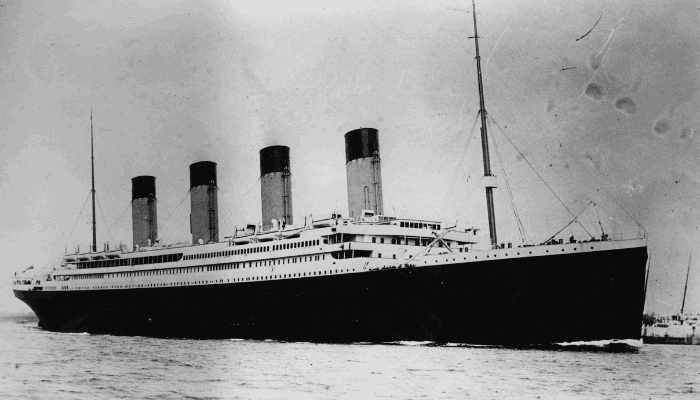
It was called unsinkable due to its 16 watertight compartments that could be closed in case of a collision. Sadly, the ship sank from Southampton to New York on its first voyage. It hit a massive iceberg in April 1912, near Newfoundland, Canada, and drowned three hours later, consuming 1500 of the 2208 people onboard. The chilly waters of the North Atlantic killed everyone from hypothermia before help could arrive.
Directed by James Cameron, the movie released in 1997 immortalized the ship disaster. The Titanic was almost 270 m long and 28.042 m broad. It had nine decks and a gross tonnage of 46,328 tonnes. It was equipped with only 20 lifeboats, enough for 1,178 passengers. Had there been more life crafts, precious lives could have been saved.
2. The Mighty, Costa Concordia
Costa Concordia sank due to a small mistake of the captain and one of the officers. It was a magnanimous passenger ship containing 17 decks, a three-storeyed theatre, swimming pools, gymnasiums, restaurants, and much more. The ship could accommodate over 4000 people.
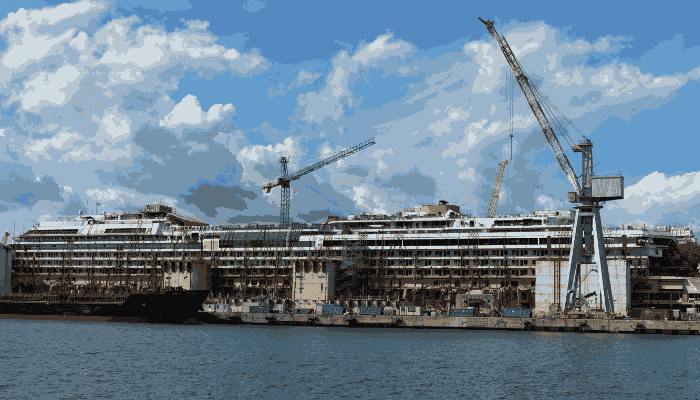
According to investigation reports, the vessel hit an underwater rock when it sailed pretty close to the shore of Isola del Giglio island on 13 January 2012. Captain Francesco Schettino closed the computer navigation alarm since he thought he could navigate the waters himself. Unfortunately, he left his glasses in his cabin, and the damage had been done by the time he got them.
The vessel capsized and sank near Tuscany. Despite the six-hour rescue operation, 34 people died. What’s shocking is that the captain abandoned the ship while 300 passengers were onboard, despite the Coast Guard Officer’s attempt to dissuade him. He was convicted of manslaughter and got a 16-year prison sentence in 2017.
3. The Graceful, MS Estonia
Cruise ferry MS Estonia was struck amidst bad weather in the Baltic Sea, which led to its demise. The ship was built in 1980 by Meyer Werft in Papenburg, Germany. It was known by many names like Viking Sally and Wasa King before 1993. It sank while sailing from Tallinn to Stockholm in September 1994.
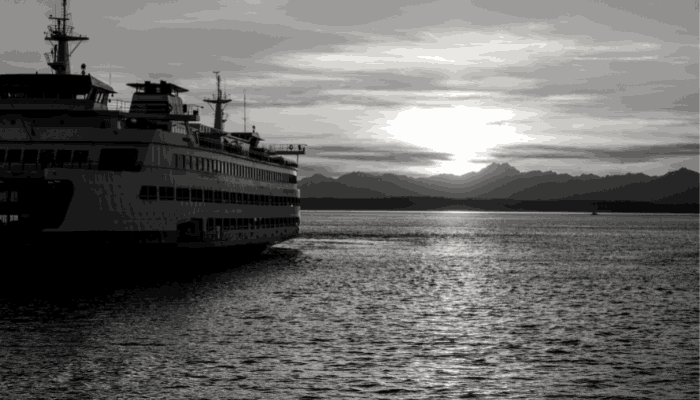
According to reports, it sank as its bow door locks couldn’t open during the storm, with strong winds lashing at a speed of 35 to 45 miles per hour. Hence, the ship tilted to the starboard side and later drowned completely due to excessive flooding on the car deck. The ship surged in an hour and took 852 people to the seabed. Only 137 passengers survived and were rescued.
MS Estonia was 155.43 m long and 24.2 m wide, with a 5.5 m draught and 15,598 gross tonnages. It had 9 decks and 10 lifeboats which were not enough for 2000 people. It could also carry over 410 cars.
4. RMS Lusitania
The German attack on Cruise Ship RMS Lusitania in 1915 was one of the main reasons behind the entry of the US into the First World War. It was hit as a naval vessel since it also contained military weapons for Britain.
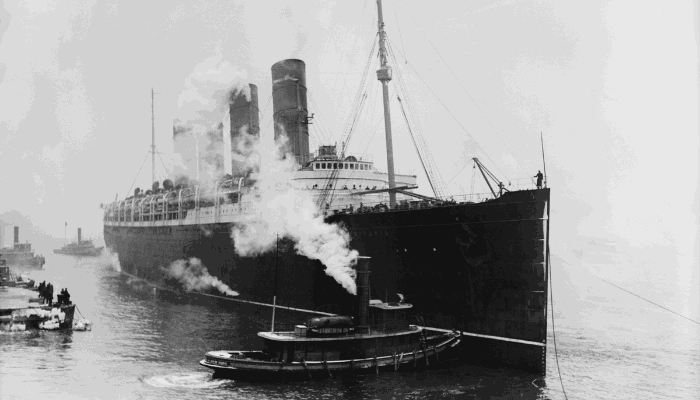
Military Submarine U-20 attacked the cruise while traveling to Liverpool from New York. Launched in 1906, the vessel was constructed by Jon Brown and Corporation and operated by Cunard Company.
The humongous steamship was the largest and most luxurious vessel at that time. It measured almost 240 m lengthwise and 27 m breadthwise, with a 10.2 m draft. The 31,550-tonne ship had 10 decks and a maximum sailing speed of 26.3 knots. It could easily carry 2160 people and over 800 crew. When it sank, 1201 people lost their lives, most Americans.
5. SS Andrea Doria
The SS Andrea Doria went down not because of rough seas or striking an iceberg or underwater formations. Instead, it collided with another passenger vessel called Stockholm due to misreading the radar. Hence, it is remembered as the world’s major radar-caused collision. The incident could not be averted as thick fog barred visibility.
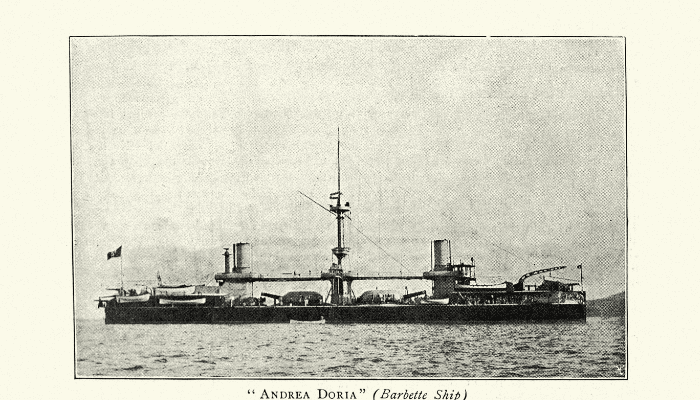
The disaster occurred in July 1956 off the coast of Nantucket, Massachusetts, when the liner was sailing to New York. Hit under the starboard bridge, it was engulfed by waves after 11 hours which gave nearby vessels enough time to respond to its SOS call. Over 50 people died, mostly due to the impact, and over 1650 were rescued.
Owned by Italian Line, it was constructed for a whopping 30 million US dollars. The 212 m long ship had 10 decks and powerful steam turbines, enabling it to attain a maximum speed of 23 knots.
6. SS Eastland
This passenger ship used for touring killed 844 people while it was docked in a port on the Chicago River on 24 July 1915. The vessel rolled over to its starboard side and submerged in water, trapping most passengers inside. It is one of the greatest ship accidents recorded in the history of the Great Lakes.
The accident occurred while the 2500 people were embarking on the vessel, preparing to cruise through Michigan. The possible causes of this disaster were structural flaws in its design, overloading, and inadequacy of the ballast tanks.
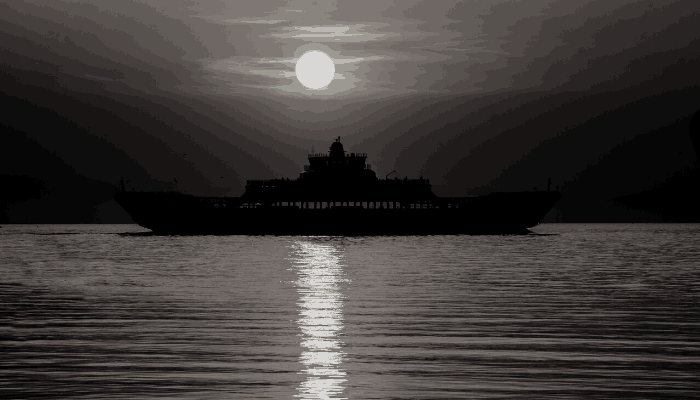
Later it was salvaged and handed over to the US Navy, which restored and modified it. It became a gunboat called USS Wilmette and was used for training. It was scrapped after the second world war ended.
It was launched in 1903 by the Michigan Transportation Company. the 275 m long cruise ship was equipped with 11 lifeboats and 37 life rafts. t had a top speed of 16.5 knots.
7. RMS Empress of Ireland
Ocean Liner Empress of Ireland was carrying 1477 passengers when it struck another Norwegian vessel, the 6000-tonne Storstad, due to poor visibility in the Saint Lawrence River. More than 1000 people died in May 1914, the second biggest cruise disaster of the period, following the Titanic incident.
The cruise ship followed the North Atlantic route between Liverpool and Quebec. Though it contained 42 lifeboats, only four could be launched in water as it tilted on her starboard side, causing panic and chaos onboard the ship. The harsh cold and the inability to close its watertight doors and portholes worsened the situation.
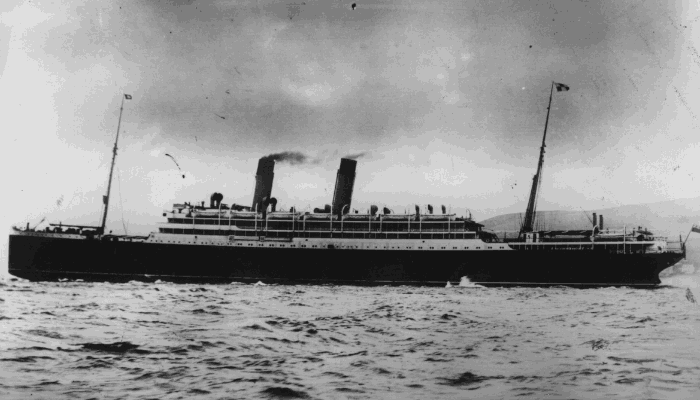
The 168 m long and 20 m broad cruise ship was launched in 1906. t was owned by the Canadian Pacific Steamship company and designed by Francis Elgar. Mirfield Shipping and Engineering were responsible for her construction.
It had 14,191 gross tonnages, two steam engines, and propellors, providing a top sailing speed of 20 knots.
8. SS Admiral Nakhimov
The collision of the cruise ship SS Admiral Nakhimov with the bulk carrier Pyotr Vasev was due to the carelessness of both the vessels’ captains. T e captain of the bulk ship failed to respond to the warning signals issued by the cruise ship. H was not present on the bridge when the vessel hit each other at 5 knots.
The cruise ship disaster occurred in 1986 in Tsemes Bay near Novorossiysk port when the vessel was en route to Sochi. I was carrying 1234 passengers, of which 423 died due to the collision and its aftermath.
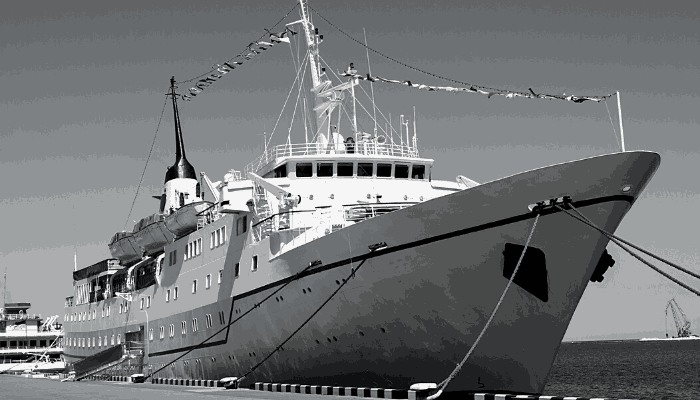
Initially named SS Berlin II, the cruise liner operated on the Crimean-Caucasian route. It was built by Bremer Vulkan and owned by Norddeutscher Lloyd.
The majestic ship had an overall length of 174 m, a 21 m beam, and 17,054 gross tonnes. It could conveniently accommodate 1125 passengers and over 300 crew members. It had a cruising speed of 16 knots.
9. SS Morro Castle
Cruise vessel SS Morro Castle was burned and sank in September 1934, claiming the lives of over 135 passengers and crew members. A total of 318 passengers and 239 crew were aboard the ship on its journey from Havanna to New York.
The accident occurred as the fire spread from its library to the decks and cabins, engulfing the superstructure in flames. I was aggravated by the ship’s decor, which was made of wood and other flammable material. The fire could not be controlled due to rough weather, incapable staff, and the ship’s design.
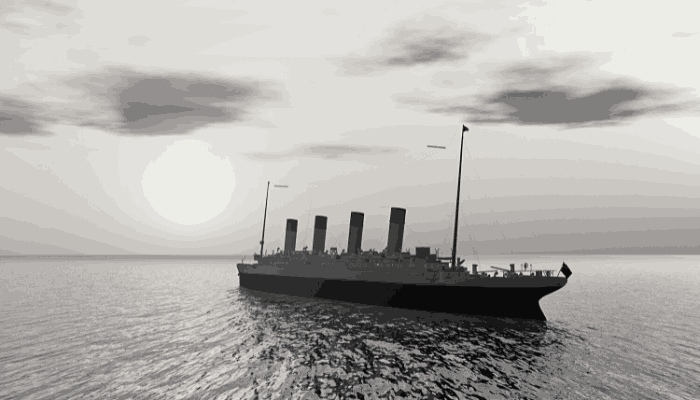
Only 12 lifeboats could be launched out of the several available on board. The decks burned the feet, and passengers leaped into ocean swells. The ship was abandoned by afternoon and the survivors were taken to the New Jersey Coast.
Interestingly, the previous evening, the ship’s captain, Robert Wilmott, died suddenly. T e Chief Officer took command and was worried about a strong northeast wind and dark clouds.
The exact cause of the fire remains a mystery; however, an overheated funnel and electric circuitry are blamed. T ose related to the incident, also speak of arson by a crew member.
It was owned by Agwi Navigation Co. and constructed in 1930. T e 155 m long cruise ship could carry 489 people apart from 240 crew at a speed of 20 knots.
10. Saint-Philibert
A small cruise ship sailing from Loire River, near the French coast, met with tragedy in June 1931. T e ship was carrying 500 people, mostly workers, and their children, from Nantes port. I exceeded its carrying capacity by 80 percent. T e danger was doubled when it encountered raging seas and rough weather, which was not precedented as it was the summer season.
The captain and crew members panicked as there was nothing to be done. O t of the 500 people onboard, only 8 survived the horrific accident. T e violent storm forced passengers to take shelter near machinery casings, which tilted the ship to its starboard side and it ultimately capsized when struck by a gigantic wave.
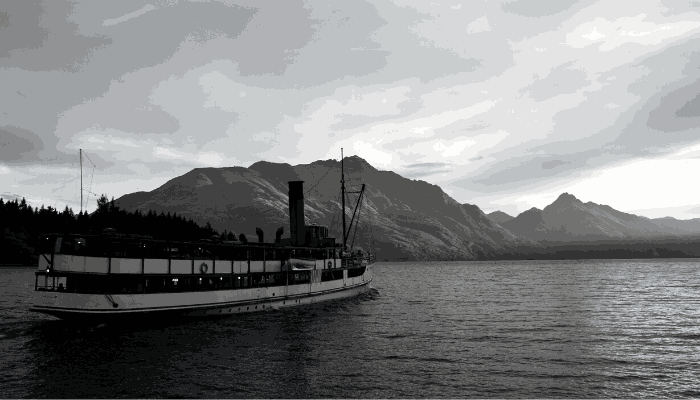
The ship was not equipped to face bad weather, and the captain and crew were not experienced. Appropriate communication equipment was also missing onboard the vessel.
A trial was conducted in 1933, the victims’ families lost the case, and the ship’s owners were set free without any penalties. The cruise vessel was 32 m long and 6.4 m broad with a gross tonnage of 189 tonnes.
You might also like to read-
- Titanic vs. Modern Cruise Ship: How Ships Have Evolved
- Costa Concordia Cruise Ship: Know The ill-fated Ship
- The Scenic Jewel Cruise Ship
- Ship Portholes: A General Overview
Top 10 Largest Cruise Ships in 2022
Disclaimer: The authors’ views expressed in this article do not necessarily reflect the views of Marine Insight. Data and charts, if used in the article have been sourced from available information and have not been authenticated by any statutory authority. The author and Marine Insight do not claim it to be accurate nor accept any responsibility for the same. The views constitute only the opinions and do not constitute any guidelines or recommendations on any course of action to be followed by the reader.
The article or images cannot be reproduced, copied, shared, or used in any form without the permission of the author and Marine Insight.
Do you have info to share with us ? Suggest a correction

Web Stories
Subscribe To Our Newsletters
By subscribing, you agree to our Privacy Policy and may receive occasional deal communications; you can unsubscribe anytime.

About Author
Zahra is an alumna of Miranda House, University of Delhi. She is an avid writer, possessing immaculate research and editing skills. Author of several academic papers, she has also worked as a freelance writer, producing many technical, creative and marketing pieces. A true aesthete at heart, she loves books a little more than anything else.
Leave a Reply
Your email address will not be published. Required fields are marked *
Subscribe to Marine Insight Daily Newsletter
" * " indicates required fields
Marine Engineering
Marine Engine Air Compressor Marine Boiler Oily Water Separator Marine Electrical Ship Generator Ship Stabilizer
Nautical Science
Mooring Bridge Watchkeeping Ship Manoeuvring Nautical Charts Anchoring Nautical Equipment Shipboard Guidelines
Explore
Free Maritime eBooks Premium Maritime eBooks Marine Safety Financial Planning Marine Careers Maritime Law Ship Dry Dock
Shipping News Maritime Reports Videos Maritime Piracy Offshore Safety Of Life At Sea (SOLAS) MARPOL

Tragic List: Discover How Many Cruise Ships Have Sunk Throughout History
How Many Cruise Ships Have Sunk: Millions of people choose cruise ships for their vacations every year because they provide opulent amenities, thrilling activities, and the chance to see several places in one journey. But sometimes people doubt these enormous floating hotels’ safety, especially when you consider that they might sink.
There have been very few cruise ships that have sunk in the past century. Because of the safety procedures followed by the cruise liner industry, most or all of the passengers and crew survive when a cruise ship sinks.
How Many Cruise Ships Have Sunk
Only twenty-four cruise ships—both river and ocean liners—have sunk since 1912. It’s important to remember that some cruise ship capsizings happen while the ship was being towed or berthed.
Because cruise ships are built sturdy and have current safety mechanisms, we can explain why there aren’t many cruise ship sinkings.
Today’s cruise ships are extremely resistant to sinking because of their emphasis on safety throughout construction. Modern cruise ships are outfitted with a plethora of safety precautions to preserve as many lives as possible in the event of an unfortunate disaster.
Consequently, the death toll from these kinds of incidents is usually rather low.
Sadly, several people lost their lives in some of the first sinkings.
Since 1912, a cruise ship has sunk an average of once every 4.5 years, underscoring how uncommon these incidents are. However, as safety and technology advance and we continue to learn from past tragedies, the number of cruise ship disasters is declining.
While cruise ship sinkings are uncommon, there have been a few famous cases, like the Titanic and the Costa Concordia catastrophe. However, despite these high-profile incidents, the cruise industry does have a remarkable overall safety record.
What percentage of cruise ships sink?
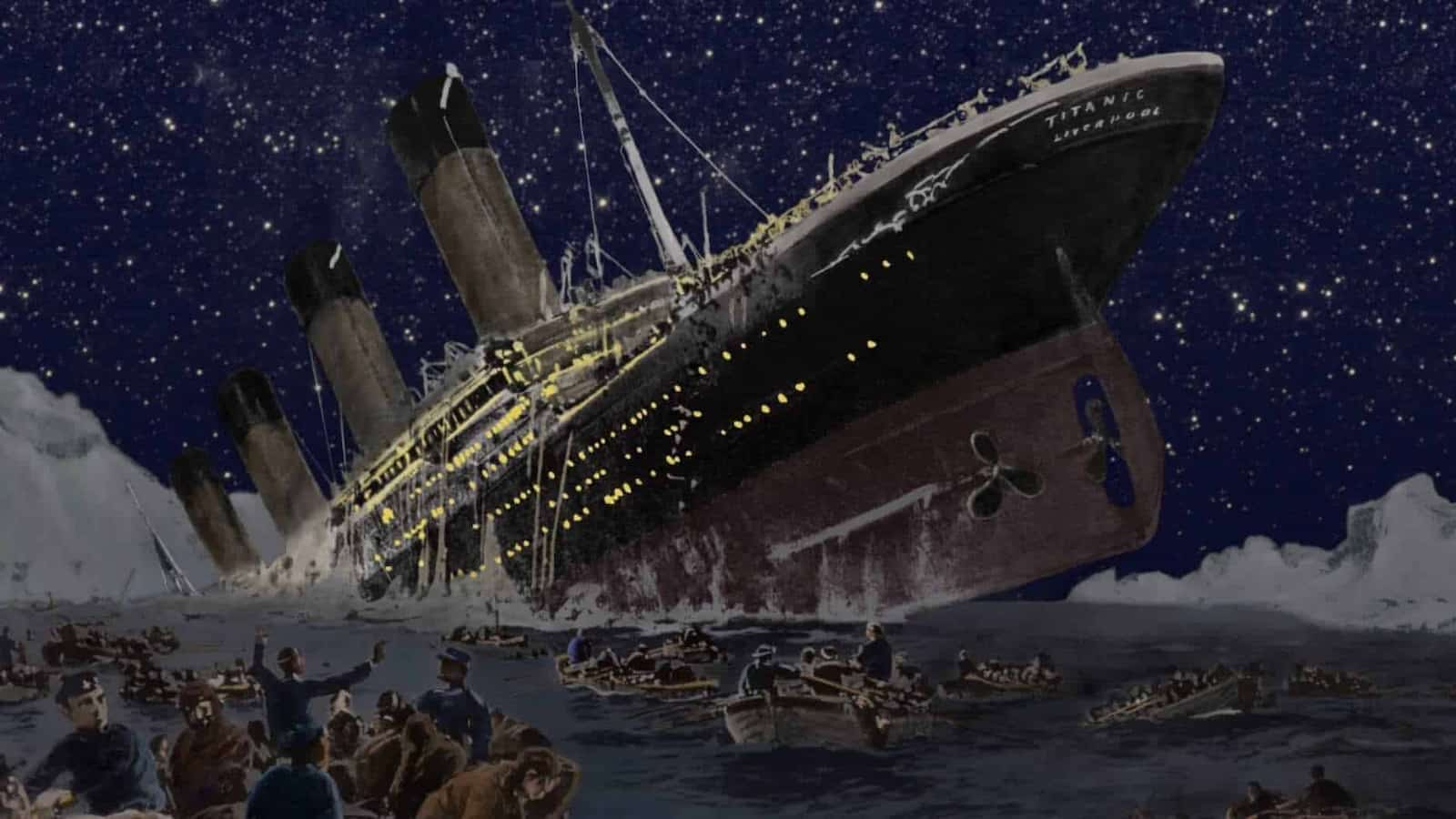
It’s critical to realize that cruise ship sinkings are quite uncommon. There have only been 22 cruise ship sinkings in the last 100 years.
Still, a number of shipwrecks happened while docked or being towed. Given the quantity of cruise ships that are in operation all year round, cruise ship sinkings are quite unusual.
Many safety precautions included into contemporary cruise ships reduce the possibility of a sinking. Strict rules and inspections also contribute to the high standard of safety that is maintained on these boats. Cruise ship sinkings are uncommon, which is partly due to these efforts and technological developments.
Cruise ship worker salary: How much do they make?
In contrast to this total, cruise ships in particular have an even lower frequency of sinking. Although it is difficult to pinpoint the exact number of cruise ship sinkings in the recent past, it is widely accepted that these incidents are uncommon and do not pose a serious threat to passengers.
In conclusion, the rarity of cruise ship sinkings can be attributed to stringent safety rules and contemporary technology. Travelers may relax knowing that their cruise ship experiences will be stable and safe.
Do Cruise Ships Sink Frequently?
Because of stringent restrictions and advanced safety systems, cruise ships seldom sink. In the last century, there have only been 20 cruise ship sinkings.
It is noteworthy that not all of these sinkings contained passengers or caused a sizable number of casualties.
The frequency of cruise ship sinkings has decreased due to advances in navigation technology.
Are Cruise Ships Capable of Sinking?
Cruise ships do occasionally sink, but this is extremely uncommon.
Contemporary cruise ships come with cutting-edge safety technologies that reduce the chance of capsizing. In addition, watertight compartments and improved hull construction keep a ship from absorbing too much water. Cruise ship crew members are also regularly trained in safety exercises and emergency procedures.
Despite these safety precautions, 24 cruise ships and ocean liners have sunk since the RMS Titanic disaster in 1912.
In spite of the disconcerting prospect of a cruise ship sinking, safety remains the cruise industry’s top priority. Compared to other means of transportation, passengers may travel with peace of mind on one of the safest modes.
When Did a Cruise Ship Most Recently Sink?
The last time a cruise ship capsized while carrying people on board was the Costa Concordia, which grounded in Italy in 2012. Thirty-four people perished when the Italian cruise liner struck rocks and subsequently capsized. The accusations made against the ship’s crew, especially Captain Francesco Schettino, who is currently serving a 16-year manslaughter term, made the incident noteworthy as well.
To provide the highest level of security for its patrons, the cruise industry has enacted a number of safety rules and procedures in recent years. These modifications have greatly decreased the quantity of mishaps and sinkings, which has helped to explain why we don’t hear about them as frequently.
Why Do Ships Stay Afloat?

Even while cruise ships, in particular, might be extraordinarily large buildings, their purpose is to float on water with ease. It is because of the buoyancy principle that cruise ships may float. Any object submerged in a fluid (such as water) experiences an upward force equal to the weight of the fluid the object has displaced. This is known as Archimedes’ principle, or the physical law of buoyancy.
The hull form of a ship is a major component that affects its buoyancy. Because of their wide, flat bottoms, ships are able to move a lot of water. This displacement produces an upward force that balances the ship’s weight.
If the density of the cruise ship is lower than that of the water, it will still float.
Steel and aluminum are two examples of strong, lightweight materials used in ships that offer structural support while maintaining a low overall density. In addition, the hull is separated into waterproof sections so that, in the event of damage, water does not flood the entire ship. This design keeps cruise ships from toppling over and aids in maintaining the ship’s buoyancy.
Preventing a ship from capsizing also depends on its stability. A low center of gravity is a feature of ship design. Heavy parts of the ship, including engines and fuel tanks, are located in the lowermost part of the structure to provide a low center of gravity. Even in choppy waters, the ship will stay upright and steady thanks to the design philosophy.
Best Cruises for Adults: 4 Perfect Cruise Lines for Adult Only experience
Overview of How Many Cruise Ships Have Sunk Throughout History
1912’s rms titanic.
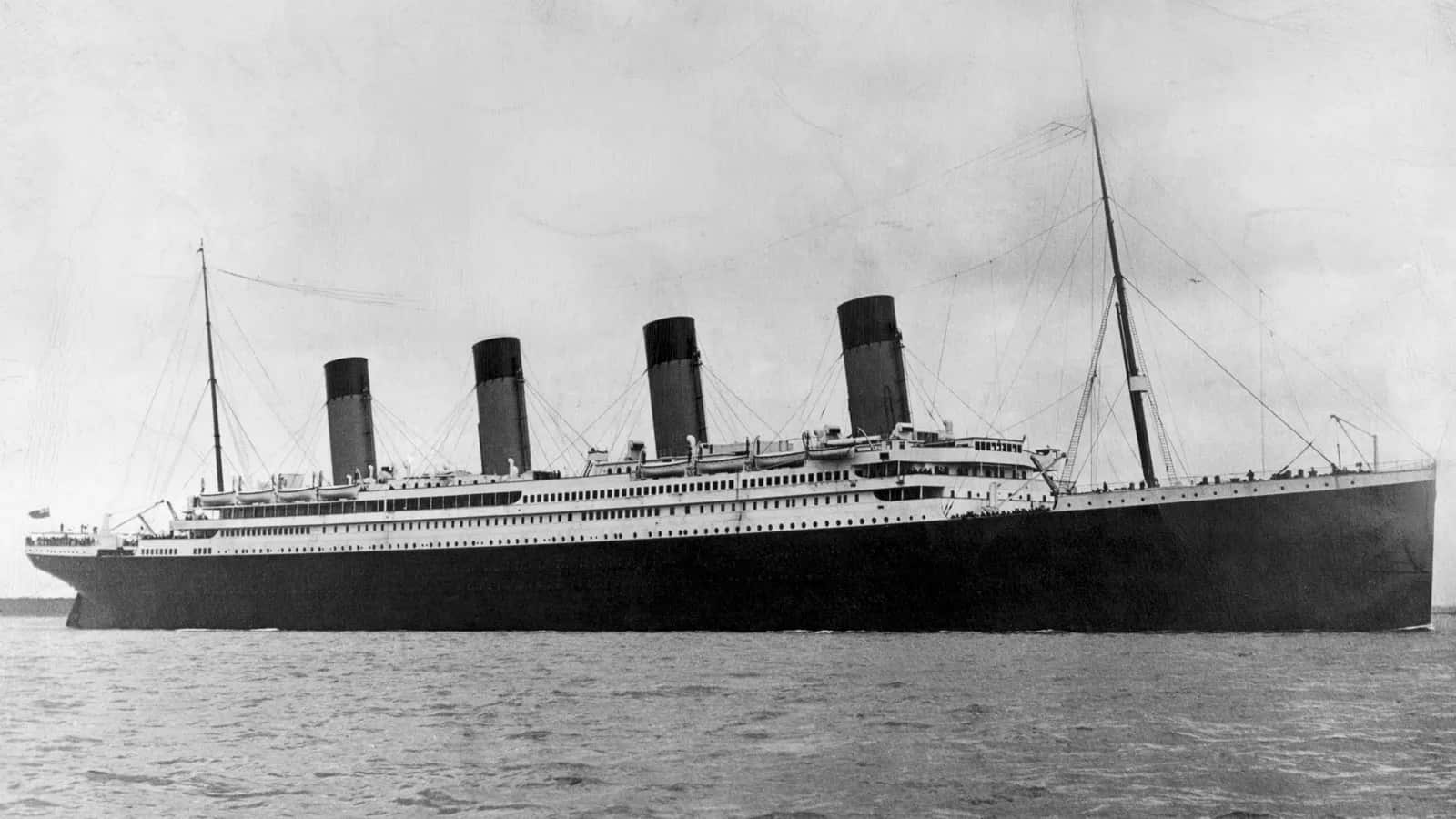
On April 15, 1912, the British passenger ship RMS Titanic sank in the North Atlantic Ocean. When the ship struck an iceberg on its first trip from Southampton, UK, to New York City, it sank. Out of the estimated 2,224 passengers and crew, 1,517 are thought to have perished in the accident.
The Titanic was regarded as an engineering wonder when it was built and was the largest ship ever to sail. With more than 2,200 passengers and crew members on board, she sailed for her maiden transatlantic voyage. Despite multiple alerts of icebergs up ahead on April 14, the Titanic proceeded to travel at a speed of 22 knots.
Lookouts noticed an iceberg on the ship’s course just before midnight. The Titanic suffered damage below the waterline when she met the iceberg on her starboard side due to her inability to turn quickly enough.
It was obvious the ship would sink when water began to fill it. There was a significant death toll from the Titanic accident because there were not enough lifeboats and the water was quite cold. Laws about maritime safety have significantly improved as a result of the disaster.
Empress of Ireland in 1914
Early on May 29, 1914, in the thick fog, the ocean liner RMS Empress of Ireland collided with another ship and sank in Canada’s St. Lawrence River.
There were 1,477 passengers and staff members on board the Empress as it traveled from Quebec City to Liverpool. The Norwegian collier Storstad struck the Empress, causing significant damage and rapid submersion. Despite hasty attempts to evacuate passengers, the ship sank in about fourteen minutes. The accident claimed 1,012 lives from those on board, making it the deadliest marine accident to occur in Canadian history during a peacetime.
1915’s RMS Lusitania
On May 7, 1915, during World War I, a German U-boat torpedo sank the British ocean liner RMS Lusitania, killing 1,198 people—passengers and crew. The Cunard Line-owned Lusitania was torpedoed off the coast of Ireland when it was making her 202 transatlantic voyage from New York to Liverpool.
A second explosion burst from the ship’s hull shortly after the torpedo hit. Due to the significant damage and degree of listing, only six lifeboats were able to descend from the starboard side of the ship.
The ship sank around eighteen minutes after the torpedo hit. Seventy-six out of the 1,962 passengers and crew on board the Lusitania made it out alive.
The RMS Lusitania was allegedly carrying 173 tons of weapons and ammunition, according to the German authorities. Apart from the small arms ammunition listed on the ship’s military cargo, the British government disputes that the ocean liner carried any war weaponry.
1916’s HMHS Britannic
HMHS Britannic was the third and largest Olympic-class ocean liner that White Star Line operated. Constructed as a transatlantic passenger liner, the ship was launched shortly before the outbreak of World War I.
Before Britannic could be used for passenger travel following the start of the war, the British Admiralty seized her and renamed her Britannic as a hospital ship. The Britannic ran into a naval mine that a German U-boat had planted while it was in the Aegean Sea in November 1916.
In approximately 55 minutes, the explosion destroyed much of the ship and caused serious damage. Despite the sinking’s rapid pace, the prompt evacuation saved 1,030 lives. 30 persons sadly lost their lives in the sinking.
1927’s Principessa Mafalda
Off the coast of Brazil in 1927, the Italian transatlantic liner SS Principessa Mafalda sank. The ship departed on her 14-day voyage after a technical delay.
The ship made multiple stops in the ocean during the voyage, indicating that it was not in good shape. The breakage of the starboard propeller shaft on October 25 resulted in numerous hull gashes.
The ship started to absorb water, and the watertight doors could not be closed all the way. It took the ship more than four hours to sink completely. However, miscommunication resulted in 314 fatalities.
1932-Georges Philippar
In 1932, the French passenger liner Georges Philippar caught fire and sank in the Gulf of Aden, killing fifty-four people. On May 16, during her inaugural journey off the coast of Italian Somaliland, Mme Valentin’s opulent cabin’s wood paneling caught fire due to a malfunctioning light switch.
The fire was allowed to spread quickly since there was a delay in reporting it. Captain Vicq tried to put out the fire and beach the ship, but things worsened.
The engine rooms were evacuated, leaving the Georges Philippar adrift. The captain issued a distress call and told the crew and passengers to get off the ship. The French ship Andre Lebon, the two British cargo ships Mahsud and Contractor, and the Soviet tanker Sovietskaïa Neft were the three neighboring vessels that came to the rescue.
Rescuers were able to save 698 people. 54 people died, nevertheless, some of them from desperate jumps overboard.
1934’s SS Morro Castle
On September 7, 1934, at around three in the morning, a fire broke out on board the opulent ocean liner SS Morro Castle, which was traveling from Havana to New York City. Strong winds contributed to the fire’s rapid out-of-control spread.
Chaos broke out as terrified passengers had to decide whether to leap into the sea or stay on the blazing ship, even as efforts were made to put out the fire and launch lifeboats. The ruined Morro Castle ran aground close to Asbury Park, New Jersey, after only six hours.
Only 312 of the 549 occupants, including the crew, made it out alive.
Following investigations, it became clear that a lack of training and preparation for fire safety contributed to the shockingly high death toll. The burned-out wreck, which served as a somber reminder of the horror everyone on board had to endure, remained on the beach until 1935.
The fatal incident made it clear that ocean liners need to strengthen their fireproofing, safety exercises, and crew training.
Empress of Britain – 1940
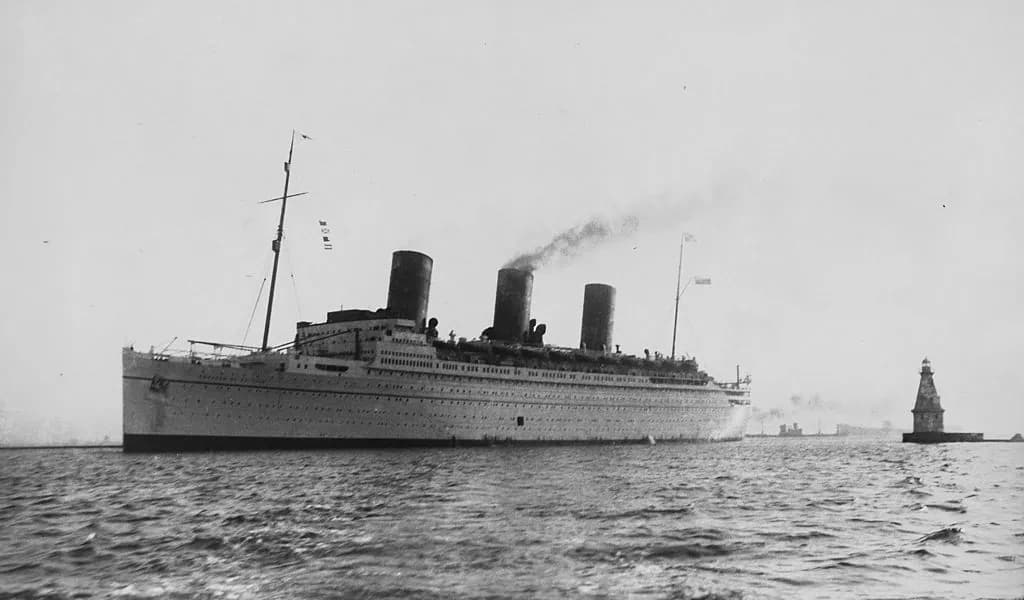
The Canadian Pacific Steamship Company, which the Canadian Pacific Railway and the RMS Empress of Britain owned, transported people and soldiers across the Atlantic during World War II.
The German submarine U-32 fired two torpedoes at the Empress of Britain early on October 26, 1940, as it was cruising roughly 450 miles west of Ireland. The damage was too great, leading the ship to list badly in spite of efforts to prevent flooding.
Lifeboats were hastily lowered into the darkness after the order to evacuate the ship, with some capsizing in the confusion as flares lit up the sky. British navy ships saved 1,259 people from the sinking liner, but 45 unfortunate people perished in the early explosions or drowned.
The graceful British Empress had disappeared under the seas by sunrise, exposing civilian ships to Germany’s merciless submarine warfare techniques.
Andrea Doria – 1956
In July 1956, the Italian ocean liner SS Andrea Doria carried more than 1,700 passengers and crew members on a normal trip from Italy to New York. In extremely foggy conditions, the Andrea Doria and the Swedish ship Stockholm collided on July 25, off the coast of Nantucket, Massachusetts.
Below the waterline, the Stockholm’s bow caused catastrophic damage by severing passenger compartments and stabbing into Andrea Doria’s side. Ten hours later, in excess of 200 feet of water, the mortally damaged Andrea Doria sank in spite of attempts to contain flooding.
Thankfully, 1,660 individuals made it out of the lifeboats. Nevertheless, 46 people died as a result of impact injuries and drowned during the intense crash.
How Cruise Ships Are Built: A 2-Year Process
1961’s Bianca C
The ship Bianca C is special since it sank twice. The first sinking occurred during World War II when a German-operated passenger ferry was sunk.
Before it sank in 1961, the ship’s hull was lifted and converted into a cruise liner.
With more than 600 passengers and crew, the Italian cruise liner Bianca C sailed from Grenada to Italy overnight on September 22, 1961. An explosion in the engine room at midnight caused a fire that swiftly spread throughout the ship.
The captain gave the order for the staff and passengers to leave the burning ship as smoke filled the halls. As other ships raced to help, liferafts and lifeboats were lowered into the murky tropical waters. While the majority of passengers safely evacuated the Bianca C, one staff member unfortunately perished in the explosion. However, the crew and all other passengers made it out safely.
1979 Angelina Lauro
In March 1979, Costa Lines acquired the aging Italian ocean liner Angelina Lauro. When the new cruise line was chartering the ship, it caught fire while berthed in Saint Thomas.
After burning for a few days, the ship was declared completely destroyed. The fire did not claim any lives.
1986’s MS Mikhail Lermentov
Around 1,000 guests and crew perished when the Soviet cruise ship Mikhail Lermentov struck rocks and sank off the coast of New Zealand on February 16, 1986. During the frantic evacuation, the chief electrical engineer sadly drowned, although no passengers were lost.
In a matter of hours, rescue ships and aircraft safely evacuated everyone else on board the sinking ship before it submerged beneath the water. A subsequent investigation found that inadequate navigation had caused the enormous ship to veer dangerously near the rocky reef in low light, rupturing a huge hole in the hull and quickly flooding the liner.
1986’s SS Admiral Nakhimov
On our list, SS Admiral Nakhimov has the most intriguing tale. The ship has sunk three times in total.
It served as a hospital ship for Germany during World War II before being lost.
The ship was turned up to the Soviet Union as payment for reparations. The Germans had hidden mines in the ship’s hull, which detonated and caused the ship to sink a second time, despite Soviet attempts to retrieve its hull.
On August 31, 1986, the SS Admiral Nakhimov sank for the third and last time. In the Black Sea, close to the Strait of Kerch, the Soviet passenger liner and the bulk freighter Pyotr Vasev collided. Admiral Nakhimov’s hull sustained a huge hole from the accident, which quickly caused the ship to flood.
When the electricity went out, the evacuation process became disorganized due to a lack of lifeboats and inadequate leadership. The Admiral Nakhimov sank after capizing in thirty minutes. Sadly, more than 423 people perished.
1988’s MV Jupiter
The British roll-on/roll-off ferry MV Jupiter and the tanker Phoenix II collided on June 21, 1975, as the two were traveling from Dover to Zeebrugge across the English Channel. The accident caused catastrophic flooding by rupturing open the car deck of the MV Jupiter.
The majority of the 585 passengers and crew were evacuated as the Jupiter began to list alarmingly. Tragically, two passengers—a teacher and a student—as well as two crew members perished.
1988 Achille Lauro
As the Italian cruise ship Achille Lauro sailed off Somalia on November 30, 1994, a destructive engine room fire broke out and swiftly got out of control. Tragically, during a nocturnal emergency evacuation, two passengers perished.
Rescue ships and aircraft were able to successfully evacuate all remaining passengers and crew from the burning liner. The ship sank following two days of fierce firefighting.
An engine room explosion was found to be the cause of the safety systems’ deactivation.
MTS Oceanos – 1991
The Greek cruise liner Oceanos sank off the coast of South Africa on August 3, 1991, as a result of severe waves that broke a ventilation pipe. It’s thought that a poor repair made the pipe susceptible to impacts.
A broken ventilation pipe was to blame for the severe flooding. The captain and a few other crew members left the ship as soon as they realized it was sinking.
Amazingly, the entertainment crew stepped up and assisted guests in getting off the sinking ship. Over the following two days, nearby vessels saved all 571 people.
Sun Vista (1999)
The Sun Vista, a cruise liner from Malaysia, capsized in the Malacca Strait on August 8, 1999, due to extreme listing caused by an engine room fire that took off power. The well-trained crew quickly boarded lifeboats with all of the passengers and crew after making a call for assistance from nearby ships.
SeaBreeze (2000)
A catastrophic mechanical failure caused the cruise ship Seabreeze I to swiftly sink on December 17, 2000, when it was sailing about 225 nautical miles off the coast of Virginia. The 21,000 GT, 9-deck passenger ship had just been purchased by Cruise Ventures III, who was traveling from Halifax to Charleston when the catastrophe occurred.
According to reports, the boiler broke away, seriously injuring the engine room of the ship and resulting in significant flooding. The captain yelled “abandon ship” as the 40-year-old Seabreeze quickly began to take on water, requesting that the 34 crew members be rescued right away.
There was a lot of suspicion surrounding the sinking since some people thought it was intentional. The old Seabreeze had a $20 million insurance policy even though its scrap value was probably about $5–6 million.
The vessel capsized in international seas. Maritime authorities questioned Panama’s thoroughness and were dismayed when the ship, which was flying the flag of another country, sank in international waters. This placed Panamanian jurisdiction over the probe.
The captain’s decision to abandon the ship rather than try to salvage it also raised suspicion.
Rescuers from the US Coast Guard thought it was extremely unusual that the ship could sink that quickly. The captain insisted on a full evacuation instead of asking for salvage tugs, which shocked the Coast Guard.
Britannis (2000)
The Britanis experienced a leak in the ship’s rear while en route to an Indian scrapyard. The boat’s owners let it sink after determining that fixing the leak would be too expensive.
The boat was being pulled by tug boats with no one on board. Additionally, no one was hurt in the incident.
2007’s MS Sea Diamond

Sea Diamond sank on April 5, 2007, after going off course and hitting coral near Santorini. When the ship lost power and listed, the crew quickly rescued nearly all 1,195 passengers.
Tragically, two passengers perished in the sinking. The damaged Sea Diamond had submerged in 500 feet of water by the afternoon.
The captain was first accused of veering dangerously near to shore during the investigation; however, it was later found that the area’s maritime charts were erroneous. The boat came aground 131 meters from shore, while the reef was shown on the map as 57 meters.
2007’s MV Explorer
The cruise ship MV Explorer struck an iceberg early on November 23, 2007, causing it to sink off the coast of Antarctica. The iceberg tore open the ship’s hull, resulting in catastrophic flooding.
The well-trained crew quickly evacuated all 154 passengers and crew members onto lifeboats as the crippled ship lost power and leaned precariously close to King George Island. A great emergency reaction saved every life in the dramatic sinking in icy Antarctic waters.
After a five-hour drift on the lift rafts, MS Nordnorge recovered all 154 survivors.
2012’s Costa Concordia
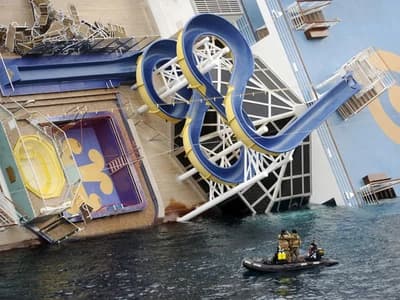
On January 13, 2012, the Costa Concordia cruise ship was wrecked off Giglio Island, Italy. Leaving Civitavecchia in Lazio, the ship, carrying 4,252 people from all over the world, struck a reef during an unofficial salute to local islanders. The Costa Concordia crashed off the Italian island of Giglio on January 13, 2012, killing around 4,252 passengers and crew. A 951-foot cruise liner veered off course and approached too closely.
The impact that ripped a 160-foot gash in the hull led to significant listing and partial sinking.
Despite the ship’s lifeboats, helicopters, and ships, 34 people died in the chaotic aftermath.
Captain Francesco Schettino caused the incident by carelessly deviating from the course. Authorities convicted him of manslaughter and he is currently serving a 16-year prison sentence.
2016’s Ocean Dream
After the owner of the cruise ship went bankrupt in 2015, the Ocean Dream was abandoned without a crew or maintenance personnel at Laem Chabang, Sri Racha, Thailand. In February 2016, the abandoned ship overturned and sank in shallow waters off the coast.
There were unsuccessful attempts to raise the sunken ship. The authorities decided to disassemble and demolish the Ocean Dream on location instead of refloating it. By the end of 2019, the disaster’s visible remnants had been disassembled and salvaged, leaving only the bottom hull of the wreck on the seafloor.
2020’s Orient Queen
The cruise ship Orient Queen suffered terrible damage 1,000 feet away from the big 2020 explosion that tore through Beirut’s dock. The strong blast wave severely damaged the Orient Queen’s hull, which also caused fires to spread, killing two crew members and injuring seven others.
The abandoned cruise ship capsized where it was parked, terminating its 40-year cruise career over the following 48 hours. It was not possible to salvage it.
Related Posts
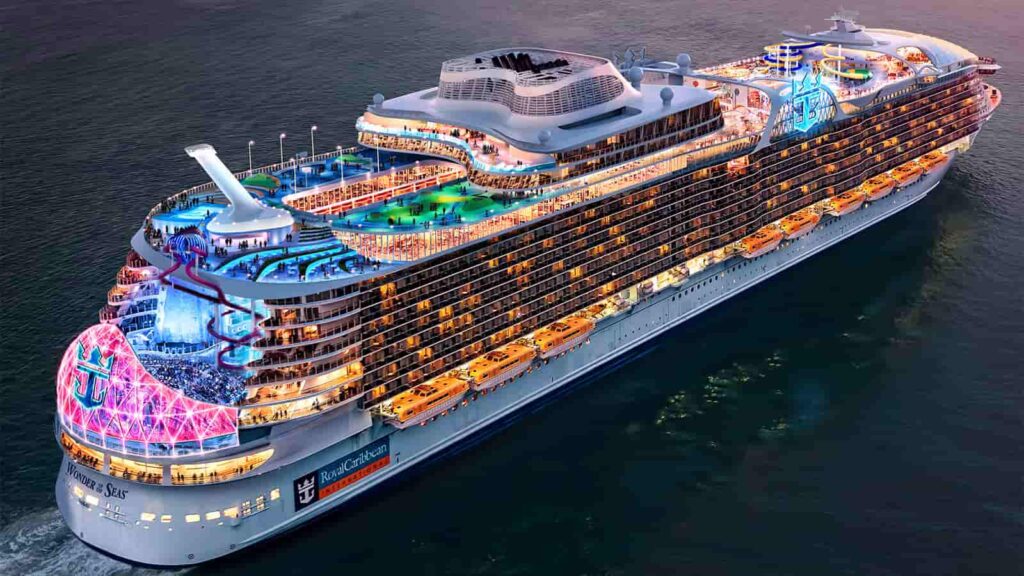
Royal Caribbean Cruises, History, Destinations and Itineraries

Ambassador Cruise Line: Ownership and History
Leave a comment cancel reply.
Your email address will not be published. Required fields are marked *
Save my name, email, and website in this browser for the next time I comment.

How Many Cruise Ships Have Sunk?
The thought of a cruise ship sinking conjures images of historic maritime tragedies, sparking curiosity and concern among modern travelers.
Despite the advancements in safety and technology, the question lingers in the minds of many: How many cruise ships have actually sunk? In this article, we dive deep into the annals of maritime history and safety records to uncover the truth.
By examining the rare instances of cruise ship sinkings, we’ll provide perspective on the safety of cruising today.
Whether you’re a maritime history enthusiast or planning your next vacation at sea, understanding these incidents sheds light on the impressive safety standards that protect millions of passengers each year.
The Titanic Tragedy (April 1912)
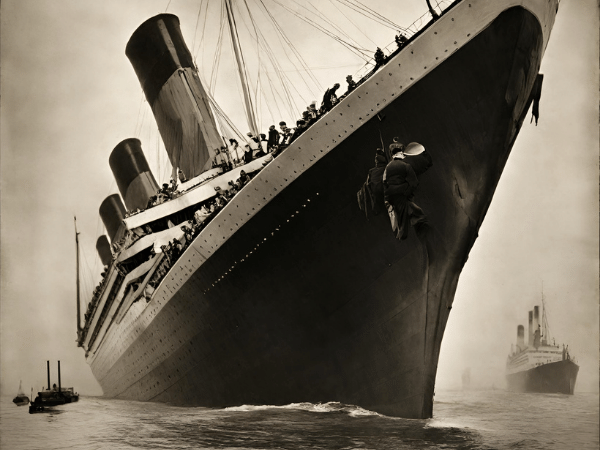
The Titanic’s sinking is one of the most well-known maritime disasters. On its first trip across the Atlantic Ocean, the ship hit an iceberg on the night of April 14, 1912. In just over two and a half hours, the Titanic was completely underwater. Sadly, most passengers couldn’t evacuate safely because there weren’t enough lifeboats for everyone.
The disaster led to more than 1,500 deaths, making it one of the deadliest incidents at sea. The freezing waters made survival even harder for those who couldn’t get on a lifeboat. The Titanic’s sinking is remembered as a tragic event in maritime history.
The Empress of Ireland Tragedy (May 1914)
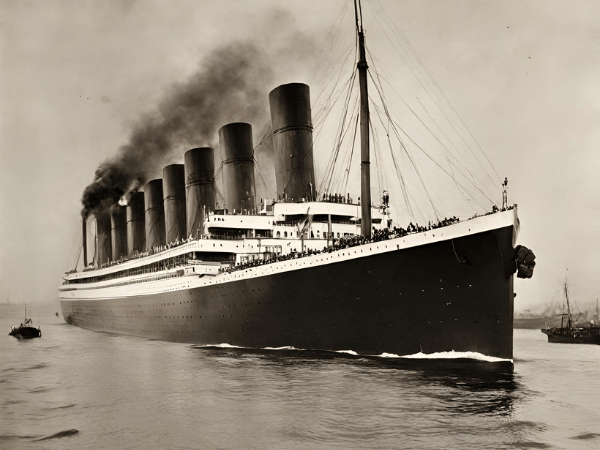
Just two years after the Titanic sank, the Empress of Ireland had its own tragic accident. In May 1914, this ship with nearly 1,500 passengers hit the Norwegian ship Storstad. They could see each other earlier, but then fog made it hard to see.
The crash caused 1,012 passengers and crew to lose their lives. The Empress of Ireland was close to making 1,000 trips without any problems, but this was not one of them. This accident is another sad event in the history of ships at sea.
The Sinking of the Lusitania (May 1915)
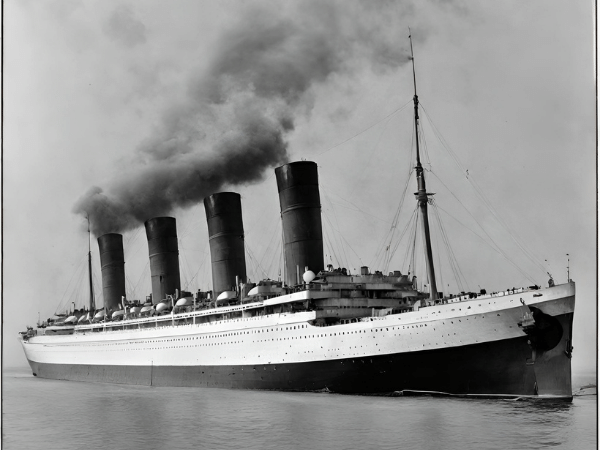
Cunard Line has been operating ships since 1940 and is still active today. One of its famous ships is the Queen Mary 2, the last ocean liner still in service.
The RMS Lusitania, built for Cunard Line, was the world’s largest passenger ship for three months. On May 7, 1915, while sailing off the coast of Ireland to Liverpool, England, a German U-Boat torpedoed the Lusitania. The ship started to sink faster than expected, and only six lifeboats could be launched.
Nearly 1,200 people died in the sinking of the Lusitania. This event is remembered as one of the major maritime tragedies of the early 20th century.
The Britannic’s Fate (November 1916)
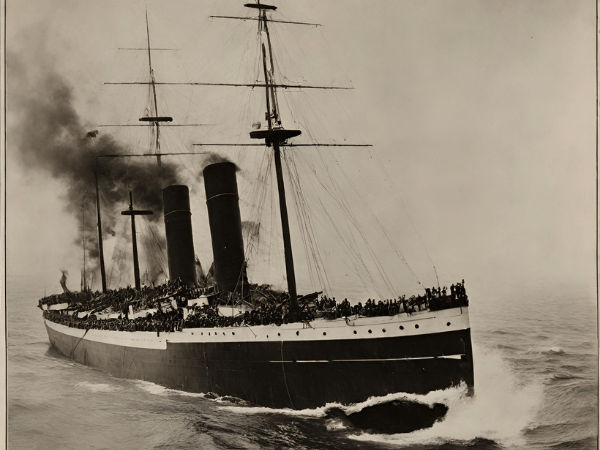
The Britannic was the younger sister of the Olympic (1911) and Titanic (1912). Although intended to be a passenger ship, the outbreak of World War I changed her purpose. She became a hospital ship in December 1915.
In November 1916, less than a year into her service, the Britannic hit a German naval mine in the Kea Channel between the Greek islands of Kea and Makronisos. She sank 55 minutes later.
Fortunately, the casualties were minimal. Most people on board managed to escape on the 35 lifeboats that were launched. However, around 30 people still lost their lives in the sinking of the Britannic.
The Sinking of the Principessa Mafalda (October 1927)
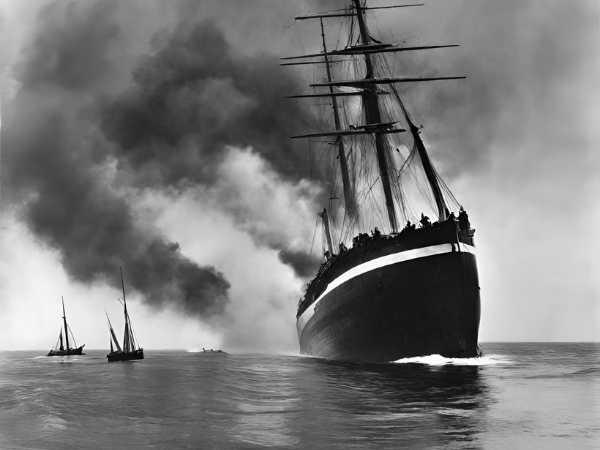
The Principessa Mafalda was an Italian ship named after a princess. It started sailing in 1909 between Genoa, Italy, and Buenos Aires, Argentina.
In October 1927, the ship had a big problem when its propeller shaft broke, damaging the bottom of the ship. It sank off the coast of Brazil, and sadly, more than 300 people died.
The Saint-Philibert Tragedy (June 1931)
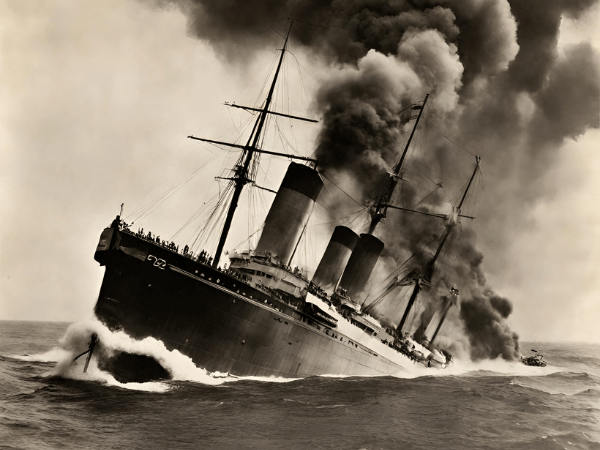
The Saint-Philibert, a small cruise ship, capsized and sank on June 14, 1931, off the coast of France. This tragic event led to the loss of nearly 500 lives, with only 8 passengers surviving.
Before this disaster, the Saint-Philibert was known for offering summer voyages along the French coast.
Check out: What Cruise Can You Go on Alone at 18?
The Sinking of the Georges Philippar (May 1932)
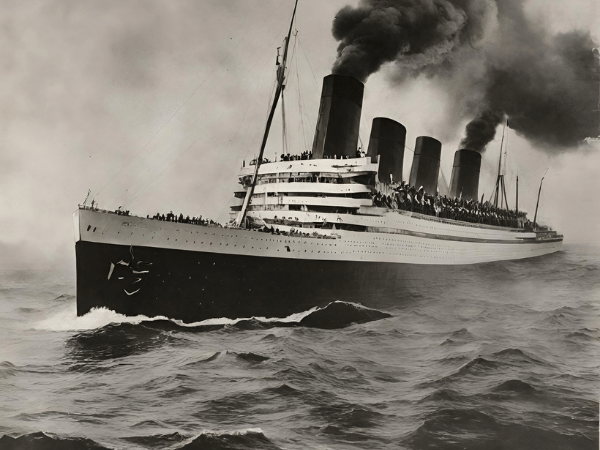
The French ocean liner Georges Philippar sank on the second leg of her maiden voyage near present-day Yemen, resulting in the loss of 54 lives.
The sinking was caused by an electrical fault. A fire started in one of the luxury cabins due to a faulty light switch that sparked and set the wood paneling on fire.
Before setting sail, there were worries about the ship’s safety. The ship’s launch was almost delayed to fix defects. However, these concerns were ignored to avoid penalties for delays.
The Tragedy of the SS Morro Castle (September 1934)
The SS Morro Castle, an American ocean liner operated by Ward Line, was traveling from Havana, Cuba, to New York City when it caught fire and ran aground on September 8, 1934.
The night before the disaster, Captain Robert Rennison Willmott, the ship’s captain, suddenly died after complaining about a stomach ache. Command of the ship was then passed to Chief Officer William Warms.
There were 137 casualties in total. Much of the blame was placed on the crew for not handling the emergency properly. Although the lifeboats could hold up to 408 people, they were launched with only 85.
The Sinking of the Empress of Britain (October 1940)
The Empress of Britain, an ocean liner of over 42,000 gross registered tons, holds the sad record of being the largest ocean liner sunk during World War II, and also the largest ship sunk by a U-Boat during the conflict.
On October 26, she was first bombed from above, then sunk by a torpedo launched by German U-Boats on October 28.
Most of the 416 crew members, 2 gunners, and 205 passengers managed to abandon the ship, leaving few people on board. In total, 45 people lost their lives in this tragic event.
The Collision of Andrea Doria and MS Stockholm (July 1956)
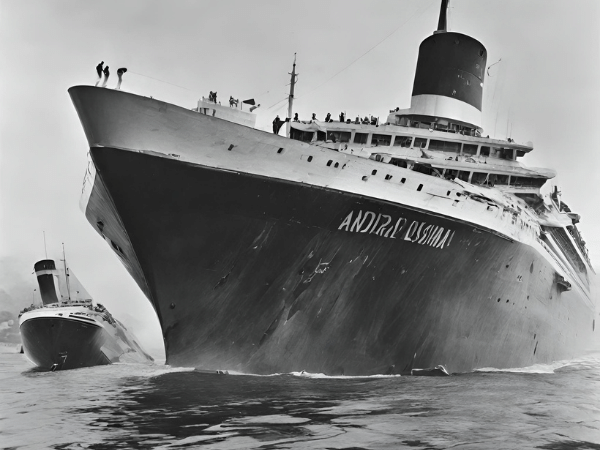
On July 25, 1956, the Andrea Doria and the MS Stockholm collided while on their way to New York City. The accident resulted in 51 deaths. However, this event is also known for one of the largest rescues in maritime history.
Thanks to improved communication systems, the crew of the Andrea Doria was able to quickly start rescue efforts and get help from other ships. Only five people died on board the Stockholm.
The damage to the Andrea Doria was so severe that the ship could not be saved. Those who lost their lives did so because of the initial collision.
The Story of the Bianca C (October 1961)
The Bianca C first sank during World War II when the Germans scuttled her before she was completed. Later, her hull was raised and refitted to become a cruise ship. She was first owned by Panama’s Arosa Line as their flagship but was eventually sold to Costa Line, where she got the name Bianca C after the owner’s daughter.
On October 22, 1961, while docked off the coast of Grenada, an explosion in the ship’s engine room led to fires breaking out. Thankfully, except for one person killed in the initial explosion, everyone was able to evacuate the ship before it sank.
The Journey and End of the Angelina Lauro (September 1979)
The Angelina Lauro didn’t always serve as a cruise ship. She started her journey in 1939 as the MS Oranje. Initially meant to be a passenger ferry, she was kept in Indonesia and turned into a hospital ship. After World War II, she sailed as a passenger liner for around 11 years, making trips around the world from Amsterdam to Australia through the Panama Canal and back via Singapore and the Suez Canal.
In 1964, she was sold to Lauro Lines and refitted as a cruise ship. She embarked on her maiden voyage as the Angelina Lauro on March 6, 1966. In the late 70s, Costa Lines chartered her.
While docked in Saint Thomas, the Angelina Lauro caught fire. The blaze lasted for several days. Before she could be towed to a scrapyard, her weakened hull began to take on water. She finally sank on September 24, 1979.
The Sinking of the MS Mikhail Lermontov (February 1986)
The MS Mikhail Lermontov was an ocean liner operated by the Soviet Union’s Baltic Shipping Company, entering service in 1972. A decade later, it was upgraded to serve as a cruise ship.
On February 6, 1986, the ship left Sydney for a two-week cruise around New Zealand. Ten days into the journey, while sailing past Cape Jackson, it hit rocks. Out of the 743 crew and passengers on board, the majority managed to escape on lifeboats. Tragically, there was one casualty: crew engineer Pavel Zagladimov.
The Tragic Collision of the SS Admiral Nakhimov (August 1986)
The SS Admiral Nakhimov started its journey in 1925 as the SS Berlin, a passenger liner of the German Weimar Republic. It later served as a hospital ship before becoming a Soviet Union passenger ship.
In August 1986, the ship met a tragic end when it collided with another ship in Tsemes Bay. The ship sank quickly, and sadly, 423 people lost their lives in the incident. This marked the third and final time that the ship sank.
The Sinking of MV Jupiter (October 1988)
The MV Jupiter, a Greek cruise ship, started sailing in 1961 as the Moledet. On October 21, 1988, it sank after leaving Piraeus, Greece. An Italian freight ship hit it.
The ship had nearly 400 British students, 84 adults, and 110 crew members on a study cruise. Sadly, one student, one teacher, and two crew members died. About 70 others were injured.
The Sinking of MTS Oceanos (August 1991)
The MTS Oceanos, another Greek ship, sank three years after the MV Jupiter. It was traveling from South Africa to Durban when rough seas hit. A storm made things worse.
The ship’s waste system wasn’t fixed right. A key pipe wasn’t replaced. It’s thought that huge waves broke the pipe, letting seawater flood in.
No one died, but the captain and crew were found guilty of leaving without helping passengers. The ship’s entertainers led all rescue efforts.
The Sinking of MS Estonia (September 1994)
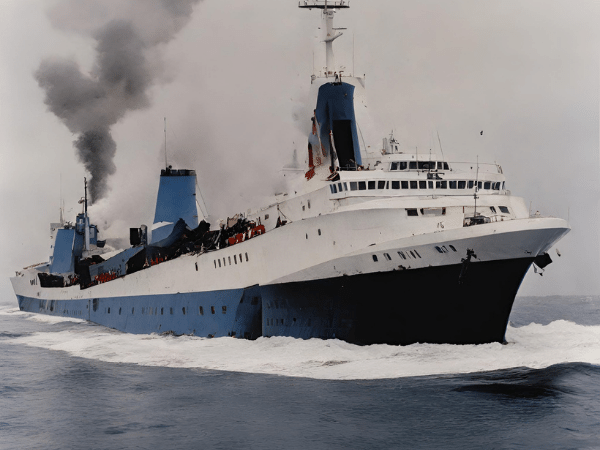
The sinking of the MS Estonia in 1994 was one of the worst maritime disasters of the 20th century. It was the deadliest peacetime sinking of a European ship after the Titanic and the Empress of Ireland. Over 850 lives were lost.
While sailing through rough waters in the Baltic Sea, a metallic bang was heard. Soon after, passengers and crew reported similar sounds. Around 1:15 am, the visor separated, opening the loading ramp and causing the ship to list as water flooded in.
It was difficult for those in cabins to reach the boat deck. Water was entering the ship through the car deck and the windows of public areas and cabins on Deck 6.
The Achille Lauro Incident (December 1994)
The Achille Lauro, originally the ocean liner Willem Ruys, was converted into a cruise ship by Italian businessman Achille Lauro in 1965. It had a series of unfortunate events, including collisions and onboard fires.
In 1985, the ship was hijacked by members of the Palestine Liberation Front. On November 30, 1994, the Achille Lauro caught fire while sailing to South Africa. There were 979 passengers and crew onboard. The majority evacuated the next morning when the ship listed, but two people were killed before it sank on December 2.
The Final Voyage of the Sun Vista (May 1999)
The Sun Vista started its journey in 1963 as the SS Galileo Galilei for the Lloyd Triestino line. Over the years, it sailed for five different cruise lines, including as the first-ever cruise ship for Celebrity Cruises, the Meridian. In 1997, it was transferred to Sun Cruises and renamed the Sun Vista.
On May 20, 1999, a fire broke out in the ship’s engine room. The Sun Vista sank in the early morning hours of May 21 in the Strait of Malacca. Fortunately, all passengers and crew were able to escape safely.
The Sinking of the Britanis (October 2000)

The Britanis began its life as the luxury ocean liner SS Monterey in 1932. It later sailed for Chandris under their “Fantasy Cruises” division starting in February 1971. When Chandris shifted focus to the Celebrity Cruises brand, all Fantasy Cruises operations ceased. In 1998, the ship was sold to AG Belofin and renamed Belofin-1.
Instead of being refurbished, the Britanis was sold to scrappers. While being towed to a scrapyard from Brazil, it developed a leak at the back of the ship. With no one on board, the ship was cut free and capsized off the coast of Cape Town, South Africa.
The Sinking of SeaBreeze (December 2000)
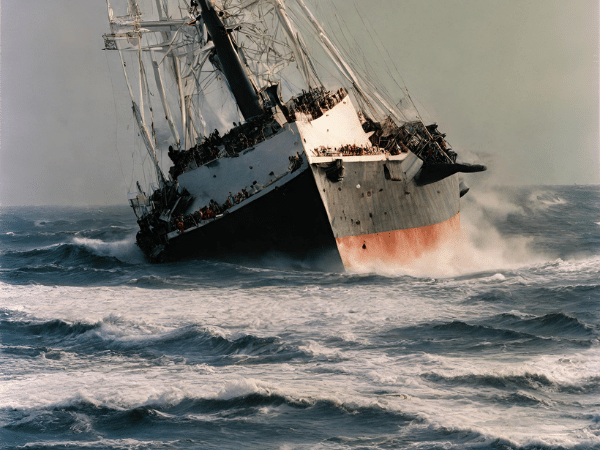
The SeaBreeze, originally named Federico C., was launched in 1958 and sailed for Costa Cruises. In 1983, it was transferred to Premier Cruises and renamed three times.
Premier Cruises went out of business in September 2000, leading to the ship being laid up. While being moved from Halifax, Nova Scotia, to Charleston, South Carolina, by its new owner, Cruise Ventures III, the SeaBreeze sank about 225 nautical miles off the coast of Virginia. All 34 crew members on board were rescued safely.
The ship sank due to the boiler breaking off, causing significant damage to the vessel.
The Sinking of MV Explorer (November 2007)

The MV Explorer, originally the MS Lindblad Explorer, began her career in 1969 as the first ship of her kind to sail through the Antarctic Ocean.
On November 11, 2007, she set sail from Ushuaia, Argentina, for a 19-day cruise. After visiting the Falkland Islands, she hit an iceberg in the Bransfield Strait on November 23, causing a gash in the hull that let water in.
All 91 passengers, 53 crew, and 9 guides were able to escape on lifeboats. They stayed there for five hours until the MS Nordnorge rescued them.
The Sinking of MS Sea Diamond (April 2007)
The MS Sea Diamond, originally known as Birka Princess, operated for Birka Line for most of her time at sea. In 2006, she was sold to Louis Cruises Line and renamed. A year later, she ran aground on a reef near Santorini, with 77 students from Paisley Magnet School in North Carolina on board.
Initially, it was believed that all passengers and crew were safe. However, two French citizens, Jean Christophe Allain, 45, and his daughter Maud, 16, were reported missing and never found.
Greek authorities later announced plans to charge the captain and five other officers with negligence.
The Capsizing of Costa Concordia (January 2012)
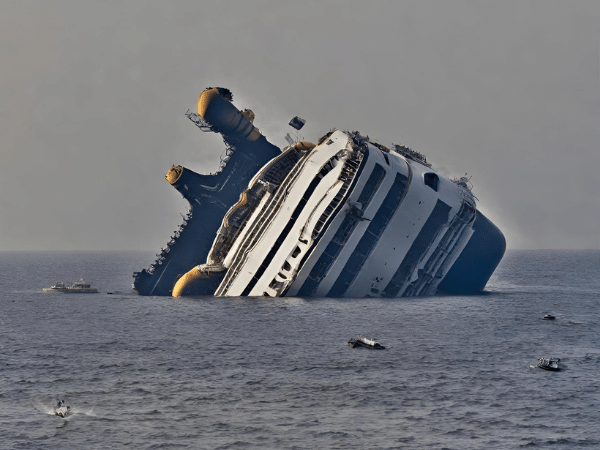
The Costa Concordia was the first ship of Costa Cruises’ Concordia Class, entering service in 2006. On January 13, 2012, she set sail on a 7-night Mediterranean cruise with 3,206 passengers and 1,023 crew members.
Captain Francesco Schettino veered off course, sailing too close to the island of Giglio. The ship struck a large rock, causing a 174-foot gash in the hull, leading to flooding and loss of power. The ship’s rudder position made it unsteerable, and it began tilting toward the starboard side.
The evacuation took over six hours and resulted in 32 deaths. An investigation focused on the crew’s actions, particularly Captain Schettino’s, as he left the ship while passengers were still on board.
Leave a Comment Cancel reply
Save my name, email, and website in this browser for the next time I comment.

- Privacy Policy
A Comprehensive List of Sunk Cruise Ships and Their Maritime Tales

Introduction
Imagine setting sail on a luxurious cruise ship, ready to embark on a once-in-a-lifetime adventure. The salty sea breeze in your hair, the sun glistening on the horizon, and the promise of adventure on the high seas.
For many of us, a cruise vacation represents the epitome of leisure and luxury. However, lurking beneath the surface of this perfect image is a fascinating and, at times, unsettling history of cruise ships that have met an unfortunate fate.
Don’t worry, it’s an extremely unusual incident, and even if it does occur, this era’s safety systems ensure that most, if not all, passengers and crew are entirely safe.
While cruising is considered one of the safest modes of travel, the chronicles of maritime history are sprinkled with stories of shipwrecks, lost treasures, and unsolved enigmas.
Has a cruise ship ever gone down?
You would love to know that thankfully, very few cruise ships have actually sunk in modern history. Today’s cruise ships are designed to endure severe weather.
Furthermore, cruise lines actively monitor the weather in order to avoid storms wherever feasible. Having said that, you’ve probably wondered how many cruise ships have sunk at some point.
If river cruise ships and ocean liners are included, around 20 or more cruise ships have sunk over our recent 100 years of history.

Carnival Cruise Director’s Schedule for 2024-2025
Carnival cruise ships ranked by size along with visual comparison chart.
We will be looking at some of the incidences and to your surprise, almost over 2,000 people have died in these occurrences, with ships sinking before 1940 accounting for more than half of the deaths. Many of the occurrences resulted in no deaths.
Let’s check out the list of sunken masters of the waters.
1. April 1912, Titanic
The Titanic’s sinking became a headline not for its cinematic adaptation but stands out as one of the deadliest as it accounted for over 1500 deaths.
On her maiden voyage across the Atlantic, she collided with an iceberg that resulted in a tragic incident. The deadliest maritime tragedy was caused by to insufficient number of lifeboats for the passengers.
In addition, there was a limited chance of survival for those without lifeboats in the waters where the ship went down. This haunting story taught a lesson emphasizing the value of safety precautions when sailing.
2. May 1914, Empress of Ireland
Two years after the Titanic’s tragic sinking, a similar incident happened in May 1914. The ship called Empress of Ireland with 1500 passengers, collided with the Norwegian ship Storstad. Despite sighting each other, dense fog made it worse for them.
1,012 passengers and crew members died in this horrific tragedy, and the Empress of Ireland was sadly only four journeys away from making its 1,000 successful voyages.
The story of this ill-fated liner serves as a reminder of the dangers and uncertainties that travelers and sailors can encounter on the high seas.
3. May 1915, Lusitania
The Lusitania, a cruise ship launched by Cunard Line in 1906, once held the prestigious title of the world’s largest passenger ship. However, its fate took a tragic turn during World War I.
For nine successful years, the Lusitania completed 201 transatlantic journeys. Yet, on its 202nd voyage from New York to Liverpool, disaster struck when a German U-boat torpedoed the ship off the southern coast of Ireland.
The ferocity of the explosion and the rapid tilting of the ship allowed for only six lifeboats to be launched. As a result, 1,198 passengers and crew members lost their lives, while 764 fortunate individuals managed to survive.
The sinking of the Lusitania remains a black chapter in maritime history, a poignant reminder of the perils faced during wartime travel on the high seas.
4. November 1916, Britannic
Originally intended to be a passenger ship, the Britannic, one of the Olympic Class ocean liners operated by White Star Line, was converted into a hospital ship during World War I.
A German naval mine in the Kea Channel caused tragedy in November 1916, as the ship sank in under 55 minutes. About thirty people were casualties, although most passengers got out alive.
5. October 1927, Principessa Mafalda
Built in 1909 and named for Princess Mafalda of Savoy, the Italian cruise ship Principessa Mafalda suffered tragedy in 1927.
The ship sustained structural damage when it sank while traveling between Argentina and Italy as a result of a major propeller shaft failure. Sadly, 314 of the 1,252 passengers and crew members who were involved in the tragedy died.
6. June 1931, Saint-Philibert
In 1931, tragedy struck when a tiny cruise ship collapsed and drowned off the coast of France, killing nearly 500 people and leaving only eight survivors. The ship ran summertime cruises along the French coast before the catastrophe.
The accident was caused by a number of things, including overloading the aircraft with twice as many people on board as was planned and extremely inclement weather.
7. May 1932, Georges Philippar
A modern French ocean liner tragically sank on its inaugural voyage because of an electrical problem. Faulty high-voltage wiring and a broken light switch caused a fire that killed 54 people.
To avoid delays in construction, quality concerns about the vessel were ignored. Improved onboard electrical safety measures were put in place after the event, including installing more dependable circuit breakers and switching to a different current type.
8. 1934 , SS Morro Castle
The SS Morro Castle was launched in 1930 and was designed especially to make regular sailings between the US and Cuba.
However, due to a tragic incident in 1934, the ship sank due to a fire caused by the electrical cables and hydraulic lines used for steering the ship.
In this accident,137 people lost their lives and the crew was blamed who handling the emergency badly.
9. October 1940, Empress of Britain
Two phases of the great ocean liner Empress of Britain’s death occurred during World War II. After being attacked from above on October 26, German U-boats sunk it on October 28.
Thankfully, 416 crew members, 2 gunners, and 205 passengers—the majority of the passengers and personnel—all safely escaped the vessel. Still, 45 people lost their lives in the catastrophe.
10. July 1956, Andrea Doria
Even though it was tragic, the Andrea Doria accident brought to light important improvements in ship safety since the Titanic accident. It listed on one side after hitting Stockholm, making it more difficult to approach the lifeboat.
But as the ship sank gradually, the crew was able to use their improved communication and rescue skills to save 1,660 passengers and crew members. The next day’s sinking was not the cause of the casualties; rather, it was the collision.
11. October 1961, Bianca C
Because the Bianca C sank twice, it has a special place in nautical history. During World War II, German soldiers destroyed the passenger ferry that it was originally intended for.
Following its salvage, Costa Line—the forerunner of Costa Cruises—refurbished it and gave it the new name Bianca C.
But calamity struck again in 1961, this time due to an explosion in the engine room that caused it to sink again. Thankfully, everyone on board survived the incident save for one crew member.
12. 1979 September, Angelina Lauro
With a storied past, the Angelina Lauro began service as a passenger ferry in 1939 and later became a hospital ship during World War II. It was reborn as a cruise ship in 1972.
But tragedy struck in 1979 when it caught fire in Saint Thomas port, while Costa Lines was in charge. Days passed with no casualties, but the ship was declared irreparable. Then, on the way to a scrapyard, it capsized fatally.
13. February 1986, MS Mikhail Lermentov
In 1982, the large ship MS Mikhail Lermentov, which was owned by the Soviet Union’s Baltic Shipping Company, became a cruise liner.
Tragic events occurred in 1986 while on a two-week exploration cruise from Sydney to Cape Jackson, which is close to Wellington.
Not about twenty minutes after the last passenger was saved, the ship completely sank, despite the quick response that saw the majority of the 372 passengers and 348 crew members evacuate into lifeboats. Pavel Zagladimov was sadly the only crew member to die in the tragedy.
14. August 1986, SS Admiral Nakhimov
The ship’s incredible history includes three separate sinkings! It was submerged and eventually came into the possession of the Soviet Union after being used by the Nazis as a hospital ship during the war.
The ship sank again in spite of attempts to raise it, only to rise again. 423 of the 1,234 people on board perished in the collision with a freighter that occurred in 1986 while it was conducting cruises in the Black Sea.
15. August 1991, MTS Oceanos
Three years after the MV Jupiter catastrophe, which claimed four lives, the Greek ship MTS Oceanos met her awful end in 1991.
The ship sank as a result of excessive water entering the vessel from suddenly big waves breaking a badly fitted pipe. Thankfully, all 581 passengers and the crew made it out alive.
The entertainers warned and helped guests to safety, however, the captain and a few other crew members were judged to be at fault for leaving the ship.
16. December 1994, Achille Lauro
Before joining MSC Cruises, the MS Achille Lauro was originally ordered by a Dutch business. The trip was turbulent and filled with catastrophes like fire, explosions, and hijacking.
Tragically, it caught fire and sank off the coast of Somalia on December 2, 1994. Two people lost their lives during the evacuation, which involved 979 passengers and crew members.
17. May 1999, Sun Vista
Before changing her name to Sun Vista in 1997, the ship was operated by Celebrity Cruises for seven years under the name SS Galileo Galilei.
Two years later, tragically, an engine room fire caused it to sink, leaving all power disconnected.
Thankfully, all 1,090 passengers and crew members disembarked safely and without incident thanks to contemporary safety requirements.
18. October 2000, Britanis
In 2000, the British transferred ownership of the vessel from Chandris Lines to AG Belofin Investments with the goal of dismantling it in India.
But as it traveled, it started to listen and absorb water. The only option was to let it capsize and sink off the coast of Cape Town since there was no personnel on board to deal with the problem.
19. 2000 , SeaBreeze
The SeaBreeze was launched in 1958 and is owned by Costa Cruises primarily. Later the ownership was transferred to Premier Cruises in 1983.
In the year 2000, the ship sank due to the breaking off boiler that caused sufficient damage to sink the ship.
As per reports, it is believed that it was an intentional incident to claim for insurance money and had received $20 million as compensation. When the ship sank, only 34 crew members were on board and all were rescued.
20. April 2007, MS Sea Diamond
After twenty years of service, the MS Sea Diamond—originally ordered by Birka Line as the Birka Princess—was transferred to Louis Hellenic Cruise Lines. But catastrophe struck in 2007 when it became stuck on the rocks of Santorini.
Even though it was later found that incomplete charts had contributed to the tragedy, the captain still had to deal with the fallout.
Although more than 1,000 passengers and crew members were amazingly saved, the loss of two French passengers—who are believed to be dead—remains a sobering reminder of the human cost of the ordeal.
21. 2007 , MV Explorer
The MV Explorer was a small cruise ship launched in 1969 and had many owners till her last date. in her life, launching first in 1969.
She became the first cruise ship specifically that went across Antarctic Ocean. Unfortunately it also became the first ship to sink there too.
In 2007, it collided with an iceberg and 91 passengers, 54 crew and 9 expert guides had to take lifeboats to save their lives. After five hours of the nightmare everyone was rescued by the MS Nordnorge.
22. January 2012, Costa Concordia
Frequently compared to its historical forerunner, the Titanic, the Costa Concordia represents a contemporary symbol of maritime catastrophe.
After the ship sank because it sailed too close to Tuscany, 34 people died—passengers, crew, and members of the salvage team—out of the 4,252 people that were on board, the majority of them were more than 3,200 passengers.
The captain, Francesco Schettino, was found guilty and sentenced to sixteen years in prison for the fatal incident.
23. June 2015, Eastern Star
A Chinese river cruise ship called “Dongfang Zhi Xing” operated on its usual course down the Yangtze River until an unfortunate incident occurred in 2015.
It was destroyed by a strong storm while traveling from Nanjing to Chongqing, foundering in shallow water that was just 15 meters deep.
Only 12 of the 456 people on board made it through the ordeal; the remaining 442 passengers and crew perished. The passengers, who were mostly old, faced immediate disaster when the ship quickly capsized.
Better severe weather communication procedures were consequently put in place for river excursions, and the Chinese government found that 43 people were held accountable for management carelessness.
24. February 2016, Ocean Dream
There is nothing like the history of the Ocean Dream. Norwegian Cruise Line had originally ordered the Seaward, but due to building issues, the purchase was canceled.
The ship was later purchased by P&O, who renamed it the Spirit of London. It sailed the world under different names and ownerships.
It finally met its demise in 2016, drowning in Thailand following a year of abandonment. Fortunately, no one was hurt in the incident.
25. August 2020, Orient Queen
The Abou Merhi Group in Lebanon owned the Orient Queen, which sailed from Beirut to explore the enchanted eastern Mediterranean, including stops in Turkey and Greece.
Sadly, in 2020, the ship sank while parked in port due to a massive explosion caused by ammonium nitrate that rocked the port.
Sadly, the event claimed the lives of two crew members. Orient Queen was the only cruise liner to sink, however, several other vessels in the port suffered damage.
Set out on an elegant cruise journey, where you are set for amazing adventures as the sun shines down on the horizon and the ocean breeze tousles your hair.
Although cruising is associated with the epitome of luxury and leisure, it has an intriguing and often unsettling past.
Modern safety precautions guarantee the safety of both passengers and crew, even in the rare event of an accident.
Maritime mythology abounds with stories of shipwrecks, missing wealth, and mysteries, even though cruises are still one of the safest modes of transportation.
For those of you who may have been scared about setting foot on a cruise ship, take heart. The numbers reveal that ship sinkings are exceedingly uncommon, and robust safety measures stand as stalwart protectors.
With these reassurances, you’re now free to embark on a splendid cruise holiday without a worry in sight.
FAQ’s
1. what is the probability of a cruise ship to sink.
Ans – The probability of a sinking ship is very low. In the last 50 years, 11 cruise ships sank while on a voyage. It is neither easy nor accurate to predict this condition.
2. What is the reason behind cruise ship not sinking?
Ans – The way these ships are built they are meant to remain upright and the inbuilt ballast tanks protects the ship from sinking.
The advanced navigation systems and safety mechanisms, along with expert and trained crew has made the journey on cruise safe and fear free.
Get Cruise-Smart! Join our Crew for Tips, Tricks, and Sea-sational Tales. Subscribe Now!
Email address
Trending Topics
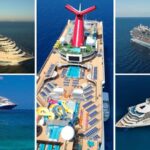
Carnival’s Fleet Journey: From Oldest to Newest Ships by Age
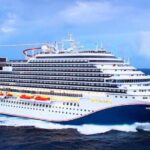
Carnival Cruise Director’s Schedule for 2024-2025
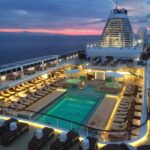
How Expensive Is Cruise Travel?

The Meaning Behind Pink Flamingos

Sign in to your account
Username or Email Address
Remember Me
How Many Cruise Ships Have Sunk in the Past 100 Years?
Home » How Many Cruise Ships Have Sunk in the Past 100 Years?
Last updated on January 11th, 2024 at 10:24 am
Cruises are one of the safest options for vacations, but in the past 100 years there have been some incidents with cruise ships sinking . Here are some notable ones in the past 100 years.
Titanic (1912) The most famous cruise ship sinking in history, the Titanic sank after colliding with an iceberg.
Empress of Ireland (1914) This large passenger liner sank after colliding with a Norwegian cargo ship, the Storstad, during foggy weather.
Lusitania (1915) For a few months before her sinking, the Lusitania was the largest passenger ship in the world. A casualty of WWI, she was hit by a torpedo from a German U-boat off the south coast of Ireland.
Britannic (1916) Sister ship of the Titanic, during WWI she struck a German naval mine off the coast of a Greek island and sank in less than an hour.
Princess Mafalda (1927) When a propeller shaft broke and damaged the hull of the ship, the Princess Mafalda sank off the coast of Brazil.
Saint Philibert (1931) A smaller cruise ship, the Saint Philibert sailed mainly in the Loire River and the French coastline. She sank in bad weather, but was also overloaded with twice her capacity on board.
Georges Philippar (1932) Unfortuanlety, this ocean liner sank on her maiden voyage. There was an electrical fault that sparked and set wood paneling on fire causing her to sink near Italian Somaliland.
SS Morro Castle (1934) A fire on board would disable the ship as it burned through the electrical cables and hydraulic lines that steered the ship. Her captain had died the evening before of an apparent heart attack. The burning ship drifted ashore in the shallow waters off Asbury Park in New Jersy, USA.
Empress of Britian (1940) Another victim of war, The ship was bombed from above in WWII when she was off the coast of Ireland. She was hit by two 550lb bombs.
Andrea Doria (1956) Struck by another ship, the Stockholm, the Andrea Doria began to list at once. This made most of the lifeboats inaccessible. However, because the ship sank slowly there were fourty six people killed, but 1660 passengers and crew were saved by rescue ships.
Bianca C (1961) The Bianca has the dubious distinction of being sunk twice. As a passenger ferry, it was scuttled by the Germans in WWII. When she was sold to Costa Lines and refitted as a cruise ship, she sank for the second time when there was an explosion in the engine room.
Angelina Lauro (1979) This ship caught fire in port at Saint Thomas. The ship burned for several days and was a total loss. While being towed to a scrapyard later that year, the Angelina Lauro sank.
MS Mikhail Lermentov (1986) On a cruise from Sydney that was on a two-week itinerary to New Zealand, the ship hit some rocks while sailing past Cape Jackson.
SS Admiral Nakhimov (1986) While operating cruises in the Black Sea, this ship collided with a freighter. They had communicated with the freighter’s captain who had assured the SS Nakhimov that they would be able to avoid a collision.
MV Jupiter (1988) This Greek-registered ship conducted cruises around the Mediterranean. She sank just 40 minutes after leaving Piraeus with a study cruise. There were 391 British schoolchildren and 84 adults on the ship, along with 110 crew. One child, one teacher and two crew died.
Achille Lauro (1988) The Achille Lauro had several unfortunate events including a hijacking, two collisions with other ships and four onboard fires. The last fire sank the ship off the coast of Somalia.
MTS Oceanos (1991) This ship, sailing from Greece, sank from excessive flooding that was caused by freak waves. It is believed that the waves broke a ventilation pipe that had not been correctly repaired and caused the flooding to be severe. To their shame, the captain and some crew abandoned the ship. It was the entertainers on the ship who gave alarm and guided passengers to safety. The captain and crew members were later convicted.
Sun Vista (1999) The sun set on this ship due to an engine room fire. The fire cut all power to the ship’s operating mechanisms and she sank in the Strait of Malacca.
SeaBreeze (2000) The boiler in the ship broke off and damaged the ship. This happened in 30-foot seas, which caused the ship to take on water and capsize. The ship had no passengers on board as she was headed into port for engine repairs.
Britanis (2000) While being towards a scrapyard in India, this ship began to take on water and list. As there was no one on board, the list was not corrected. The tugboat towing Britianis cut the ship free and it capzied and sank off the coast of Cape Town.
MV Explorer (2007) A small cruise ship, the MV Explorer was the first cruise ship that was specifically used for cruises to the Antarctic Ocean. She struck an iceberg and sank. Her passengers and crew made it to the lifeboats and were rescued after drifting for five hours.
MS Sea Diamond (2007) Striking a reef 430 feet from shore, the Captain was blamed and jailed for this sinking. The sea charts he was using were incorrect, and had stated that the reefs were 187 feet from shore off the island of Santorini in the Aegean Sea.
Costa Concordia (2012) In modern history, the Costa Concordia is the most famous cruise ship that has sunk. It struck an underwater rock off the coast of Tuscany. The Captain was also blamed for taking the ship off course and too close to the shore line. He was found guilty of manslaughter and sentenced to 16 years in prison.
Eastern Star (2015) This Chinese river cruise ship was caught in a storm as she was sailing to Chongqing. The ship sank in just 50 feet of water, but only 12 people of the 456 onboard survived.
Ocean Dream (2016) This ship has many owners and about half a dozen names. After having been abandoned in Thailand for over a year, she sank when she capsized.
Orient Queen (2020) The Orient Queen would sail from Beirut to the eastern Mediterranean. While in port, with no passengers on board, the ship sank after there was a huge ammonium nitrate explosion at the port. Other ships also in port were damaged, but the Orient Queen was the only one to sink.
RECENT POSTS
Cruise news this week, what does it take to keep cruise passengers fed, royal caribbean cruise line loyalty programs: sailing to rewarding adventures, retirement home vs life at sea on a cruise ship, do i need travel insurance for a cruise, the pros and cons of cruising on a smaller cruise ship.
© 2023 cruiseportadvisor All Rights Reserved.
- Book Excursions
- Anchorage, AK
- Baltimore, MD
- Cape Liberty, NJ
- Charleston, SC
- Ft Lauderdale, FL
- Galveston, TX
- Honolulu, HI
- Jacksonville, FL
- L.A. (San Pedro), CA
- Long Beach, CA
- Montreal, QC
- New Orleans, LA
- Norfolk, VA
- NYC – Brooklyn
- NYC – Manhattan
- Port Canaveral, FL
- Quebec City, QC
- San Diego, CA
- San Francisco, CA
- San Juan, PR
- Seattle, WA
- Vancouver, BC
- Whittier, AK
- Alaska & Pacific Northwest
- Central & South America
- Cruise Ports in Bermuda
- Dominican Republic
- Mexico & Mexican Riviera
- Eastern Canada & Quebec
- New England
- Los Angeles (San Pedro), CA
- Fort Lauderdale, FL
- Cruise Blog
- Cruise FAQ’s

How Many Cruise Ships Have Sunk? [& How Often]
Whether you are about to embark on a cruise ship or have watched movies like the Titanic, a question that might pop into your head is how many cruise ships have sunk and how often this happens.
There have been many deadly cruise ship incidents in maritime history that shocked the world. From the Titanic to Costa Concordia, many cruise ships have sunk in the past.
If this is your first sailing or exploring maritime history, you will have many questions.
In this article, I will share the list of cruise ships that have sunk in the past and how often this happens. Finally, if something unfortunate happens, you will also see if modern-day cruise ships have enough safety measures.
How Many Cruise Ships Have Sunk?
Since 1900, only 16 cruise ships have sunk. This includes ocean liners and river cruises as well. The Costa Concordia is the biggest cruise ship to sink in the last 100 years. But no sinking was as severe and deadly as the Titanic’s .
If cruise ships, ocean liners, and river cruises are considered, the number will be well over 16.
Not all cruise ships were sunk when they were sailing. Many cruise ships, ocean liners, and river cruises were sunk while being towed or berthed.
For example, the latest cruise ship sinking of Orient Queen was when the ship was berthed in Beirut. Since the ship had no passengers onboard, only two crew members were killed in the event.
Ship sinking is very rare, and when it happens, not many lives are lost, as all leading modern-day cruise ships are equipped with safety measures like lifeboats and other facilities to save every passenger and crew onboard.
Only three times in the last 50 to 60 years have passengers lost their lives.
In short, cruise ships are designed and built, so they don’t sink that easily, and if something unfortunate happens, there are enough safety measures to save the maximum number of lives.
How Often Do Cruise Ships Sink?
As 16 cruise ships have sunk in the last century, we can assume a ship sinks every 6 years. But since most of the sinkings do not involve passengers onboard, major casualties are rarely reported.
The numbers differ slightly depending on the type of vessel you are referring to, like cruise ships, river cruises, and oceanliners.
The maritime industry has learned a lot from previous ship wreckages and sinking, resulting in building modern-day cruise ships with a rare chance to sink.
One thing to note is that most cruise ships were sunk when there were no passengers onboard, avoiding many casualties.
In short, a ship is sunk only once in 6 to 8 years, and major casualties are reported only once in 20 years.
List Of Sunken Cruise Ships Till 2023
The table below summarizes the list of all cruise ships that sunk in the last century.
Note: The table above includes cruise ships, ocean liners, river cruises, and cruise ferries.
When Was The Last time A Cruise Ship Sank?
The last cruise ship to sink was Orient Queen on August 4, 2020. The ship sank due to the ammonium nitrate explosion while it was at its berth. Since the cruise ship was moored at its berth, no passengers were onboard. But the event killed two crew members and several people injured.
2,775 tons of ammonium nitrate stored at the Port of Beirut exploded, damaging many vessels docked at the port, including the Orient Queen. 218 people were killed, and thousands were injured during the event.
On top of all that, $15 billion worth of property was damaged.
Major Cruise Ships That Sank
Let’s now take a look at all the cruise ships that ever sank and the cause of the sinking.
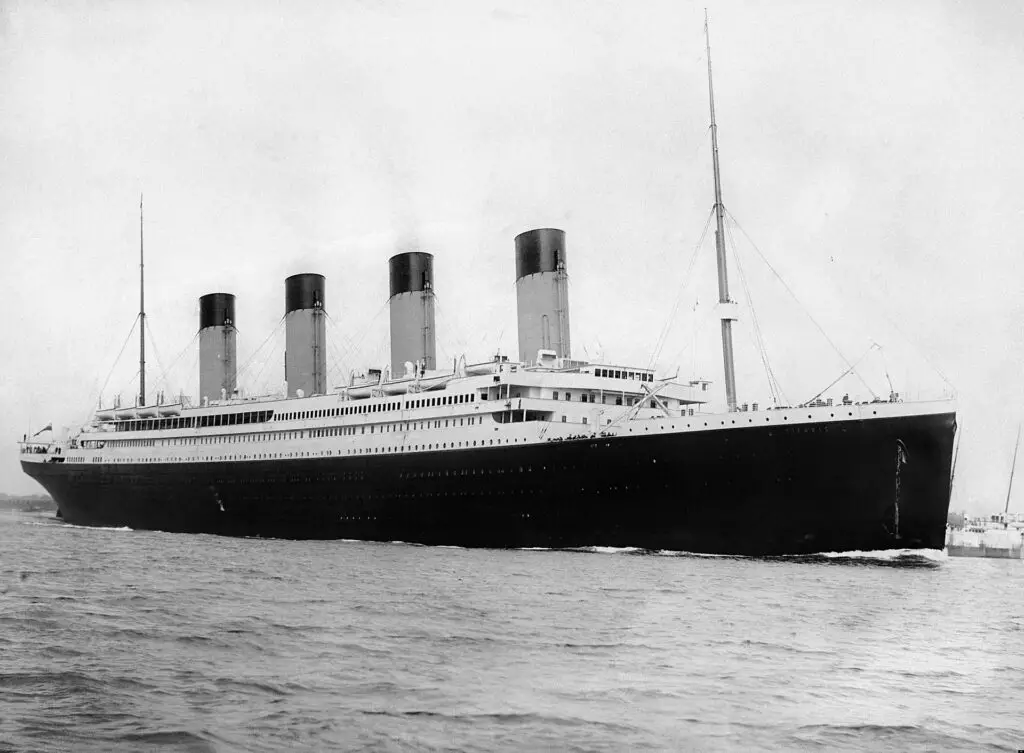
The Titanic is an oceanliner .
Titanic needs no introduction. Everyone knows about the Titanic sinking on its maiden voyage in 1912.
The Titanic started its journey from Southampton, England, and on its way, it collided with an iceberg and sank completely. The vessel cracked in half before sinking and hitting the ocean floor.
The RMS Titanic was an ocean liner operated by White Star Line.
This tragic incident killed 1,500+ passengers and crew on board. Since the water temperature was too low , people could not survive on the water for longer. Furthermore, it’s said that the Titanic didn’t have enough lifeboats for all passengers.
The famous movie Titanic is based on the true story of the Titanic sinking.
Reference: Wikipedia
RMS Empress of Ireland

The RMS Empress of Ireland, aka Empress of Ireland, sank on May 29, 1914, after colliding with a Norwegian collier ship Storstad.
At the time of its sinking, the RMS Empress of Ireland was carrying about 1,500 passengers onboard.
The vessel collided with the other one due to foggy weather conditions affecting visibility.
This maritime disaster took the lives of 1,012 passengers and crew members onboard.
HMHS Britannic

The sister ship of the Titanic and Olympic, HMHS Britannic, or His Majesty’s Hospital Ship Britannic, sank in 1916 after striking a mine.
On November 21, 1916, an explosion happened inside the ship, causing water to let into the watertight compartments.
As time passed, water entered the open portholes on the starboard side . Soon after the water entered the ship, the engine stopped. In about 55th minute, the HMHS Britannic sank. This incident only killed 30 people.
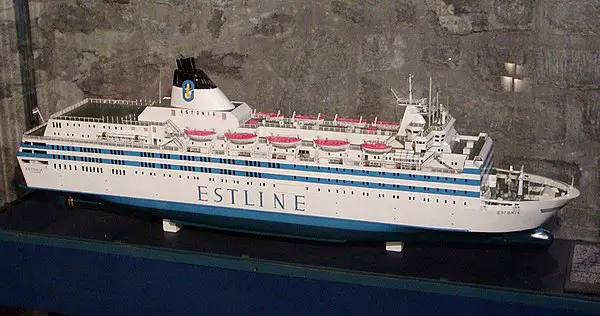
MS Estonia sank in the Baltic Sea in 1994 after hitting a storm. The vessel was sailing from Estonia to Sweden.
The sinking of MS Estonia killed 852 people. The cruise ferry was carrying about 989 people, including passengers and crew.
Out of the 989 people, only 137 people survived.
Costa Concordia
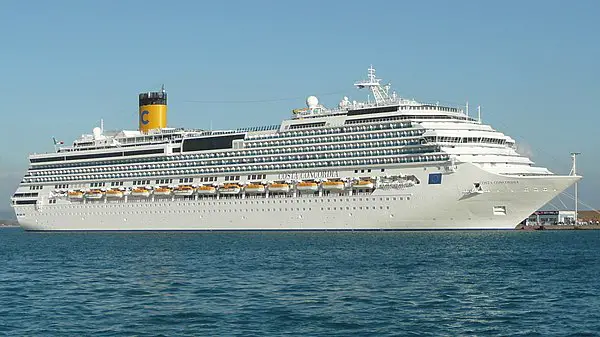
Costa Concordia was the major modern-day cruise ship to sink while on its journey with thousands of passengers and crew onboard.
Costa Concordia hit a reef off the coast of Italy on January 13, 2012. The ship sailed too close to an island, causing the ship to hit an underwater rock, causing the watertight compartments to flood.
At the time of sinking, Costa Concordia was carrying about 4,229 passengers and crew members. This event killed 32 people. This includes 5 crew, 2 salvage team members and 27 passengers.
Later, the captain was found guilty of manslaughter and was sentenced to 16 years of imprisonment.
Principessa Mafalda

Principessa Mafalda was sunk in 1927, killing 314 people, which includes both passengers and crew members.
The vessel’s propeller shaft broke, damaging the hull, and causing the ship to sink mid sea. The incident took place on the coast of Brazil.
Principessa Mafalda is an Italian cruise ship based in Argentina.
Georges Philippar
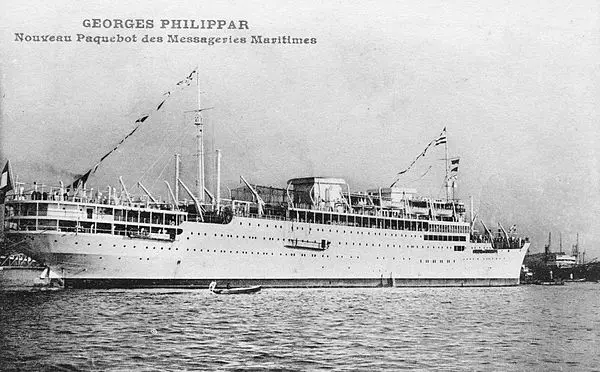
Georges Philippar is yet another vessel that sank on its maiden voyage. The French ocean liner was returning after the voyage to Yokohama.
The sinking of Georges Philippar took the lives of 54 people.
A fire broke out in one of the cabins in the Georges Philippar, after a faulty light switch ignited.
Andrea Doria

In 1956, the sinking of Andrea Doria resulted in the death of 46 passengers and crew members.
While returning, Andrea Doria was hit by a cruise twice the size, causing the ship to sink. The ship sank gradually, allowing more than 1100+ people to escape.
It is said that the people who lost their lives in this event were because of the direct collision with the other ship. The ship only sank completely a day after the collision.
The collision made a good number of lifeboats inaccessible.
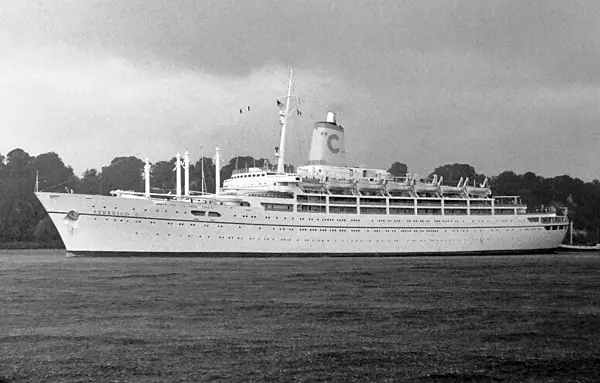
The boiler of the SeaBreeze broke off, causing the ship to sink in 2000. The cruise was owned by Costa Cruises and was transferred to Premier Cruises in 1983.
During the incident, only 34 crew members were on board, and luckily no one was injured as everyone was evacuated easily.
Come controversy exists claiming the sinking of SeaBreeze was intentional to claim insurance. The cruise was already out of business and would fetch $6 million as scrap value. But it was insured for $20 million.
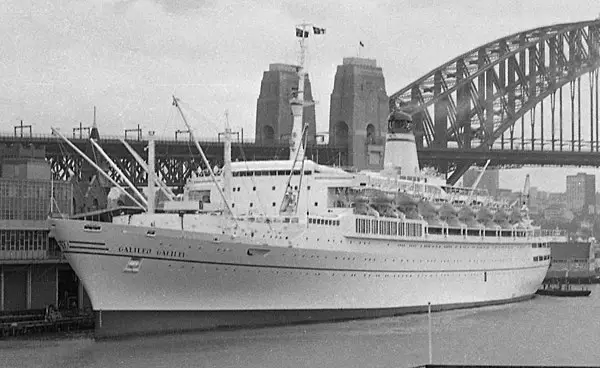
An engine room fire made the Sun Vista sink on May 2, 1999. Even though the entire ship sank, no major casualties nor deaths were reported.
The fire in the engine room cut all the power supply, making the ship sink.
Sun Vista also known as SS Galileo Galilei. The cruise was later bought by Sun Cruises and renamed Sun Vista.
MV Jupiter sank on October 21, 1988, just 40 minutes after leaving the Greek port of Piraeus. The event killed 4 out of the 381 schoolchildren and 84 adults.
Soon after leaving the Greek port of Piraeus, MV Jupiter got struck by a freight ship, the Adige. The collision resulted in a massive hole in the port side of MV Jupiter, letting water in.
Soon after the incident, the ship sank vertically and stern in 82 meters.
The Britanis cruise ship was out of business and was being headed to a scrap yard in India. On the way, the ship developed a heavy leak in the aft section.
The repair for fixing the leak was too costly, and she was allowed to sink.
Since no one was inside the cruise ship and it was tugboat, no casualties were reported.
Orient Queen
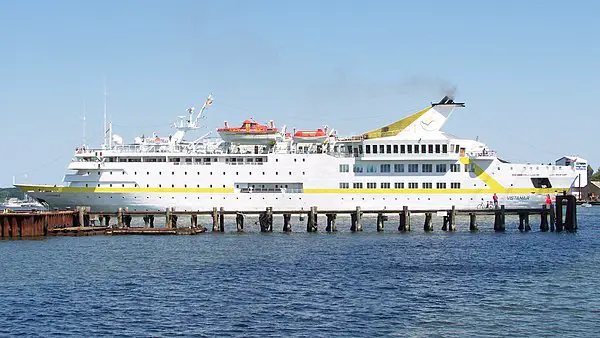
Orient Queen is the latest cruise ship to sink completely. The ship was berthed at the Port of Beirut. The ship sank after a huge ammonium nitrate explosion at the port. Along with Orient Queen, some other ships docked at the port also suffered major damages.
Abou Merhi Grou owned Orient Queen.
Eastern Star
Eastern Star is a river cruise officially known as Dongfang zhi Xing that sank in 2015. On its way back to Chongqing, the river cruise caught in a storm and completely sank in a few hours.
The tragic incident took the lives of 442 people out of the 456 people on board the ship. Only 12 people survived.
The crew wasn’t aware of the severe weather condition, causing the deadly tragedy taking the lives of 442 people.
Later after a thorough investigation, more than 40+ people were punished for flaws in the company management.
MTS Oceanos
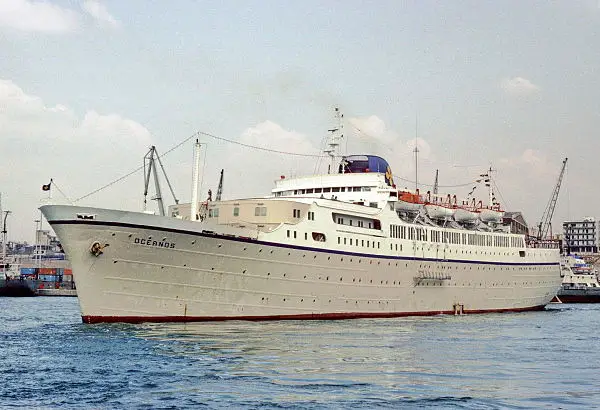
MTS Oceanos sank on August 3, 1991, after a severe leakage in a ventilation pipe flooded the cruise.
The repairs to the waste disposal system of the MTS Oceanos were not completed before its voyage. This caused the ventilation pipe to burst open and start letting water inside the compartment.
Soon the engine room of the vessel was flooded, and she eventually sank.
All 581 passengers and crew members survived the sinking of MTS Oceanos.

How Many Cruise Ships Sink a Year?
As 16 cruise ships have sunk in the last 100 years, we can say a ship sinks in every 6 to 8 years.
But cruise ships sinking is a rare event as modern day cruise ships are well built and designed not to sink or top over even in extreme conditions.
If you look at the years in which cruise ships sank, you will see a gradual decrease in the frequency and number towards the modern age.
A cruise ship takes all the measures to make the ship not sink, and even if something unfortunate comes along the way, there are enough lifeboats , jackets, etc, to rescue people.
How Do Cruise Ships sink?
In most cases, cruise ship does not sink at all. The vessels are designed in such a way as to handle extreme tides and waves. She will keep floating even in rough weather conditions.
But if the cruise ship collides with external obstacles like rocks, icebergs, etc., they may sink. When a vessel hits an iceberg or rock, the watertight compartments will get flooded, eventually letting water in and sinking the ship completely.
So, unless the ship hits an iceberg or rock, it won’t sink at all.
Modern-day navigation systems in cruise ships are well equipped to avoid any possible obstacles including icebergs, rocks, coral reefs, other vessels, and more.
How Many Carnival Cruise Ships Have Sunk?
Only one carnival cruise ship has sunk in history, the Costa Concordia. The Costa Concordia is a cruise ship from Costa, an Italian cruise company owned and operated by Carnival Corporation.
Even though the Costa Concordia cruise ship does not come directly under Carnival cruises, it is still part of the Carnival Corporation.
In short, no Carnival brand cruise ships have sunk or capsized.
Even though no Carnival cruise ships have sunk, there have been a couple of instances where the vessel’s engine shut down after a fire broke out, and the ship got stranded for many hours.
A fire on the Carnival Triumph cruise ship’s generator made her stranded for hours before being fixed. After the event, the cruise line renamed it Carnival Sunshine.
How Many Royal Caribbean Cruise Ships Have Sunk?
No Royal Caribbean cruise ships have sunk or capsized.
How Many Disney Cruise Ships Have Sunk?
No Disney cruise ships have ever sunk in the past. The history is clear for the Disney cruise line.
Leave a Comment Cancel reply
Save my name, email, and website in this browser for the next time I comment.
Switch language:

The world’s worst cruise ship disasters
Tragedies aboard cruise ships live on in infamy as the sinking of RMS Titanic, the biggest cruise disaster in history, bears witness. Ship-technology.com lists the worst ever cruise ship disasters.
- Share on Linkedin
- Share on Facebook
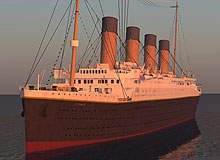
RMS Titanic
The sinking of RMS Titanic in April 1912 remains the worst, and the most infamous, cruise ship disaster in history. The sinking of the biggest passenger ship ever built at the time resulted in the death of more than 1,500 of the 2,208 people onboard.
The accident occurred when the ship hit an iceberg while cruising at its maximum speed of 23k on her maiden voyage from Southampton to New York City. The massive loss of life in the North Atlantic Ocean resulted mainly from hypothermia.
Go deeper with GlobalData

Russia: Falling Voice Revenue and Macroeconomic Uncertainty to Slow...
Disruptor profile: day zero diagnostics, inc., premium insights.
The gold standard of business intelligence.
Find out more
Related Company Profiles
Parsons corp, newport news ship building, meyer werft gmbh, wolff corporation.
RMS Titanic was the second of three Olympic-class ocean liners operated by White Star Line. It was constructed by the Harland and Wolff shipyard in Belfast in three years and was designed by the naval architect Thomas Andrews.
RMS Titanic measured 269.11m in length, 28.042m in breadth, had a gross tonnage of 46,328t and comprised nine decks. The cruise ship was equipped with 20 lifeboats for 1,178 people.
The steamship’s three propellers were driven by two four-cylinder, triple-expansion, inverted reciprocating steam engines and one four-blade low-pressure Parsons turbine.
RMS Lusitania
The sinking of RMS Lusitania in May 1915, after being hit by the German military submarine U-20, caused 1,201 deaths during a voyage from New York to Liverpool. She was considered the largest, fastest and most luxurious ship in the world at the time of her launch in June 1906.
How well do you really know your competitors?
Access the most comprehensive Company Profiles on the market, powered by GlobalData. Save hours of research. Gain competitive edge.

Your download email will arrive shortly
Not ready to buy yet? Download a free sample
We are confident about the unique quality of our Company Profiles. However, we want you to make the most beneficial decision for your business, so we offer a free sample that you can download by submitting the below form
The Lusitania disaster resulted in the death of many Americans and became one of the major reasons behind the US entering World War I.
The German submarine targeted the submarine as a naval ship, as it was also carrying war weapons for the British.
RMS Lusitania was built by John Brown and Co. of Scotland and completed its maiden voyage in September 1907. The steamship was owned and operated by Cunard Company; a rival of White Star Line, which owned the Titanic.
RMS Lusitania had an overall length of 239.8m, beam of 26.7m, draft of 10.2m, depth of 18.4m, gross tonnage of 31,550t and ten decks. It was designed to accmmodate 2,165 passengers and 827 crew members. It was equipped with four 375kW generator sets and possessed a service speed of 25k and a maximum speed of 26.35k.
RMS Empress of Ireland
RMS Empress of Ireland, which sank in the Saint Lawrence River in May 1914, claimed the lives of 1,012 people out of the 1,477 people onboard. It was the second major cruise ship disaster after the Titanic disaster. The Ocean Liner operated on the North Atlantic route between Quebec and Liverpool in England.
The passenger steamship collided with the 6,000t Norwegian collier, the Storstad, following a thick fog which engulfed the river. Just five of the 42 lifeboats could be launched into the water due to the listing of the vessel on her starboard side. The accident was aggravated by the cold conditions, failure to close the ship’s watertight doors and failure to close all portholes aboard.
RMS Empress of Ireland was owned by Canadian Pacific Steamship Company. It was designed by Francis Elgar and built by Fairfield Shipbuilding and Engineering. The ocean liner was launched in January 1906 and completed her maiden voyage from Liverpool to Montreal in June 1906.
The cruise ship was 168m long, its beam measured 20m and gross tonnage was 14,191t. The ship was equipped with two steam engines and two quadruple expansion propellers, which provided a maximum operating speed of 20k.
MS Estonia, formerly known as Viking Sally, Silja Star and Wasa King during different periods from 1980 to 1993, sank in September 1994 during its voyage from Tallinn to Stockholm, resulting in 852 deaths, while 137 people were saved through rescue operations.
The cruise ferry accident was caused by rough sea conditions in the Baltic Sea, when wind speeds ranged from 35mph to 45mph. The bad sea conditions forced the ship to initially list on the starboard side and later sink completely.
The ferry was constructed by Meyer Werft at its shipyard in Papenburg, Germany, in 1980. The ferry, initially named Viking Sally, was delivered in June 1980 to its first owner Rederi Ab Sally. The vessel was operated by EstLine from 1993 to 1994.
MS Estonia measured 155.43m in length, 24.21m in breadth, had a draught of 5.55m, a gross tonnage of 15,598t and featured nine decks and ten lifeboats. The vessel was equipped with four 4,400kW diesel engines connected to two propeller shafts, and had an operational speed of 21k. The cruise ferry had capacity to accommodate 2,000 passengers and 460 cars.
SS Eastland
The SS Eastland disaster in July 1915 claimed more than 844 lives out of the 2,500 people onboard. The disaster occurred when the ship listed while being still tied to a dock in the Chicago River during preparations to cruise to Michigan City.
The probable causes of the disaster are believed to be the flaws in its design and construction, inadequacy of its ballast tanks and overloading. The accident occurred when the passengers embarked the ship. The ship initially listed to the starboard side and further to portside, throwing off passengers and trapping some in the interior cabins.
SS Eastland was owned by Michigan Transportation Company and operated by Chicago-South Haven Line. It was constructed by Jenks Ship Building Company, which specialised in constructing freighters but had no prior experience in construction of passenger vessels. The vessel was launched in May 1903.
The cruise ship had an overall length of 275m, width of 38m and gross tonnage of 1,961t. It was equipped with two triple expansion steam engines, four scotch boilers and two shafts. The vessel was designed for a top speed of 16.5k. It was equipped with 11 life boats and 37 life rafts.
Saint-Philibert Cruise Ship
Saint-Philibert was a twin screw-propelled small cruise ship that met with disaster in June 1931 resulting in the loss of about 500 lives, sparing just eight passengers while on its homeward run on the Loire Estuary in France.
The disaster was induced by harsh storms driving the passengers to take shelter behind the machinery casings, which caused the ship to list over. It was further struck by a wave causing her to sink. The ship, which carried approximately 500 people during the voyage, exceeded the normal carrying capacity by about 80%.
The inadequacy of the ship’s speed to face such waves, lack of coverings for shelter and absence of communication equipment further aggravated the situation. Besides, the captain and crew were considered unqualified.
Saint-Philibert cruise ship measured 32m in length and 6.4m in breadth, and had a draft of 2.74m and gross tonnage of 189t.
SS Admiral Nakhimov
The SS Admiral Nakhimov disaster in August 1986 resulted in the death of 423 people, mostly Ukranians, out of the 1,234 people onboard. The accident occurred in the Tsemes Bay near the port of Novorossiysk enroute Sochi.
The cruise ship collided with the large bulk carrier Pyotr Vasev at a speed of five knots, causing it to sink within a few minutes. The accident was caused by negligence of the captains of the two ships. The captain of Pyotr Vasev failed to heed the warning announced from SS Admiral Nakhimov, while the captain of Admiral Nakhimov was absent on the bridge at the time of the tragedy.
The passenger liner was originally named SS Berlin III and operated on the Crimean-Caucasian line. It was owned by Norddeutscher Lloyd and constructed by Bremer Vulkan.
SS Admiral Nakhimov had an overall length of 174m, beam of 21.02m and gross tonnage of 17,053t. It had a capacity to accommodate 1,125 passengers and 354 crew, and a cruise speed of 16k.
Aleksandr Suvorov
Aleksandr Suvorov, a river cruise ship of the Valerian Kuybyshev-class, met with disaster in June 1983 resulting in the death of 176 people out of the 415 people onboard, while cruising on the Volga-Don basin in Russia. The blame for the accident was placed on the captain who failed to prevent the accident and had not provided a proper order.
Just prior to the accident, an auction to be held at the cinema hall was announced, leading the passengers to the upper deck of the ship. The ship, which was cruising at a speed of about 13.5k at the time, crashed onto a bridge, failing to pass through the second span of the bridge. A freight train passing through the bridge was also affected by the crash, causing some cars to derail and fall on the ship.
Volga-Don Shipping Company was the operator of the ship at the time. Slovenské Lodenice constructed the vessel in Komárno, Czechoslovakia. The ship was restored after the accident and is currently operated by Vodohod.
Aleksander Suvorov has an overall length of 135.75m and width of 16.8m, and is comprised of four decks. It can accommodate 400 passengers and 83 crew, and runs on a 6CHRN36/45 (EG70 -5) diesel engine.
SS Morro Castle
The SS Morro Castle disaster in September 1934 resulted in the loss of more than 137 passengers and crew out of the 318 passengers and 240 crew onboard. The cruise ship was on its 174th return voyage to New York City from Havana.
The disaster was caused by a fire, which emanated from the cruise ship’s library and engulfed the entire ship. The fire was worsened by bad weather, inadequate crew and the ship’s design, which incorporated easily flammable interior materials. Just 12 lifeboats were launched out of the many lifeboats capable of rescuing 408 people.
The ship was owned by Agwi Navigation Co. and operated by Ward Line. It was constructed in 1930 at a cost of approximately $5m by Newport News Shipbuilding. The vessel completed her maiden voyage in August 1930 and served Ward Line along with its sister vessel SS Oriente for four years.
SS Morro Castle was 155m long, 21.6m wide and 11.9m deep, and had a capacity to carry 489 passengers and 240 crew. The steam turbo-electric liner was propelled by two turbines and sailed at a speed of 20k.
SS Andrea Doria
The SS Andrea Doria collided with the eastbound Swedish passenger liner Stockholm due to poor visibility caused by a thick fog. The disaster took place in July 1956 near the coast of Nantucket, Massachusetts, while cruising towards New York City resulting in the death of 52 people, while 1,660 people were rescued.
It is considered the world’s first major radar-assisted collision at sea, as the cause of the accident is assumed to be from the misreading of the radar. It was struck just aft and below the starboard bridge, and sank after 11 hours.
The ocean liner was owned by Italian Line and constructed by Ansaldo Shipyards of Genoa, Italy, at a cost of approximately $30m. It was launched in June 1951 and set out on its maiden voyage in January 1953.
SS Andrea Doria measured 212m in length, had a beam of 27m and a gross tonnage of 29,100t. It featured ten decks and was equipped with two steam turbines providing a top speed of 23k.
Sign up for our daily news round-up!
Give your business an edge with our leading industry insights.
More Relevant
Leading ESG consultants and sustainability advisers for the shipping industry
Fleet, crew and ship management software for the shipping industry, the top 10 largest container ships in the world, leading cybersecurity companies for the shipping industry, sign up to the newsletter: in brief, your corporate email address, i would also like to subscribe to:.
Ship Technology In Brief
Ship Technology Global : Ship Technology Focus (monthly)
I consent to Verdict Media Limited collecting my details provided via this form in accordance with Privacy Policy
Thank you for subscribing
View all newsletters from across the GlobalData Media network.
- CruiseMapper
- Ships and Lines
Cruise Ship Accidents
CruiseMapper's cruise ship accidents project follows our CruiseMinus project for reports and news/updates on major passenger vessel accidents, cruise line incidents and various types of incidents on passenger ships.
Our accidents and incidents reports provide statistical data on negative ("cruise minus") experiences during unfortunate events at sea and ashore. Here you will find detailed reports on cruise ship disasters (sinking, groundings, collisions, allisions, listing, fires), mechanical / technical issues, sea pollution, Norovirus-Coronavirus and other illness outbreaks .
CruiseMapper's reports also include cases of crew and passenger deaths, injuries (overboards, missing people, drownings, suicides), crimes (murders, sexual abuse, violence/assaults), cruise law news (individually filed lawsuits, class action cases, scandals, social media campaigns, etc).
If you don't search for events on a particular vessel (via the search box above), the following link jumps down directly to our list of sea-going passenger ships with accident-incident reports.
Cruise Minus
While the "Cruise Minus" website used to report events only on cruise liners, CruiseMapper has reports also on cruiseferries (largest Ro-Ro ships with passenger cabins) and riverboats .
As soon as something wrong happens on a particular passenger ship, we add a report regarding the accident / incident at the vessel's dedicated accident page. This way, CruiseMapper provides you with an unofficial cruise ship accident database of "bad cruise" (minus) events at sea and on shore (during port stays, private or group excursions and tours).
Despite everything you read here about dangers on cruise ships, remember to stay positive and don't be afraid of cruising. Unarguably, ship cruises are among travel industry's top 5 "best value for money" vacation options. And remember that even cheapest cruise deals are almost all-inclusive. Your ticket price includes accommodation, all meals (almost 24 hour available), room-service (on most companies), live entertainment, swimming pools and jacuzzies, not to forget exciting itineraries with plenty of ports.
Most statistical data regarding passenger ship accidents and cruise incidents is based on official reports published online by United States Coast Guard (USCG.mil). Other sources are online news media and local police reports. Statistics for cruise illness outbreaks are based on official reports published online by the US agency "Centers for Disease Control and Prevention" (CDC.gov). Our cruise ship tracking service is sponsored by VesselFinder.com.
- USCG department is a branch of US Armed Forces. It provides maritime service to both military and commercial/civilian vessels in distress at sea. The department provides maritime law enforcement service, and has jurisdiction in both US and international waters.
- CDC is USA's national public health institute, and federal agency under the umbrella of US Department of Health and Human Services. CDC is headquartered in Georgia (DeKalb County, northeast of Atlanta GA).
- VesselFinder is a free AIS marine traffic tracker providing real-time ship tracking data and historic ship positions (vessel movement) worldwide.
US Coast Guard (USCG) medevacs
An average medevac (medical emergency evacuation) of cruise ship passenger / crew conducted by the USCG cost around USD 30,000. The cost depends on the distance between vessel and nearest Coast Guard Air Station. USCG medevacs are paid by the US taxpayers. No expenses are charged directly to cruise companies or passengers / crew.
During standard missions, the nearest USCG air station dispatches an MH-65 Dolphin helicopter (twin-engine, single-rotor search and rescue helicopter) to the cruise vessel. The helicopter usually lands on the ship's helipad (Heli Deck) or (on smaller ships) just hovers over its top deck. From there, the team airlifts / hoists the patient in a rescue basket. The patient could be accompanied by a relative (spouse), and in more serious cases - by a crew nurse. Then it transports them to the nearest land-based medical facility.
Usually, such maritime rescue operations also include a Lockheed HC-130 Hercules (military transport aircraft) that supports communications coverage. Statistical data show that an average "cruise ship overboard" search and rescue operation conducted by the USCG could cost easily USD 0,5 million, and even reach USD 1 million.
What is the difference between cruise incident and accident?
"Accident" implies a negative association. Accidents usually result in major damages, serious injuries or even loss of life. The word is synonymous to mishap, unforeseen/unplanned bad event or circumstance with a negative outcome. For the argument sake, some use "accident" in a positive manner, when describing something bad that happened which lead to good things after all. Accidental love comes to mind.
Since "incident" can refer to anything bad or wrong that can happen, it could be both positive and negative as experience. "Incident" is used to describe feature events, usually with some adjective before the word explaining the incident type. These two words are majorly different, but often confused and interchangeably used. However, not so many among the cruise incidents can be termed "accidents". In most cases, these are simply unfortunate events (without Jim Carrey, of course).
Types of incidents and accidents on cruise ships
Cruise ship accidents and incidents can be classified as:
- disasters (sinking, grounding, capsizing, collision, allision, terrorist and pirate attacks, pollution, crashes and killings on land tours/shore excursions)
- mechanical (fire, propulsion issues, power loss) - often result in cruise cancellations.
- sickness / illness outbreaks (Norovirus/GastroIntestinal, Influenza, Legionellosis/aka "Legion Fever") - often result in delayed embarkation or itinerary changes.
- deaths (overboard jumps/missing passengers and crew members, drowning in ship pools, critical traumas, murder, suicide, Myocardial infarction/heart attack)
- injuries (rape, assault, battery, fractures by accidental falling/slipping)
- crimes (bomb threats, robbery, drug smuggling/possession, arrests for past fugitive warrants, theft, belligerent behavior and indecent exposure by intoxicated passengers)
- weather-related (heavy fogs, squalls, storms, hurricanes) - usually result in itinerary changes and ports of call delays.
NOTE: By "Cruise Vessel Security and Safety Act" ( pdf ), all passenger shipping companies are required by law to report to FBI any criminal activity against US citizens. Reports are mandatory, even on incidents at sea, during which the vessels were in international waters. The act became a law in 2010, when was signed by Barack Obama. The most common accidents on cruise ships are caused by:
- rogue waves (may reach height of up to 100 ft / 30 m)
- Hurricanes and squalls /heavy storms at sea (10 such events per season on average)
- ship fires (a total of 72 onboard fire incidents happened between 1990-2011)
- collisions (6 cruise vessels sunk hitting the sea bottom /rocks and reefs) or icebergs between 1990-2012, the most notorious accident being on Costa Concordia .
- allisions - when the vessel strikes a fixed object (such as pier.wharf, rocks, buoy, etc), usually happen during docking/undocking maneuvers.
- Norovirus illness (an average of 15 virus outbreaks on cruise ships happen per year).
Statistical data about cruise ship overboard accidents show that the average overboard passenger age is 41 yo. Most overboards involve males and happen on voyage's last night. Most overboard passengers are either drunk, on drugs or engaged in tomfoolery (climbing between staterooms, playing on railings). The surviving rate is nearly 22% (1 in 5). The longest time an overboard cruise passenger managed to survive (found alive and recovered) was 18 hours.
When a passenger or crew disappears (officially is reported missing) while the vessel is at sea, the cruise company has the duty to conduct an onboard search immediately upon learning about it. If the person is not found on board, then the ship reports the incident to USCG and FBI and starts a search and rescue operation. The ship returns to the last location at sea when the victim was last seen. This location is often subject to adjusting for weather and sea conditions. The company's failure to perform a search and rescue operation can render it liable for the person's disappearance.
According to CLIA, 90% of all commercial vessels calling on US ports are foreign-flagged. Common cruise ship flag-states are Bahamas, Panama, Bermuda, Malta, Italy, Holland. When a person on the vessel's manifest disappears, an official report must be sent to the flag country.
Among the common factors contributing to cruise ship overboards are Inadequate security staff and CCTV surveillance, failures to monitor onboard CCTV camera footage, overserving alcohol to passengers on the ship, criminal activities (homicides, violent assaults), overboard jumps as suicides (due to loneliness, depression, terminal illness, marital problems, etc).
Shore excursion accidents and incidents
When cruise ship passengers suffer injuries while on land tours/excursions, the resulting litigations are some of the most complex maritime injury cases. They are unique and complicated as incidents which occur in foreign countries and involve foreign tour operators.
Cruise companies often argue that tour operators are wholly independent and, as such, they have no legal responsibility to disembarked passengers. However, it is often apparent that tour operators are either cruise line agents or joint ventures with the companies. Cruise ship companies earn large profits from tours and excursions, and often they control nearly every aspect of the contract-based relationship with the tour company.
When a shore excursion incident occurs to a passenger, the cruise line usually rejects blame and attempts to force him/her to seek recovery against the tour operator. However, experienced maritime lawyers can successfully battle such legal deceits, establish jurisdiction over the tour company, prove the cruise line's and tour company's negligence.
Cruise ship injury lawyers can uncover contacts between foreign tour companies and the USA in order to establish Court's jurisdiction over foreign tour providers. Cruise lawyers can pinpoint where the cruise ship line failed to provide safety and welfare of its customers.
Cruise passenger accident claims
The 4 biggest ever mistakes a passenger can possibly make are:
- Failing to read and understand the terms and conditions of the cruise ticket contract. Given to all passengers before they embark on a voyage, the cruise ticket contract contains all the limitations against the cruise line company and the specific terms for filing an injury claim.
- Failing to report the cruise incident (injury, crime) immediately after it occurred. In order to receive compensation, a victim on board the cruise vessel should act immediately to report the incident, collect witnesses' testimonies, and document about the claim.
- Settling for less. After being injured, a cruise passenger is likely to be shortchanged by the cruise line company, that will want to settle the claim by offering cheap gifts (like vouchers, for example).
- Not seeking proper medical care. Most passengers visit the ship's Infirmary (medical facility) after being injured but fail to follow up with their doctors once they get home. For a positive outcome regarding the claim, it is important to document the injuries as much as possible.
Know, that maritime law is often confusing even to experts. Get in touch with an experienced attorney specialized in cruise ship accident claims to help you avoid these common mistakes and receive the compensation you're entitled to.
What victims of incidents/crimes on cruise ships should do?
On the boat, a variety of cruise line employees (butlers, stewards, cleaning staff, security) have access to passenger staterooms. Onboard crimes are not uncommon. Victims of cruise crimes/incidents should take the following steps:
- Immediately report the incident to the ship's security department (in writing).
- Document who you reported it to, when, who was with you.
- Obtain a copy of your report.
- Take photos of the crime scene - if possible, before it changes. Even if it has changed, take photos.
- Write down names, addresses and phone numbers of all persons who were witnesses to the incident.
- If you're injured, visit the onboard doctor/infirmary for treatment.
- If necessary, visit a land-based hospital at the next call port.
- Contact an experienced maritime lawyer as soon as possible.
Cruise ship disasters
Synonymous to "misfortune" and "catastrophe", "cruise disaster" implies an event causing major destruction (ship crash, sinking, wreckage, manslaughter) and widespread distress.
The worst among all disastrous events at sea are:
- RMS Titanic sinking (1500 drowned /year 1912)
- SS Eastland tipping over in Chicago (800 drowned /year 1915)
- MS Eastern Star (China-Yangtze River cruise ship) hit by a cyclone, capsized and overturned (442 dead or missing /year 2015 June)
- MS Aleksandr Suvorov (Russia-Volga River cruise ship) crashed into a railway bridge girder, still in service (177 killed /year 1983)
- TSMS Lakonia caught fire and sank near Madeira island Portugal (128 drowned /year 1963)
- MS Bulgaria (Russia-Volga River cruise ship) sank in the Kuybyshev Reservoir in Tatarstan, Russia (122 drowned /year 2011)
- Concorde plane crash accident - a French aircraft with 100x Peter Deilmann cruise passengers (booked on MS Deutschland ) crashed on takeoff from Paris France, leaving no survivors.
- The ocean liner SS Andrea Doria was rammed by MS Stockholm (now Astoria) on July 25, 1956. A total of 46 people were killed in the collision. The liner capsized and sank on July 26.
- Costa Concordia sinking - hit a rock, capsized, sank near Giglio island Italy (32 drowned /year 2012)
- The terrorist attack on cruise passengers in Tunisia (22 killed /year 2015)
- MS Westerdam passengers were killed in an Alaskan plane crash accident (9 killed /year 2015).
- (statistics) In the period 1979-2013, a total of 55 cruise ships sank, of which 15 in the period 2010-2013.
- (statistics) In the period 1979-2013, a total of 106 cruise ship collisions were reported, of which 79 between 2005-2013.
- (statistics) In the period 1990-2013, a total of 139 cruise ship fires were reported, of which 101 between 2005-2013.
Ship grounding accidents
Ship grounding is a marine accident in which the vessel impacts on the seabed. When the grounding is severe, it applies extreme loads upon the ship's whole structure. In less severe incidents, running aground results in stranding and minor hull damages. Serious ship groundings (like Costa Concordia ) result in hull breaches (water ingress), oil spills, even total loss of the ship and human casualties.
- Worldwide statistics show ship groundings are ~1/3 of all commercial marine shipping accidents and are second in frequency (after ship collisions).
- (statistics) In the period 1972-2013, a total of 131 passenger ships ran aground, of which 66 in the period 2005-2013.
Cruise ship pollution at sea
On April 22, 2016, "International Maritime Organization" (IMO) officially banned cruise ships and ferries from dumping their untreated wastewater into Baltic Sea. The ban will be enforced in 2019 (for new vessels, built after 2010) and in 2021 (for older ships). The ban will chiefly affect larger ships cruising in the Gulf of Finland during summer. The measure makes Baltic Sea the world's first open sea region banning the passenger ships' sewage-dumping practice. Statistics show that 300+ international cruise vessels call at Helsinki port every year.
In December 2016, Princess Cruises pleaded guilty to 7 felony charges for sea pollution. The Carnival Corporation-owned company agreed to pay USD 40 million criminal penalties. The payment was the largest-ever that involved deliberate pollution by a marine vessel at sea. Caribbean Princess (together with the fleetmates Coral, Grand, Golden, Star) were dumping wastewater on a regular basis, covering up this practice.
These cruise ships used a "magic pipe" to bypass their usual equipment and illegally discharged large quantities of oily waste into open sea and ocean waters. The practice was reported by a ship engineer on Caribbean Princess in August 2013. Then the ship's chief and senior first engineers tried to cover it up by removing the "magic pipe" and ordering their subordinates to lie to the UK authorities when they boarded the ship for inspection in Southampton. The following month, upon arrival in NYC, USCG investigators examined the Caribbean Princess ship and eventually determined that it had been discharging waste since 2005. Other illegal practices were also discovered, among which allowing saltwater in to prevent the system's alarms when too much waste was being discharged, and also preventing the bilge alarm during bilge water discharge when the engine room's storage tanks were overflowed.
As part of the plea agreement, vessels from 8 Carnival Corporation companies (a total of 78 vessels) will operate for 5 years under a supervised "environmental compliance plan" requiring regular independent audits. Of the USD 40 million criminal penalties paid, USD 10 million went toward projects benefiting the marine environment.
Note: In the table below, all ship pollution-related incidents are marked as "sea pollution". Most of the official reports are for the region of Alaska issued by USCG and also by port authorities.
Cruise crime reports and statistics
A huge part of all listed below incidents reports and news are related to crimes done on cruise ships. Among those are murders, sexual assaults, criminal batteries, robberies. However, the most violent crimes on cruises are done ashore. A 2008 poll reports 10% of cruise passengers were affected by some sort of crime. In the period 2002-2007, FBI prosecuted only a quarter of all reported crimes, of which:
- 55% were sexual assaults
- 22% were physical assaults
- 7% were homicides
- 5% were about missing persons.
Fact is, that most of the cruise crime incidents remain unreported. The following statistics are related to cruise ship crime rates based on FBI-collected data:
- (on average per year) 50 cases of crime at sea are opened/investigated by the FBI.
- In the period 2002-2007, 46% of all cruise crime cases involved members of the crew.
- In the period 2012-2014, a total of 74 rapes on cruise ships and a total of 29 assault crime cases involving serious body injuries were officially reported.
- Fact is that in only 1 year period (Oct 2007 through Oct 2008), the FBI received from Carnival Cruise Lines alone a total of 93 reports on sex-related crimes on cruise ships. In a significant proportion of those incidents, victims were minors.
Today, one of the world's top dangerous travel destinations is Nassau Bahamas (on New Providence Island). The country's capital city has one of the highest murder rates - over 30 per 100,000. For comparison, the US rate is ~4,5 per 100,000. City's young men jobless rate is also record-high (19,5% as of 2015). There are numerous crime reports about cruise passengers on shore excursions being robbed, raped, killed. In 2015, Nassau's tourist murder rate reached a record high. The USA issued far more Bahamas travel warnings than any other country. Nassau's image today is synonymous with violent crime, ineffective law enforcement, non-functioning legal system.
- All NCL ships in the Caribbean changed their 2010-2011-2012 itineraries, skipping St Lucia . The line's decision followed the 3 attacks on cruise passengers ((armed robberies) in 2009, that occurred ashore during excursions on the island.
- In August 2015, Canada's and UK's travel advisory offices issued Bahamas travel warnings about the rising number of sexual assaults and armed robberies and break-ins (targeting foreign tourists), often with fatal results. Both reports state the most violent crimes occur in Nassau and Freeport (Grand Bahama Island).
Of similar color is the "aura" around the tourism image of Honduras. On Isla Roatan (Bay Islands), numerous passengers and crew members have suffered "bad cruise" experiences due to armed robberies and assaults. There are also too many cases of murders even near the ports of Mahogany Bay and Coxen Hole, where the cruise vessels dock.
- In March 2015, the US State Department issued its Honduras Travel Warning. While crime and violence are serious issues throughout Honduras, its Government lacks enough resources to effectively protect tourists, to investigate and prosecute. The local police lack enough vehicles and even fuel to properly respond and assist. Members of the police have been arrested, charged and convicted for criminal activities.
- The travel warning suggests while ashore, passengers to avoid wearing any jewelry (valuables in general), displaying cash or credit cards, walking at night, walking alone on beaches, car traveling with the windows up and the doors locked.
Another major "cruise crime" destination is Mexico. In April 2015, the US State Department issued its Mexico Travel Warning. Due to threats to passenger safety posed by organized crime, there are risks of traveling to certain Mexican destinations. Among those are Baja California ( Ensenada ), Colima (Manzanillo), Sinaloa ( Mazatlan ), Guerrero ( Acapulco , Ixtapa ), Jalisco ( Puerto Vallarta ), Quintana Roo ( Cozumel , Cancun, Playa del Carmen ) and Yucatan (Merida, Chichen Itza). Most of the reported incidents are related to rapes, robberies and kidnappings. The number of US citizens murdered in Mexico was 100 in 2014.
Another major crime issue is drug trafficking. There are unofficial statements that cruise ships are used on "regular basis" for smuggling cocaine and marijuana, in amounts between 3-30 kg. Most drug smuggling incidents are reported on Transatlantic repositioning cruise ships crossing the Atlantic Ocean between South America and Europe (Italy). Another "favorable" drug smuggle destination is Western Caribbean (roundtrips from Florida), with stops in Honduras, Jamaica, Mexico, from where drugs are smuggled into the US.
The improved cruise crime report policy is a direct result of the efforts of the nonprofit organization ICV ("International Cruise Victims Association") working with US Congress. Since 2016, cruise lines are required by law to report all crimes to USA's Department of Transportation. Cruise Line Incident Reports are officially issued by the US Department of Transportation. As result, the number of reported sexual assaults in 2016 jumped nearly 5 times (485%, 63 reports) over 2015 (13 reports). Total reported cruise ship crimes jumped over 3 times (339%, 95 reports) over 2015 (28 reports). FBI started responding to shipboard sexual assaults more aggressively.
Cruise Ship Accident Reports and News
Below are listed almost all cruise ships, owned by major line companies. If the vessel's name is linked, it means it has a record in our database. So simply follow the corresponding links.
Due to the large number of ships per line, those of the largest company fleets are listed in separate tables. This also allows you to compare cruise line incidents by type and year of occurrence.
The list below could also include officially announced names of new vessels under construction .
Accidents on cruiseferries
Worldwide Ferry Safety Association's statistics show between 800-1000 people die in ferry boat accidents annually. Among the main factors that usually contribute to a ferry accident are:
- Mechanical/machinery failure
- Overloaded vessel (miscalculation in boat's total weight could result in capsizing)
- Improper routine maintenance
- Adverse weather conditions (gales, storms, rogue waves)
- Operating under the influence of intoxicating substances (alcohol, drugs, narcotics).
The list of the world's deadliest accidents on cruiseferries (passenger / RoPax vessels only) includes:
- Al-Salam Boccaccio 98 (1968-built) - sank in February 2006, deaths 1020
- Estonia (1980-built as Viking Sally) - capsized and sunk in September 1994, deaths 852
- Sewol (2014-built) - sank in April 2014, deaths 306
- Heraklion (1949-built) - sank in December 1966, deaths 200+
- Herald of Free Enterprise (1980-built) - capsized in March 1987, deaths 193
- Princess Victoria (1947-built) - sank in January 1953, deaths 133
- Express Samina (1966-built as Corse) - hit rocks off Paros island in September 2000, deaths 82
- Jan Heweliusz (1977-built) - capsized and sank in January 1993, deaths 55
- TEV Wahine (1966-built) - sank in a cyclone in 1968, deaths 52
- Norman Atlantic (2009-built) - fire in December 2014, deaths 9 (plus 19 missing)
- Euroferry Olympia (1995-built) - fire in February 2022, deaths 8 (plus 3 missing)
You can search CruiseMapper's accidents on ferries by typing "ferry" in the page's search box or by pressing "Ctrl + F" and type "ferry" in your browser's search box. By the second option, all ferries in the ship list below will be highlighted.
Most of the reported here accidents on ferries are fires, ship collisions (in port and at sea), dock allisions, running aground, power loss, overboard passengers.
Accidents on river cruise ships
Since the following list doesn't include riverboats (all vessels with MMSI-identification only / without IMO), next (in bullets) are listed CruiseMapper's river cruise ship accidents.
- (fires) Arosa Riva (2017), Queen of the West (2008), Crucestar (2012), Gerard Schmitter (2012)
- (bridge crashes) Arosa Mia (2014), River Duchess (2005), River Empress (2006), Viking Freya (2016), Swiss Crystal (2018)
- (canal/lock crashes) American Empress (2003 / as Empress of the North), Ocean Voyager (2015 / as MS Saint Laurent), Viking Forseti (2013)
- (ship collisions) - Viking Mani (2016), Travelmarvel Jewel (2009, 2011 / as Avalon Tranquility), Viking Bragi (2013)
- aground - American Empress/Empress of the North (2006), Serenissima (2013)
- propulsion/power loss - Avalon Panorama (2011), Viking Magni (2013), Louisiane (2016)
Our unique "cruise accidents" project also allows YOU - the crew or the cruise tourist - to participate and add your very own incident report here. You are most welcome to share with our numerous users your personal "cruise minus" experience by submitting comments and/or updates via CruiseMapper's contact form.
You can email us a detailed report, or simply share your thoughts on events at sea/ashore you know about or whatever cruising-related bothers you. The idea is much like that of a forum, but with one HUGE difference - you will not find topic discussions here. CruiseMapper's incident reports are all about your personal ship travel events (bad vacation experiences) and not about discussing them or arguing about them.
The reasons are simple. You have here the opportunity to read and post about cruise events at sea and ashore, and share facts that the big-money-making cruise line companies don't like - and want to forget. However, all major cruise forum sites are either owned or influenced (some even manipulated financially) by the lucrative cruising industry. Mocking the complainants in most cases discourages people with negative ("cruise minus") experiences to share or even comment there.
At CruiseMapper you are free to share and complain (even anonymously, if you like so) about a particular cruise vessel or onshore events. Unlike forum sites, at Cruise Mapper you will find no sympathy or compunction - but you will be heard. Once you submit your report/comment, it will be first checked for authenticity and moderated (cleaned, if needed) removing foul language, grammatical errors, etc.
If you are unfortunate to have your own negative cruise travel event, and it still bothers you - just let it out here, share it with the world and be done with it. Enjoy our cruise ship "yellow pages" - and remember to stay positive. Everything happens for a reason.
Note: The following list of cruise line accidents (per ship) includes only CruiseMapper's ocean-going vessels. For all other vessels (including riverboats ) use the search box at page top .

How Many Cruise Ships Have Sunk?
- February 15, 2024
- Cruise Ships

Cruising is often seen as the perfect getaway, filled with exciting activities and opportunities for relaxation. It is usually seen as a safe way of traveling, though you still may have wondered: How many cruise ships have sunk?
In the past 100 years, approximately 24 cruise ships have sunk. The causes and impacts of these incidents vary, including wartime activities, accidents, and severe weather conditions. In some cases, ships sank only while being towed.
In modern times, cruise ships rarely sink, thanks to strict safety rules, ship stabilizers, modern technology to help avoid rough seas, and regular practice drills for emergencies. These advancements have significantly improved the safety and reliability of cruise travel, making incidents of sinking exceedingly rare.
Cruise lines have implemented numerous precautions to enhance passenger safety. Advanced weather tracking systems, improved life-saving equipment, and rigorous safety protocols are now standard. Continuous crew training in emergency response and evacuation procedures further ensures that cruising remains one of the safest forms of travel.
But, there have still been some cases where cruise ships have gone down due to bad weather , mistakes by people, or problems with the ship itself.
In this article, we’re going to look at these rare events, talking about how many cruise ships have sunk, what led to these sad moments, and how they’ve helped make cruise ships safer today.
List of Cruise Ships That Have Sunk Throughout History
Here is a list of cruise ships that have sunk throughout history, including ocean liners, as they are considered early versions of modern cruise ships. The list is organized chronologically, from the earliest to the most recent sinkings.
Titanic (1912)
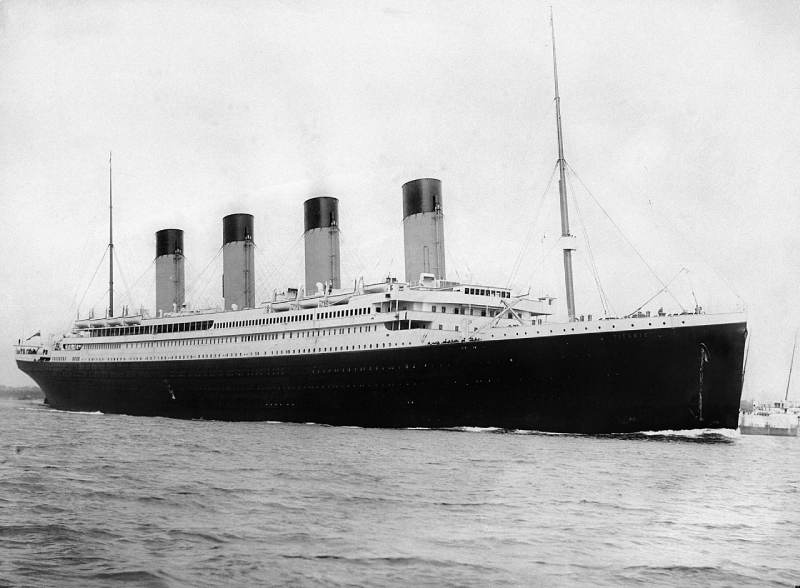
Although not technically a cruise ship in the modern sense, the Titanic was designed to be the largest and most luxurious ship of its time, a hallmark of today’s cruise ships. Its April 1912 inaugural voyage ended in tragedy, and it is now one of the most renowned maritime disasters in history.
On the night of April 14, 1912, four days into its journey from Southampton to New York City, the Titanic struck an iceberg in the North Atlantic Ocean. The collision caused the ship’s hull plates to buckle inwards along its starboard side and opened five of its sixteen watertight compartments to the ocean. Despite being touted as “unsinkable”, the Titanic was fatally damaged. The ship’s design allowed it to stay afloat if two compartments were flooded, but not more. As water spilled from one compartment into the next, the fate of the Titanic was sealed.
The sinking of the Titanic was a horrifying event, marked by acts of heroism and tragic loss. Of the estimated 2,224 passengers and crew aboard, more than 1,500 lost their lives, making it one of the deadliest peacetime maritime disasters in history. The ship also didn’t have enough lifeboats, which made the situation much worse.
The aftermath of the Titanic disaster led to many changes in maritime safety practices. The International Convention for the Safety of Life at Sea (SOLAS) was formed in 1914 to ensure that ships would be equipped with adequate lifeboat space for everyone on board, among other safety measures.
Sinking date: April 14, 1912 Deaths: 1,517 Survivors: 705 Maiden voyage: April 10, 1912 Length: 883 ft. (269 m) Original capacity: 2,453 passengers
RMS Empress of Ireland (1914)
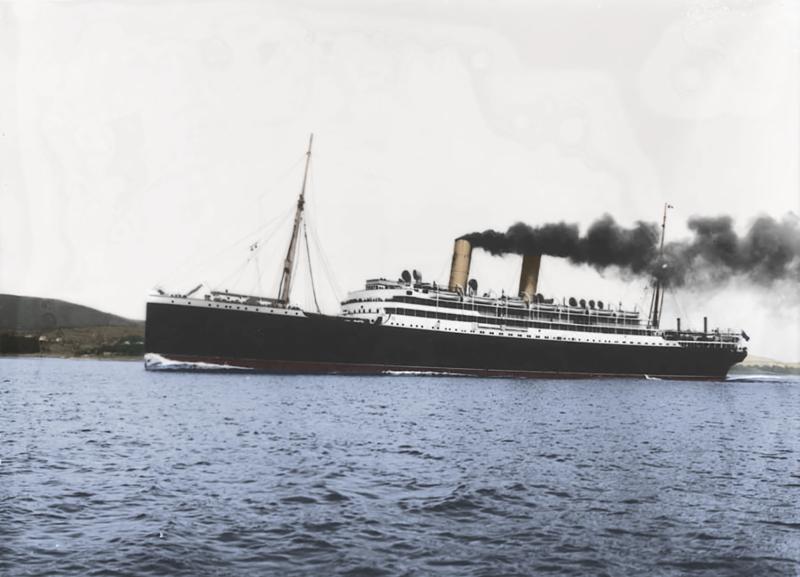
The sinking of the RMS Empress of Ireland is one of the most tragic maritime disasters in history. On May 29, 1914, the Empress of Ireland, a Canadian Pacific steamship, collided with the Norwegian collier SS Storstad in the Saint Lawrence River, near Pointe-au-Père, Quebec, Canada. The Empress was on her 96th transatlantic voyage, heading from Quebec City to Liverpool, England, with 1,477 passengers and crew aboard.
The collision occurred in the early hours, under a thick fog. The Storstad, carrying a load of coal, struck the Empress of Ireland on her starboard side, causing a gaping hole. The impact was devastating; the Empress began to sink rapidly, making many of the lifeboats unusable. Panic ensued as passengers and crew scrambled to escape the rapidly sinking ship. In less than 15 minutes, the Empress of Ireland sank into the cold waters of the Saint Lawrence River, claiming the lives of 1,012 people. Only 465 people survived the disaster.
Sinking date: May 29, 1914 Deaths: 1,012 Survivors: 465 Maiden voyage: June 29, 1906 Length: 574 ft. (175 m) Original capacity: 1,542 passengers
RMS Lusitania (1915)

The RMS Lusitania was a British ocean liner and one of the world’s largest and fastest passenger ships at the time. During World War I, on May 7, 1915, it was sunk by a German U-boat (submarine) off the southern coast of Ireland.
The Lusitania was en route from New York City to Liverpool, England, carrying 1,959 passengers and crew, along with a significant amount of cargo. Despite warnings from the German Embassy, the Lusitania set sail on what would be its final voyage.
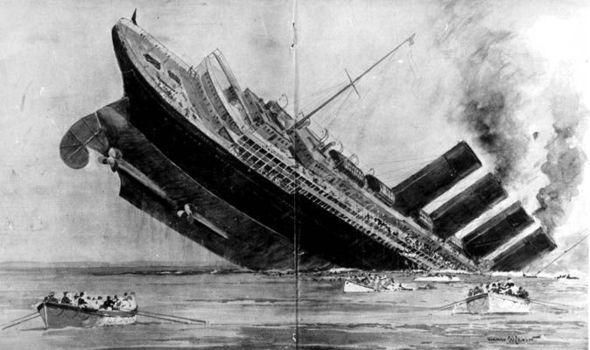
On the afternoon of May 7, the German U-boat U-20 fired a single torpedo at the Lusitania, which struck the starboard side of the ship. The explosion and a second internal explosion caused the Lusitania to sink in just 18 minutes, resulting in the deaths of 1,198 passengers and crew.
The sinking of the Lusitania caused an international outcry, particularly in the United States, where 128 American citizens were among the dead. The German government justified the attack by alleging that the Lusitania was carrying munitions and other contraband, making it a legitimate military target. This claim was partly substantiated.
Sinking date: May 7, 1915 Deaths: 1,197 Survivors: 761 Maiden voyage: September 13, 1907 Length: 787 ft. (240 m) Original capacity: 2,198 passengers
HMHS Britannic (1916)
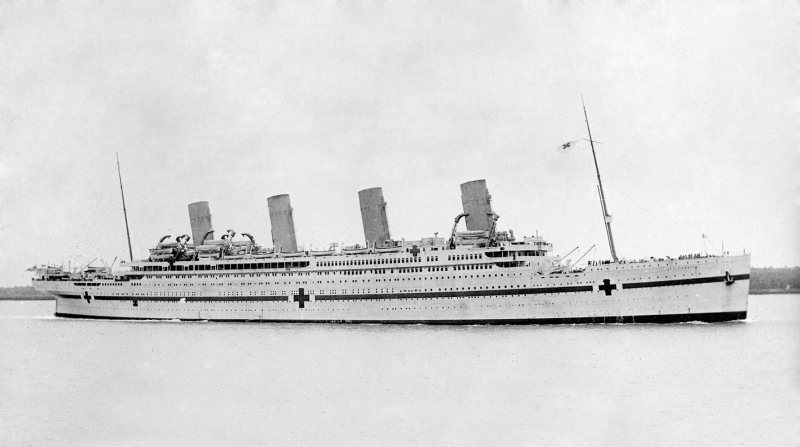
The HMHS Britannic, the third and largest of the Olympic-class ocean liners, was a sister ship of the RMS Titanic and RMS Olympic. Designed with luxury and safety in mind, the Britannic was launched just before the outbreak of World War I and was used as a hospital ship during World War I. It was on a mission to transport wounded soldiers from the Middle East back to Britain when it sank.
On the morning of November 21, 1916, while navigating through the Aegean Sea, near Greece, the Britannic struck a mine believed to have been laid by the German submarine U-73. The explosion caused severe damage to the starboard side of the ship. The Britannic began to flood rapidly and sank within 55 minutes of the explosion.

The evacuation was chaotic. Lifeboats were launched prematurely by panicked crew members, and some were sucked into the ship’s propellers, resulting in many casualties. Despite this, the majority of the 1,066 people on board were saved.
Today, the Britannic remains on its side at the bottom of the Aegean Sea. The wreck was discovered in 1975 by Jacques Cousteau and has since been explored by numerous expeditions. The sinking of the Britannic, while not as well known as the Titanic disaster, remains one of the greatest maritime tragedies of World War I.
Sinking date: November 21, 1916 Deaths: 30 Survivors: 1,036 Maiden voyage: December 23, 1915 Length: 882 ft. (269 m) Original capacity: 489 passengers
MS Georges Philippar (1932)

The MS Georges Philippar was a French ocean liner named after Georges Philippar, a prominent figure in the French shipping industry. The ship was part of the fleet of Messageries Maritimes, a major French shipping company. Its design was cutting-edge for the time, featuring luxurious accommodations and advanced safety features.
On its maiden voyage from Marseille to the Far East, tragedy struck in the Gulf of Aden, near the coast of Yemen. During the night, a fire broke out onboard, quickly spreading through the ship. Despite the crew’s efforts to contain it, the fire overwhelmed the ship’s safety measures. The passengers and crew faced a chaotic and desperate situation as the flames engulfed the liner.
The disaster led to significant loss of life, with many passengers and crew members perishing in the fire or drowning after abandoning ship. Investigations into the sinking of the MS Georges Philippar focused on the cause of the fire, which was believed to have started in a cargo hold, possibly due to improper storage of flammable materials.
Sinking date: May 16, 1932 Deaths: 41 Maiden voyage: May 16, 1932 Length: 543 ft. (165 m) Original capacity: 1,000+
SS Morro Castle (1934)
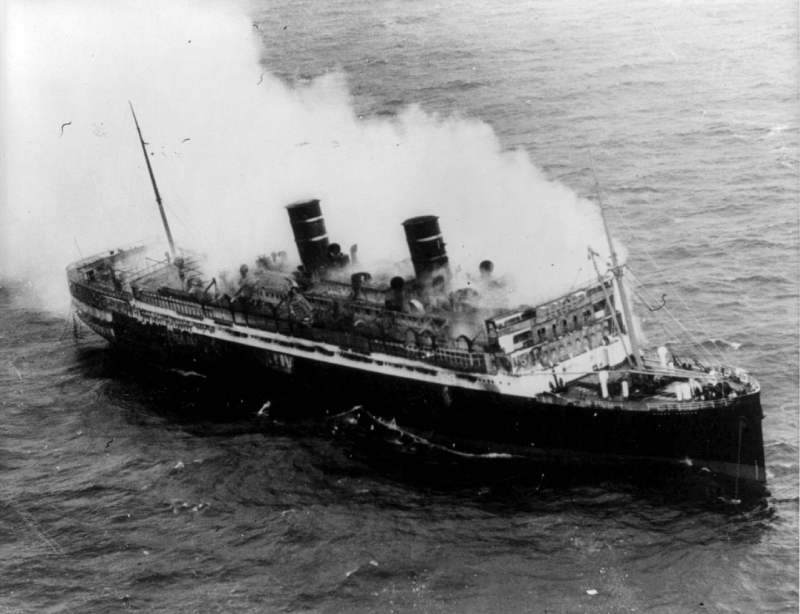
The SS Morro Castle was an American ocean liner that sank on September 8, 1934. The ship, which was named after the Morro Castle fortress that guards the entrance to Havana harbor, was en route from Havana, Cuba, to New York City when it caught fire and burned. This led to the deaths of 137 passengers and crew members out of the 549 people on board.
The fire began in the early hours of the morning under mysterious circumstances. The ship’s highly flammable materials helped the fire spread. The disaster was worsened by a lack of leadership following the death of the ship’s captain, Robert Wilmott, from an apparent heart attack the day before the fire. This left the crew without clear command and coordination, contributing to the chaotic evacuation and rescue efforts.
As the Morro Castle burned, it drifted closer to the shore, eventually grounding itself near Asbury Park, New Jersey. On March 14, 1935, the ship was being towed to a scrapyard when it supposedly sank and was then refloated. Though it is disputed whether or not it really sank.
Sinking date: March 14, 1935 (disputed) Deaths: 137 Survivors: 412 Maiden voyage: August 23, 1930 Length: 479 ft. (146 m) Original capacity: 3
RMS Empress of Britain (1940)
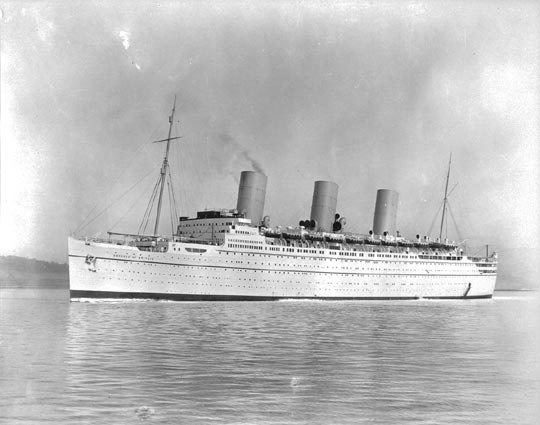
The RMS Empress of Britain, a majestic ocean liner of the early 20th century, met its tragic fate on October 28, 1940. While serving as a troopship during World War II, the vessel was torpedoed by a German U-boat off the coast of Ireland. The sinking of the Empress of Britain remains one of the most significant maritime disasters of any war.
The ship was en route from Liverpool, England, to Halifax, Nova Scotia, carrying nearly 2,000 passengers and crew, including military personnel, civilians, and refugees. In the darkness of the early morning hours, the U-32 fired two torpedoes at the Empress of Britain.
Despite efforts to save the ship, the Empress of Britain began to slowly sink. Within 30 minutes of being hit, the ship succumbed to the icy waters of the North Atlantic, sinking beneath the waves. 45 passengers and crew ended up perishing in the tragedy.
Sinking date: October 28, 1940 Deaths: 45 Survivors: 578 Maiden voyage: May 5, 1906 Length: 761 ft. (232 m) Original capacity: ~800
SS Andrea Doria (1956)

The SS Andrea Doria was an Italian ocean liner that launched in 1951. It was considered a symbol of Italian national pride and post-war recovery.
On the night of July 25, 1956, while en route to New York City from Genoa, Italy, the Andrea Doria collided with the MS Stockholm, a Swedish ocean liner, in heavy fog off the coast of Nantucket, Massachusetts.
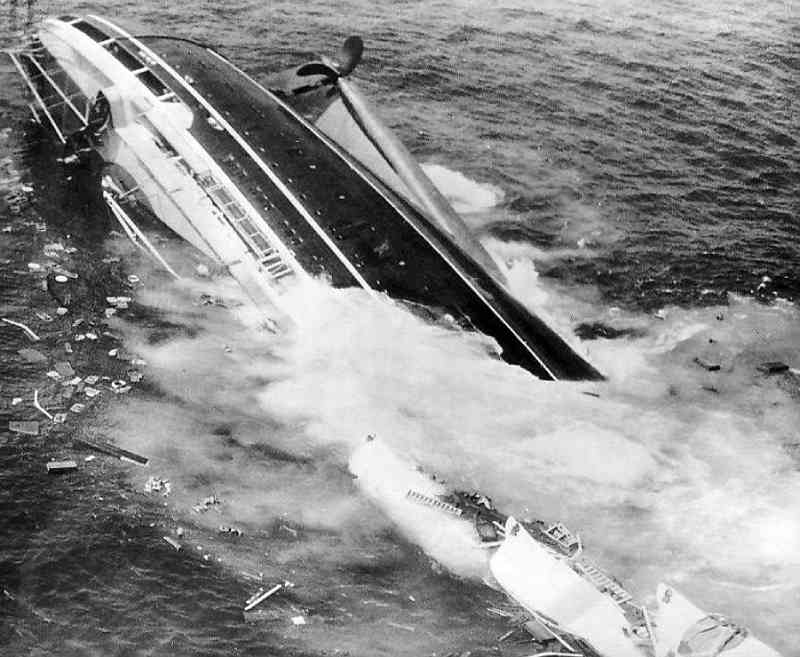
Despite having radar, the ships misinterpreted each other, leading to the catastrophic collision. The impact was devastating, tearing a huge hole in the side of the Andrea Doria and causing it to list severely to starboard.
Thanks to the efforts of the crew, nearby ships, and improved safety standards, nearly all of the Andrea Doria’s passengers and crew were saved. Unfortunately, the ship sank the following morning, about 11 hours after the collision.
Sinking date: July 26, 1956 Deaths: 51 Survivors: 753 Maiden voyage: January 14, 1953 Length: 701 ft. (214 m) Original capacity: 1,241 passengers
Angelina Lauro (1979)

Angelina Lauro, previously known as the MS Oranje, was a Dutch passenger ship that served as a hospital ship during World War II and later as a cruise ship. Launched in 1939 and operated initially by the Netherlands Lines, it was requisitioned by the Australian government during the war.
Post-war, it resumed passenger service, and faced a notable collision in 1953, which severely damaged its bow. The ship was sold to Lauro Lines in 1965 and Costa Lines in 1977. In 1979, while docked in Saint Thomas, U.S. Virgin Islands , a fire led to its total loss. The ship later sank in the middle of a storm while being towed to a scrapyard.
Sinking date: September 24, 1979 Deaths : 0 Maiden voyage: 1939 Length: 656 ft. (200 m) Original capacity: 740 passengers
MS Mikhail Lermontov (1986)

The MS Mikhail Lermontov, originally launched in 1972, was a Soviet ocean liner that was converted into a cruise ship. On the 16th of February, 1986, the MS Mikhail Lermontov had a tragic accident that led to its sinking.
While navigating the Marlborough Sounds in New Zealand, under the guidance of a local pilot, the ship struck rocks near Cape Jackson. The impact tore open the hull, and the MS Mikhail Lermontov sank within hours. At the time of the disaster, the cruise ship was carrying hundreds of passengers and crew on a cruise from Sydney, Australia, to New Zealand.
After the MS Mikhail Lermontov sank in 1986, both New Zealand and Soviet investigators looked into the accident and found that the pilot, Captain Don Jamison, was at fault. They pointed out that he chose a risky path that was too shallow. The investigators questioned his judgment, with a New Zealand official stating, “why he decided to guide the ship over a passage that he actually knew was too shallow, I don’t think he’ll ever be able to answer.”
Sinking date: February 16, 1986 Deaths: 1 Maiden voyage: May 28, 1973 Length: 578 ft. (155 m) Original capacity: 1,334 passengers
MV Jupiter (1988)
The MV Jupiter was a Greek-registered cruise ship that tragically sank on October 21, 1988, just 40 minutes after leaving the port of Piraeus, Greece. This ship was originally launched on February 19, 1961, as Moledet, serving the Zim Israel Navigation Company Ltd before being sold to Epirotiki Line in September 1970 and renamed Jupiter.
On the fateful day, the Jupiter had 391 British schoolchildren and 84 adults on a study cruise, along with a crew of 110 on board. The disaster resulted in the deaths of one pupil, one teacher, and two Greek crew members. The sinking occurred after the Jupiter collided with the Italian freight ship Adige, which tore a hole in the ship, causing it to sink.
Sinking date: October 21, 1988 Deaths: 4 Maiden voyage: March 19, 1974 Length: 218 ft (66 m) Original capacity: 531 passengers
MTS Oceanos (1991)
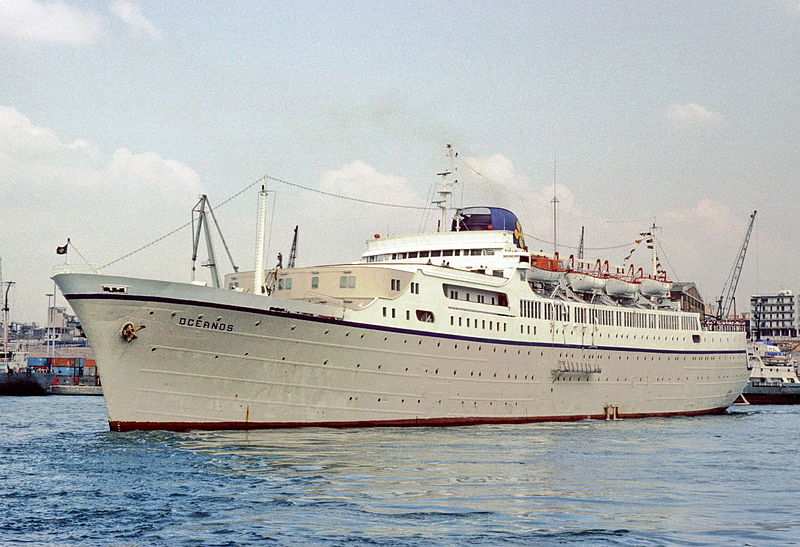
The MTS Oceanos was a Greek-owned cruise ship that was launched in 1952. On August 4, 1991, the ship became flooded and sank in severe weather off South Africa’s eastern coast.
The Oceanos set out from East London, South Africa, heading towards Durban, carrying 571 passengers and crew. The ship encountered rough seas and strong winds as it sailed along the Wild Coast. The disaster began to unfold when a leak in the engine room led to the failure of the power systems, leaving the ship without pumps to remove incoming water.
As the situation worsened, the ship’s captain abandoned the ship. This act of cowardice became one of the most talked-about aspects of the disaster. Fortunately, the entertainment staff, led by guitarist Moss Hills, took charge of the evacuation, proving instrumental in coordinating the rescue efforts. They used the ship’s radio to make distress calls, which were answered by nearby ships and helicopters.
The rescue operation was remarkable for its success under adverse conditions. All 571 people on board were saved, with no loss of life, thanks to the efforts of the South African Air Force and a Dutch cargo ship.
Sinking date: August 4, 1991 Deaths: 0 Survivors: 571 Maiden voyage: 1953 Length: 502 ft. (153 m) Original capacity: 550 passengers
MS Achille Lauro (1994)

The MS Achille Lauro was an Italian ocean liner most notorious for its hijacking by the Palestine Liberation Front in 1985. The ship met a tragic end when it sank in 1994 in the Indian Ocean. Originally built in 1947 as the MS Willem Ruys by the Royal Rotterdam Lloyd, it was named after Achille Lauro, an Italian businessman and politician, when it was purchased by the Lauro Line in 1965. The ship had an eventful career, serving as both a passenger liner and a cruise ship, traveling to many destinations around the world.
The end of the MS Achille Lauro came on November 30, 1994, while it was sailing off the coast of Somalia in the Indian Ocean. A fire broke out in the engine room and spread throughout the ship. Following the evacuation, the fire continued to rage uncontrollably, and the ship eventually succumbed to the damage.
The MS Achille Lauro eventually sank on December 2, 1994. Thankfully, most of the passengers and crew were evacuated safely, though the tragedy resulted in the loss of two lives.
Sinking date: December 2, 1994 Deaths: 2 Maiden voyage: December 2, 1947 Length: 630 ft. (192 m) Original capacity: 900 passengers
Sun Vista (1999)

The Sun Vista, originally an ocean liner named the SS Galileo Galilei, was a cruise ship that met its fate on May 20, 1999. The ship was in the Strait of Malacca, near Malaysia, when a fire broke out in the engine room. Despite efforts to control the fire, it spread rapidly throughout the ship.
The evacuation process involved more than 1,000 passengers and crew members, who had to abandon the ship and were rescued by lifeboats. The operation was carried out under challenging conditions but, fortunately, resulted in no loss of life.
Following the evacuation, the Sun Vista eventually sank in the early hours of May 21, 1999. The sinking of the Sun Vista was a significant loss in the cruise industry, marking the end of a ship that had served for almost 40 years.
Sinking date: March 23, 1963 Deaths: 0 Survivors: 1,090 Maiden voyage: May 21, 1999 Length: 702 ft. (214 m) Original capacity: 1,750 passengers
MS World Discoverer (2000)

The MS World Discoverer was a small cruise ship designed for navigating through polar waters, offering its passengers the unique experience of exploring some of the most remote areas of the world. Built in 1974 by Schichau Unterweser in Bremerhaven, West Germany, the ship was initially named BEWA Discoverer and was later renamed World Discoverer to reflect its mission of global exploration. The ship had a double hull, so it could safely navigate through ice-packed regions.
On April 30, 2000, the World Discoverer struck an uncharted reef in the Sandfly Passage, a narrow stretch of water in the Solomon Islands. The impact caused severe damage to the ship’s hull, leading to the immediate risk of sinking. The captain managed to beach the vessel nearby reef to prevent it from completely sinking and helped evacuate the passengers and crew.
Following the partial sinking, the MS World Discoverer became a subject of salvage operations. However, due to the remote location and the difficulty in accessing the wreck, the ship was never fully salvaged and remains stranded at Roderick Bay of the Nggela Islands, with a 46 degree tilt.
Sinking date: April 30, 2000 Deaths: 0 Maiden voyage: 1973 Length: 289 ft. (88 m) Original capacity: 137 passengers
MS Sea Diamond (2007)

The MS Sea Diamond was a cruise ship that sank off the coast of Santorini, Greece, in April 2007, leading to the deaths of 2 people. The incident occurred when the ship struck a reef and began taking on water. Despite efforts to control the flooding, the ship was evacuated within hours of the collision. The evacuation process, although chaotic, was largely successful, with most passengers and crew being safely transferred to rescue boats and taken to the island.
Two passengers, a Frenchman and his daughter, were reported missing and later presumed dead, marking a somber note in the otherwise successful evacuation effort. The loss of lives cast a shadow over the incident and led to questions about the ship’s safety procedures. The Greek authorities later launched an investigation into the causes of the sinking.
The sinking of the MS Sea Diamond caused severe environmental pollution. The ship contained large quantities of fuel and hazardous materials, posing a serious threat to marine life in the area. There were some efforts to contain and mitigate the environmental impact, though it’s not certain how effective they were.
Sinking date: April 5, 2007 Deaths: 2 Survivors: Over 1,590 Maiden voyage: April 22, 1986 Length: 469 ft. (143 m) Original capacity: 1,537 passengers
MV Explorer (2007)
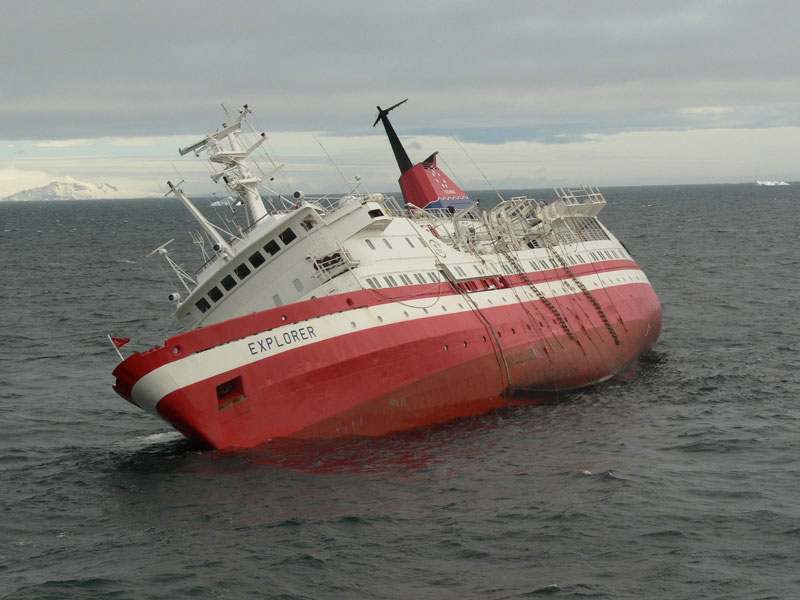
The MV Explorer, a Liberian-registered cruise ship built in 1969, gained infamy for its sinking in 2007 under dramatic circumstances. This vessel wasn’t an ordinary cruise ship; it was specifically designed for educational voyages in the Antarctic Ocean.
On November 23, 2007, the MV Explorer encountered trouble in the Bransfield Strait near the South Shetland Islands. The ship struck an iceberg, causing a fist-sized hole in the hull and leading to rapid flooding and the sinking of the ship. Despite the crew’s efforts to manage the situation, the damage was irreparable, and the decision was made to abandon ship. Remarkably, all the passengers, crew, and guides were saved. They waited for hours in the lifeboats until they were rescued by the Norwegian cruise ship MS Nordnorge.
The sinking of the MV Explorer serves as a stark reminder of the unpredictable nature of sea travel, especially in the perilous and icy waters of the Antarctic. The Liberian Bureau of Maritime Affairs carried an investigation into the sinking in 2009. The report found that there might have been an underestimation of the risks posed by icebergs in the vessel’s path.
Sinking date: November 23, 2007 Deaths: 0 Survivors: 154 Maiden voyage: 1969 Length: 239 ft. (73 m) Original capacity: 104 passengers
Costa Concordia (2012)
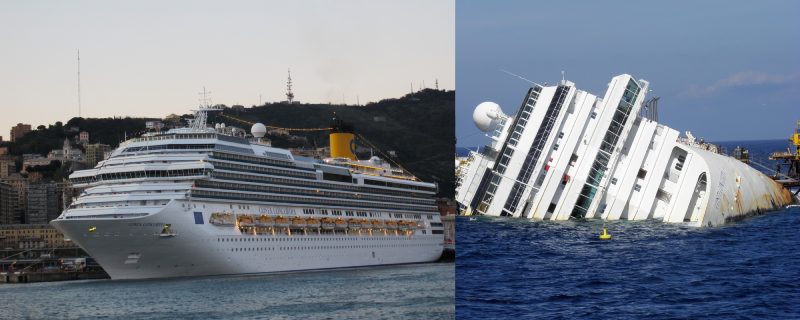
Perhaps the most well-known modern day maritime disaster is the partial sinking of the Costa Concordia. The large cruise ship struck a rock off the coast of Isola del Giglio, Italy, during a maneuver close to the island. This resulted in a large, 160 ft. (50 m) gash in its hull. The Costa Concordia then began to take on water and eventually tilted on its side, leading to a chaotic and panicked evacuation process.
The disaster resulted in the deaths of 32 people, who lost their lives due to various causes, including drowning and injuries sustained during the evacuation. Despite the tragic loss of life, there were many survivors, with over 4,200 people managing to escape the sinking ship. This included passengers from around the world and crew members, who faced harrowing conditions as they sought to flee the tilting vessel.
The captain of the Costa Concordia, Francesco Schettino, was heavily criticized for his actions during and after the collision. He was accused of bringing the ship too close to the shore in a maneuver known as a “salute,” and then abandoning the ship before ensuring that all passengers and crew were safely evacuated. His actions led to criminal charges, including manslaughter.
The ship remained partially submerged off the coast of Giglio for more than two years before a complex salvage operation successfully re-floated the ship so it could be towed away for scrapping.
Sinking date: January 13, 2012 Deaths: 32 Survivors: Over 4,200 Maiden voyage: July 14, 2006 Length: 951 ft. (290 m) Original capacity: 3,700 passengers
Oriental Star (2015)
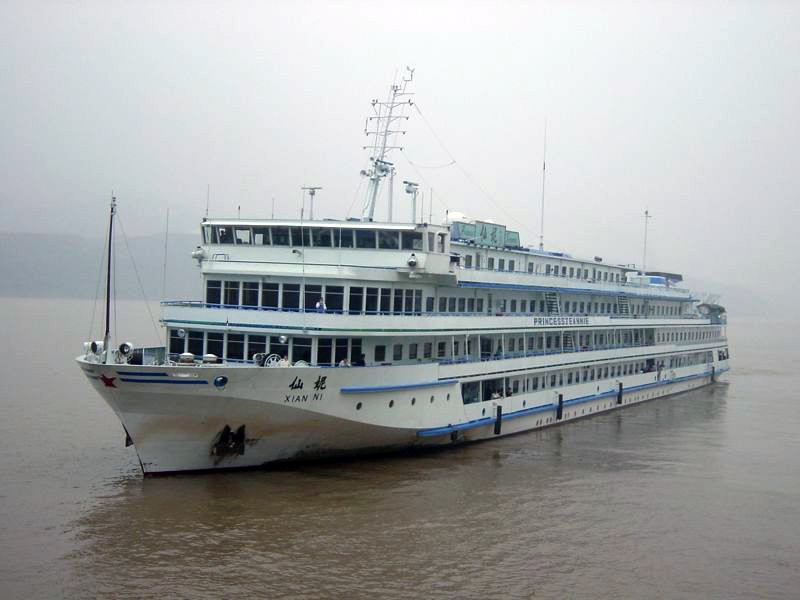
The sinking of the Oriental Star, also known as the Eastern Star, remains one of the most tragic cruise ship sinkings in recent times. On the evening of June 1, 2015, the Oriental Star was cruising through the waters of the Yangtze River in China when disaster struck.
As the cruise ship navigated the Yangtze River, it encountered a severe storm, including torrential rain and strong winds. These extreme weather conditions caused the ship to capsize suddenly, catching its passengers and crew off guard.
The Oriental Star, which was carrying 456 people onboard, mostly elderly tourists, was overwhelmed by the force of the storm. Within minutes, the ship had turned completely on its side, leaving only a small portion of its hull visible above the water. At the time of the sinking, most of the crew and passengers were asleep. Rescue efforts were immediately launched, with emergency responders and local authorities trying their best to save as many lives as possible.
Tragically, the majority of those onboard the Oriental Star did not survive the disaster. Only 12 passengers and crew members were rescued in the hours and days following the sinking. The final death toll numbered 442, making it one of the deadliest cruise ship sinkings in history.
After the sinking, Chinese authorities launched an investigation to find the cause and see if anyone was at fault. In the end 43 people were punished, though the Chinese media heavily censored the event so many details are unknown.
Sinking date: June 1, 2015 Deaths: 442 Survivors: 12 Maiden voyage: February 1994 Length: 251 ft. (76.5 m) Original capacity: 534 passengers
Orient Queen (2020)
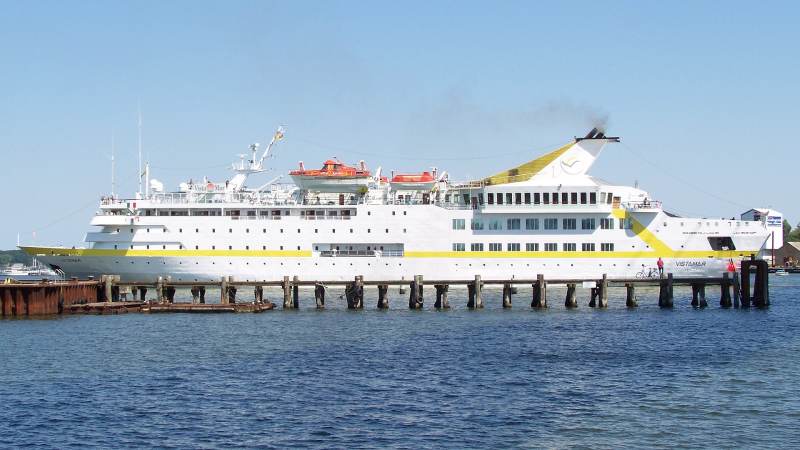
The Orient Queen was a cruise ship owned by Abou Merhi Cruises, under which it sailed primarily in the Eastern Mediterranean. The tragic sinking of the Orient Queen occurred in August 2020, as a direct consequence of the massive explosion in the port of Beirut.
On the 4th of August, a large quantity of ammonium nitrate stored at the port detonated, resulting in one of the most powerful non-nuclear explosions in history. The blast caused widespread damage throughout the city of Beirut, killing over 200 people, injuring thousands, and causing extensive property damage.
The Orient Queen, which was moored in the port of Beirut at the time of the explosion, suffered severe damage due to the shockwave and the subsequent flooding. The impact of the explosion was so significant that it led to the ship partially sinking. The event resulted in the loss of two lives among the crew members aboard the ship. The explosion also damaged other ships nearby..
Sinking date: June 27, 2020 Deaths: 2 Maiden voyage: 1989 Length: 423 ft. (129 m) Original capacity: 300 passengers
How Many Cruise Ships Have Sunk? – FAQ
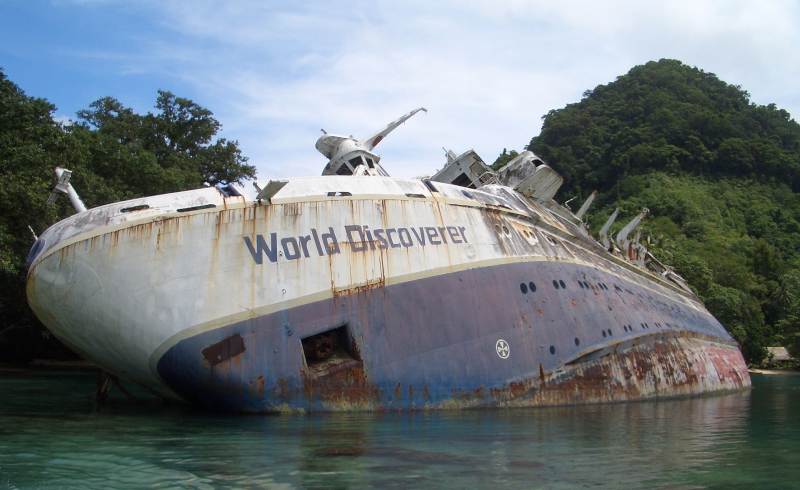
When was the last time a cruise ship sank?
The last recorded sinking of a cruise ship was the Orient Queen in 2020. The ship sank as a result of the massive explosion that occurred in the port of Beirut, Lebanon, on August 4, 2020. This tragic event was caused by the detonation of a large quantity of ammonium nitrate stored at the port.
The blast was so powerful that it caused significant damage across a large portion of the city, including the port area where the Orient Queen was docked. The force of the explosion inflicted critical damage to the vessel, ultimately leading to its sinking.
What are the odds of a cruise ship sinking?
The odds of a cruise ship sinking are approximately 1 in 273,000, or about 0.00037%, indicating an extremely low probability. This calculation is based on the assumption of 300 cruise ships each conducting 50 sailings annually over the last 50 years, with only 11 ships sinking during this period.
Despite the significant number of sailings—amounting to 750,000 over half a century—the safety record of cruise travel remains exceptional, emphasizing the rarity of such incidents amidst the millions of passenger experiences.

Why don’t cruise ships sink?
Cruise ships are designed with buoyancy and stability in mind, allowing them to float despite their massive size. This is primarily due to their hulls, which are large and hollow, creating a displacement effect that pushes water away, ensuring that the weight of the water displaced is equal to or greater than the weight of the ship. This principle, known as Archimedes’ principle, is key to keeping ships afloat.
Additionally, cruise ships are compartmentalized into watertight sections, which can be sealed off in the event of a breach in the hull, preventing water from filling the entire ship and maintaining buoyancy. Modern cruise ships also incorporate advanced stability technologies and are meticulously designed and tested to ensure they remain upright and stable, even in rough seas.

What was the largest cruise ship that sank?
The Costa Concordia is considered the largest cruise ship to have capsized and sunk. This tragic event occurred on January 13, 2012, when the ship struck a reef off the coast of Isola del Giglio, Italy, leading to a significant breach in its hull. The ship eventually partially sank near the island’s shore. At the time of the incident, the Costa Concordia was among the largest cruise ships in operation, measuring about 114,500 gross tons, with a length of 952 feet (290.20 meters) and a capacity to carry 4,232 passengers and crew.
Final Words
Cruise ship sinkings are very rare, especially considering the vast number of ships that sail the world’s oceans every year.
The cruise industry has seen significant advancements in technology and the implementation of strict safety protocols. These measures, coupled with international regulations, contribute to making cruising a safe form of travel.
Modern ships are equipped with state-of-the-art navigation systems, emergency response procedures, and construction standards that exceed what was available in the past. So these days, the chance of your cruise ship sinking is extremely low.
Adam Stewart
Adam Stewart is the founder of Cruise Galore. He is a passionate traveler who loves cruising. Adam's goal is to enhance your cruising adventures with practical tips and insightful advice, making each of your journeys unforgettable.

How Often do Cruise Ships Sink?
Whether you’ve seen the Titanic, heard about Costa Concordia, or are thinking of booking a cruise, one of the most common questions new cruisers ask to assess their safety is how often cruise ships sink.
To give you a quick insight into how often cruise ships sink, we list below the vessels that have sunk and then go over each in more detail so you get a full understanding of the situation and the likelihood of a cruise ship ever sinking again.

How Many Cruise Ships Have Sunk?
16 cruise ships have sunk since 1912, which was the year the Titanic sank.
The first 6 sinkings up to 1956 were technically all ocean liners rather than cruise ships, but many people think of them as the same because they both can carry thousands of passengers.
See the post was the Titanic a cruise ship for a look at the key differences, some of which made ocean liners more likely to sink than a modern-day cruise ship.
Of the 16 cruise ship sinkings, one was a Chinese River cruise ship, and another was an Estonian cruiseferry, so not technically a cruise ship, but still similar in many ways with the capacity for carrying hundreds of passengers.
Of the ocean-going cruise ships, not all sunk while out at sea. In some instances, they didn’t even have passengers onboard.
Depending on what angle you are asking the question, the below table of cruise ship sinkings should help you find your answer.
Cruise Ship Sinkings Since the Titianic (1912 )
The table below details 16 cruise ships of various cruise vessel types that have sunk since the Titanic in 1912.
We have included vessel type, as arguably it said some of the vessels weren’t technically cruise ships, but we think most people think of the Titanic as a cruise ship, so we have included it and other similar ocean liners.
Considering there are more cruise ships than ever on the seas today, it’s clear that not many cruise ships have sunk in recent times.
How Many Cruise Ships Sink a Year?
With 16 cruise ship sinkings from 1912 to 2022, we can determine that a cruise ship sinks every 6 years 10 months.
On average, that works out as a lot less than 1 cruise ship a year. Just 0.15% of a cruise ship, to be precise.
The answer to this question will vary depending on your chosen timeframe, vessel type, and the reason for sinking.
For example, do you want to include ocean liners and a cruiseferry and do you want to include cruise ships that were empty and on the way to being scrapped?
When Was the Last Time a Cruise Ship Sunk?
The last time an ocean-going cruise ship sank was in 2012, when the Costa Concordia hit a reef off the coast of Italy. Thirty-two people died in the incident. 4200 were rescued.
The sinking of the Costa Concordia is probably the most familiar cruise ship people think of when they ask this question. Although the cruise ship only partially sank, it did not become completely submerged beneath the surface of the water.
Since 2012 there have been no other recorded sinkings of ocean-going cruise ships.
Although the almost empty moored Orient Queen cruise ship sank in 2020 when it was damaged in a huge explosion in Beirut, Lebanon, it capsized that same night. Two crew members died.
How Often Do Cruise Ships Sink?
Thankfully the answer is very rarely, but there have been a few notable instances where cruise ships have met with accidents leading to sinking.
From the table, we can see that in 110 years, 16 cruise ships have sunk. This means, on average, 1 cruise ship sinks every 6.8 years.
However, in more modern times, since 2000, only 4 cruise ships have sunk while out at sea, an average of once every 5.5 years.
It does depend on what type of cruise ship you are considering and the situation in which it sank, at sea or empty at the port, destroyed in an explosion (Orient Queen) or awaiting to be scrapped anyway (Belofin-1 ).
Thankfully, when you think of the number of cruise ships launched into the water and currently sailing oceans, rivers, and great lakes all over the world cases like these are rare. Cruise ships have become much safer over the years and much less likely to ever sink.
As you can see, it’s very rare for a cruise ship to sink, but it does happen on occasion. In most cases, the cause is weather-related or due to hitting an obstacle like a reef or iceberg. However, there’s always the chance of a rogue wave event, which has been suspected of sinking other ship types, but thankfully not a cruise ship.
So now that we’ve answered the question of how often cruise ships sink, let’s take a more in-depth look at each of the four major instances where this unfortunate event has happened.
Well-Known Cruise Ships That Sunk
Here’s a look at some of the most famous (or infamous) cases of cruise ships sinking.
The Titanic is, without a doubt, the most famous cruise ship to ever sink. The vessel hit an iceberg on its maiden voyage in 1912 and went down, taking over 1,500 passengers and crew with it, partly because it did not have enough lifeboats for all passengers.
At the time, the Titanic was the largest and most luxurious ship ever built. It was meant to be an unsinkable vessel, but of course, we all know now that no ship is truly unsinkable.
The sinking of the Titanic is a tragic story that has been told time and time again. It’s one of the most famous maritime disasters in history and has been the subject of numerous books, movies, and TV shows.
4 years later in 1916, the Titanic sister ship, the HMHS Britannic , which had been turned into a hospital ship, was famously sunk by a German mine.
Some people might question, was the Titanic a Cruise Ship ? Technically it was an ocean liner, but because it carried thousands of passengers and is thought to be a cruise ship by many, we have included it.
Costa Concordia
In the past, many ships that sank 100 or so years ago were ocean liners and nothing like the mega-cruise ships carrying thousands of passengers at a time.
The Costa Concordia was a much more recent example of a cruise ship sinking of the large modern-day design many of us know and love.
The vessel hit a reef off the coast of Italy in 2012 and capsized, killing 32 people.
The Costa Concordia was carrying 4,229 passengers and crew at the time of the incident. Thankfully, most people were able to evacuate the ship before it sank.
The captain of the Costa Concordia was later convicted of manslaughter and sentenced to 16 years in prison. One year of that sentence was for leaving the ship early instead of being the last to leave as per one of the duties of a highly-paid cruise captain salary .

In 1994, the MS Estonia sank in the Baltic Sea after hitting a storm, killing 852 people.
The MS Estonia was a cruise ferry carrying 989 passengers and crew at the time of the incident. It was traveling from Tallinn, Estonia to Stockholm, Sweden, when it hit a storm and started taking on water.
The MS Estonia quickly sank, and only 137 people were able to be rescued from the frigid waters. It is considered one of the deadliest maritime disasters of the 20th century.
Dongfang zhi Xing ( Oriental Star or Eastern Star )
The Dongfang Zhi Xing (translated as Oriental Star or Eastern Star ) was a Chinese river cruise ship that capsized in 2015 during a heavy storm. 442 people were killed in the incident.
The Dongfang zhi Xing was carrying 454 passengers and crew at the time of the accident. Only 12 people were able to be rescued from the ship.
The cause of the capsizing was determined to be a severe storm that caused the ship to lose stability and tip over .
Other Cruise Ships That Sank
Prior to 1991, only ocean liners, like the Titanic and cruiseferries had sunk.
Since the year 1991, there have been 8 cruise ship sinkings, or partial sinkings (not including the cruiseferry MS Estonia)
Excluding Costa Concordia and Dongfang zhi xing, which we covered above, there have been 6 other cruise ship sinkings.
MTS Oceanos (1991)
The Oceanos was a French-built Greek-owned cruise ship that sank off the coast of South Africa in 1991. The vessel started taking on water after a series of leaks in the hull.
The ship had a capacity of 550 passengers and 250 crew.
All passengers and crew were successfully evacuated from the ship before it completely sunk. No one was killed or injured in the incident.
However, the captain and some crew members were later arrested and convicted of negligence for fleeing the ship while passengers were still on board.
Sun Vista (SS Galileo Galilei) (1999)
The SS Sun Vista was a cruise ship that caught fire and sank in 1999. The fire started in the vessel’s engine room while it was sailing from Malaysia to Singapore.
All 1,090 passengers and crew were evacuated from the ship before it sank. No one was killed but some people were injured in the incident and needed hospitalization.
Sun Vista was the name at the time of the sinking. The ship was originally built as the ocean liner SS Galileo Galilei and later converted to a cruise ship.
Passengers reportedly sang music from the Titanic movie to keep their spirits up. ( Source ).
MS Sea Diamond (2007)
The MS Sea Diamond was a Finnish cruise ship that sank off the coast of Santorini, Greece, in 2007. The vessel hit a volcanic reef and started taking on water.
The cruise ship had a capacity of 1537 passengers, with 1,195, mostly American and Canadian onboard at the time of the incident.
All passengers and crew were evacuated from the ship before it completely sunk. 2 people were killed in the incident.
This short video captures the cruise ship sinking in its final moments.
SS SeaBreeze (2000)
The SeaBreeze cruise ship sank off the coast of North Carolina in December 2000. This was allegedly due to a boiler breaking off and damaging the ship and the engine room flooding.
Coast guard rescuers at the time did not expect the ship to sink and thought it could be towed to shore by tug boats, but the captain demanded everyone be extracted from the ship as soon as possible.
Subsequently, the ship sank in Panamanian waters, which was potentially convenient as any investigation would have expected to have been much less stringent than those carried out by American investigators had it sunk in very nearby American waters.
There was much suspicion around the sinking because the scrap value of the ship was estimated to be around $5 to $6 million, which was much less than its insurance payout value of $20 million.
The cruise ship had a capacity of 840 passengers and 400 crew.
At the time of the incident, there were 34 people all onboard who were all extracted to safety.
Belofin-1 (SS Monterey ) (2000)
The Belofin-1 had recently been sold for scrap and was meant to be being towed to India, but went via Mexico from Ukraine in 2000 when it sank near just over 90km from Cape Town, South Africa.
The vessel started taking on water and listing, so the tug boats cut here free and allowed how to sink.
The ship was previously known as the SS Monterey and had a capacity for 701 passengers and 360 crew.
MV Explorer (2007)
The MV Explorer was a small Liberian cruise ship and the first of its kind to sail the Antarctic waters.
The ship had departed from Argentina, attempting to follow the route of 19th-century explorer Ernest Shackleton through the Drake Passage,a route well known for its rough seas.
The vessel sank in early November 2007 after hitting an iceberg which made a gash in the hull, allowing water to enter.
The ship had a capacity for a total of 104 passengers and 54 crew.
On the day of the incident 154 passengers, guides and crew were successfully evacuated from the ship before it sunk.
There were no fatalities or injuries as a result of the incident.
The video news report below shows photos of the listing ship and passengers being rescued.
Orient Queen (2020)
The Orient Queen was a Spanish cruise ship that was berthed in Beirut, Lebanon, at the time of a huge explosion of a large amount of ammonium nitrate stored at the port.
The ship suffered severe damage and capsized that night before partially sinking.
It was quite small by modern standards, with a capacity of 370 guests.
Two crew members were killed.
How Many Carnival Cruise Ships Have Sunk?
Carnival is one world’s largest cruise lines, but since it has existed, only one of its vessels has ever sunk, the Costa Concordia in 2012.
Although Costa is an Italian cruise ship company, it is owned by Carnival Corporation.
From its fleet of Carnival brand cruise ships, none have ever sunk or capsized.
There have been less serious incidents, such as in 2010, the Carnival Splendor had to be towed to port after an engine room fire disabled the vessel.
A more recent and well-known incident was that of a fire on Carnival Triumph, since renamed Carnival Sunshine. The ship was left stranded and without power after the generator caught fire.
Infamously the incident led to the ship being referred to as “the poop cruise” because raw sewage backed up onto the passenger decks and passengers had to use plastic bags as a makeshift solution. It’s no wonder they renamed it.
Why Don’t Cruise Ships Tip Over or Sink?
There are many reasons why a cruise ship sinking is such a rare event, and that’s because of how they are designed.
Although many modern-day cruise ships look top-heavy, with relatively small proportions of the ship underwater , it’s no surprise people wonder if a cruise ship can tip over .
They are designed to have a low center of gravity, with most of the weight at the bottom of the ship . A wide, stable hull and other stabilizing factors, such as ballast tanks, stabilizing fins, and bilge keels, keeps a ship upright in even the roughest of sea conditions.
Frequently Asked Questions
How many cruise ships have sunk in the last 5 years.
In the last 5 years since 2017, only one cruise ship has sunk, the Orient Queen, which was damaged in a port explosion in Lebanon.
How Many Royal Caribbean Ships Have Sunk?
There have been no recorded instances of a Royal Caribbean cruise ship sinking.
Has a Disney Cruise Ship Ever Sunk?
No Disney cruise ships have ever sunk or capsized.
Conclusion: What Can We Learn From These Incidents?
While it’s certainly tragic when a cruise ship sinks, it’s important to remember that these incidents are rare.
The Titanic is the most famous example of a cruise ship sinking, but it happened over 100 years ago.
The Costa Concordia, MS Estonia, and Dongfang zhi Xing are more recent examples, but they are still relatively rare.
When you compare the number of cruise ship passengers to the number of incidents, it’s clear that cruising is a safe way to travel.
Of course, no one wants to be on a ship that sinks, so it’s important to do your research before booking a cruise. If you are concerned, check the ship’s safety record and ensure it meets all required safety standards.
Cruising is a great way to see the world and is generally very safe.
Related Posts

What is the Draft of a Cruise Ship? (and Why Does it Matter?)

How Many Doors on a Cruise Ship? (Yes, I Counted)
Leave a comment cancel reply.
Your email address will not be published. Required fields are marked *
Save my name, email, and website in this browser for the next time I comment.
'We all suffer from PTSD': 10 years after the Costa Concordia cruise disaster, memories remain
GIGLIO, Italy — Ten years have passed since the Costa Concordia cruise ship slammed into a reef and capsized off the Tuscan island of Giglio. But for the passengers on board and the residents who welcomed them ashore, the memories of that harrowing, freezing night remain vividly etched into their minds.
The dinner plates that flew off the tables when the rocks first gashed the hull. The blackout after the ship's engine room flooded and its generators failed. The final mad scramble to evacuate the listing liner and then the extraordinary generosity of Giglio islanders who offered shoes, sweatshirts and shelter until the sun rose and passengers were ferried to the mainland.
Italy on Thursday is marking the 10th anniversary of the Concordia disaster with a daylong commemoration that will end with a candlelit vigil near the moment the ship hit the reef: 9:45 p.m. on Jan. 13, 2012. The events will honor the 32 people who died that night, the 4,200 survivors, but also the residents of Giglio, who took in passengers and crew and then lived with the Concordia's wrecked carcass off their shore for another two years until it was righted and hauled away for scrap.
► CDC travel guidance: CDC warns 'avoid cruise travel' after more than 5,000 COVID cases in two weeks amid omicron
“For us islanders, when we remember some event, we always refer to whether it was before or after the Concordia,” said Matteo Coppa, who was 23 and fishing on the jetty when the darkened Concordia listed toward shore and then collapsed onto its side in the water.
“I imagine it like a nail stuck to the wall that marks that date, as a before and after,” he said, recounting how he joined the rescue effort that night, helping pull ashore the dazed, injured and freezing passengers from lifeboats.
The sad anniversary comes as the cruise industry, shut down in much of the world for months because of the coronavirus pandemic, is once again in the spotlight because of COVID-19 outbreaks that threaten passenger safety. The U.S. Centers for Disease Control last month warned people across-the-board not to go on cruises, regardless of their vaccination status, because of the risks of infection.
► 'We found out while we were flying': Last-minute cruise cancellations leave travelers scrambling
► 'The Disney magic is gone' ... or is it?: Longtime fans weigh in on changes at Disney World
'We all suffer from PTSD'
For Concordia survivor Georgia Ananias, the COVID-19 infections are just the latest evidence that passenger safety still isn’t a top priority for the cruise ship industry. Passengers aboard the Concordia were largely left on their own to find life jackets and a functioning lifeboat after the captain steered the ship close too shore in a stunt. He then delayed an evacuation order until it was too late, with lifeboats unable to lower because the ship was listing too heavily.
“I always said this will not define me, but you have no choice," Ananias said in an interview from her home in Los Angeles, Calif. “We all suffer from PTSD. We had a lot of guilt that we survived and 32 other people died.”
Prosecutors blamed the delayed evacuation order and conflicting instructions given by crew for the chaos that ensued as passengers scrambled to get off the ship. The captain, Francesco Schettino, is serving a 16-year prison sentence for manslaughter, causing a shipwreck and abandoning a ship before all the passengers and crew had evacuated.
Ananias and her family declined Costa’s initial $14,500 compensation offered to each passenger and sued Costa, a unit of U.S.-based Carnival Corp., to try to cover the cost of their medical bills and therapy for the post-traumatic stress they have suffered. But after eight years in the U.S. and then Italian court system, they lost their case.
“I think people need to be aware that when you go on a cruise, that if there is a problem, you will not have the justice that you may be used to in the country in which you are living,” said Ananias, who went onto become a top official in the International Cruise Victims association, an advocacy group that lobbies to improve safety aboard ships and increase transparency and accountability in the industry.
Costa didn’t respond to emails seeking comment on the anniversary.
► Royal Caribbean cancels sailings: Pushes back restart on several ships over COVID
'We did something incredible'
Cruise Lines International Association, the world’s largest cruise industry trade association, stressed in a statement to The Associated Press that passenger and crew safety was the industry's top priority, and that cruising remains one of the safest vacation experiences available.
“Our thoughts continue to be with the victims of the Concordia tragedy and their families on this sad anniversary," CLIA said. It said it has worked over the past 10 years with the International Maritime Organization and the maritime industry to “drive a safety culture that is based on continuous improvement."
For Giglio Mayor Sergio Ortelli, the memories of that night run the gamut: the horror of seeing the capsized ship, the scramble to coordinate rescue services on shore, the recovery of the first bodies and then the pride that islanders rose to the occasion to tend to the survivors.
► Cruising during COVID-19: Cancellation, refund policies vary by cruise line
Ortelli was later on hand when, in September 2013, the 115,000-ton, 1,000-foot long cruise ship was righted vertical off its seabed graveyard in an extraordinary feat of engineering. But the night of the disaster, a Friday the 13th, remains seared in his memory.
“It was a night that, in addition to being a tragedy, had a beautiful side because the response of the people was a spontaneous gesture that was appreciated around the world,” Ortelli said.
It seemed the natural thing to do at the time. “But then we realized that on that night, in just a few hours, we did something incredible.”

How Often Do Cruise Ships Sink?
By: Author David Chapman
Posted on Last updated: February 21, 2024
Categories Health & Safety , LEARN
Modern cruise ships are engineered to withstand the toughest conditions and offer the utmost safety and reliability. Nevertheless, people may wonder how often do cruise ships sink.
The short answer: It’s rare. In the last 50 years, a ship has sunk during the course of a cruise less than once per decade.
Nevertheless, while it rarely happens, we can all easily think of terrible disasters where it did happen – such as the century-old disaster of the RMS Titanic or the decade-old capsize of Costa Concordia. So, how often do these modern marvels of the sea meet a similar fate? The best way is to dive into the history of known cruise ship sinkings to understand the probability of it happening to today’s state-of-the-art vessels.
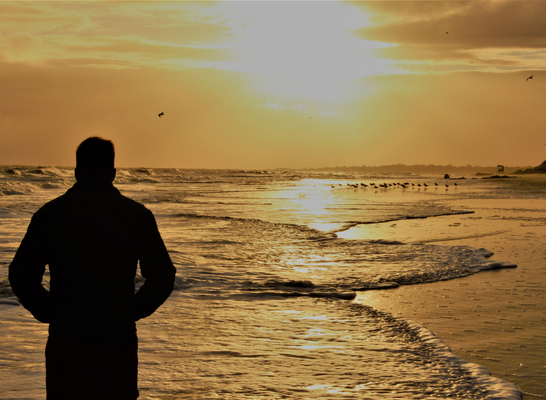
How Often Do Cruise Ships Sink? It’s Rare!
Cruise ships are some of the largest and most luxurious vessels on the water and are designed to be safe and reliable. However, it is not uncommon for cruise ships to encounter problems at sea; in some cases, these problems can lead to the ship’s sinking. Over the past 100 years since the RMS Titanic sank in 1912, only 18 cruise ships and some ocean liners have been publicly known to have sunk. And, over the past 50 years , only four cruise ships have sunk while navigating on a cruise .
To fully understand the rarity of a cruise ship sinking, let’s examine the known causes of these disasters, beginning with the iconic RMS Titanic.
Exploring Past Sunk Cruise Ships – RMS Titanic In 1912 To Orient Queen In 2020
The RMS Titanic was a luxurious passenger liner known for its grandeur and advanced safety features. Even though the Titanic was an ocean liner rather than a cruise ship , it was the largest ship of its time and was thought to be unsinkable due to its watertight compartments. However, on April 15, 1912 , the Titanic struck an iceberg, broke in half, and sank in the North Atlantic Ocean, resulting in the loss of over 1,500 lives.
The Titanic disaster profoundly impacted the maritime industry and sparked significant changes in how ships were designed and built. One major factor that contributed to the number of lives lost during the sinking was the lack of enough lifeboats on board.
The ship was carrying only enough lifeboats for about half of the passengers and crew, which proved to be a tragic oversight when the ship began to sink.
As a result of the Titanic disaster, new regulations were put in place to ensure that all passenger ships, including cruise ships, were required to carry sufficient lifeboats for passengers and crew on board. Additionally, new safety standards were implemented to improve ships’ design and construction, including stronger materials and more watertight compartments.
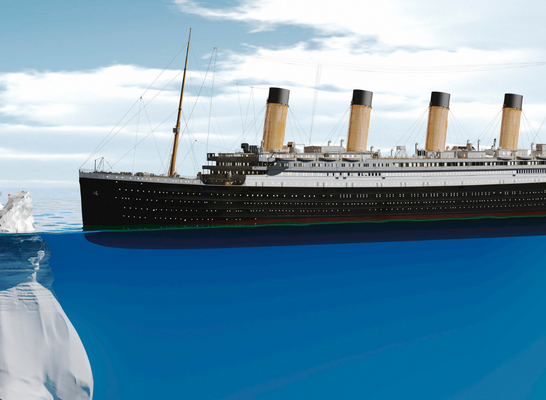
Fortunately, since 2020, no confirmed cruise ship capsizing or sinking has occurred. The last one was the Orient Queen suffering no crew or passenger casualties, which sank due to a nearby ammonium nitrate explosion while moored.
Below is a list of some available records of cruise ship sinkings since the iconic Titanic .
Comparing 20th To 21st Century Maritime Disasters
The tale of two disasters – the Titanic and the Costa Concordia – highlights the importance of ship design in terms of safety. When the Titanic collided with the iceberg in 1912, it tore a 300-foot gash in the ship’s hull, sending freezing water flooding into the base of the vessel.
This caused the back of the ship to tilt upward, leading to a catastrophic breakage that made it harder to evacuate. The lack of lifeboats was also a major factor in the high death toll of over 1,500 people, making it one of the worst peacetime maritime disasters in history.
Fast forward to 2012, and the Costa Concordia disaster (now more than ten years ago) off the coast of Italy provides a modern-day equivalent. When the cruise ship struck a rock reef, it tore a 16-foot gash in the hull around 25 feet below sea level. The ship began flooding, the engines and generators went offline, and it began to sink.
However, the ship’s design allowed it to lean heavily to its side and sink much more slowly, allowing the crew to initiate a hasty evacuation. Thanks to a sufficient supply of lifeboats, they evacuated the passengers over six hours, ultimately resulting in a death toll of 34 people. Most of these deaths were caused by the ship tilting and passengers falling into the water.
Three people were even rescued from the ship over 24 hours after the incident, thanks to the slow sinking of the vessel. While the Costa Concordia disaster was one of the worst maritime disasters of the 21st century, it was nowhere near as catastrophic in terms of loss of life as the disasters of the 20th century.
When you compare modern cruise ships to Titanic-era ships , you can readily see that safety has improved considerably. As demonstrated in the table shown above by the low number of cruise ships to sink in recent history, modern vessels are generally better equipped to survive a disaster than their predecessors. And as you saw, the number of lives lost had decreased to nearly zero.

Why Don’t Modern Cruise Ships Sink As Often?
When people buy tickets for a cruise, they’re not just looking for a vacation – they’re also buying safety and peace of mind. They want to know that their needs will be taken care of and that they will be safe for the duration of the trip. And cruise ships are designed with this in mind. These floating resorts are built to withstand all sorts of rough conditions that would have sunk ships of the past.
But it hasn’t always been this way. During the heyday of sea travel, it was fairly common for ships to be lost at sea due to rough weather, enemy attacks, or collisions with icebergs. However, the sinking of the Titanic in 1912 and the RMS Empress of Ireland in 1914 made it clear that something needed to change.
These were both sturdy ships and were ocean liners built for long-distance travel. But to achieve this reliability, they sacrificed maneuverability. They would be rock-solid if everything went according to plan, but there was little hope of saving the voyage if something went wrong.
Today, however, cruise ships are a different story. These vessels are typically made of lighter materials and are much more agile, allowing them to navigate rough seas easily.
Cruise Ship Stability: What Keeps Them Afloat?
Have you ever wondered how cruise ships manage to stay afloat despite their massive size and seemingly top-heavy design? This is often a big topic of discussion, and the answer lies in the careful balance of weight distribution and stability.
When you board a large cruise ship, you are stepping onto a floating resort with thousands of staterooms, dozens of restaurants, and endless recreation opportunities. Yet, despite all these amenities, cruise ships remain stable and steady on the water despite their weight.
This is thanks to a combination of factors, including the ships:
- Machinery’s placement
- Stabilizer fins use
- Modern navigation systems
So how does it all work? First, it’s important to understand that only a small portion of the ship is actually below the waterline. This means that most of the weight is concentrated above the water, making the ship appear top-heavy. But the ship’s design actually works in its favor, pulling down on the water to provide balance and stability.
The key to this balance is the ship’s center of gravity. While the goal is to keep the center of gravity as close to the ship’s middle as possible, this is not always possible due to the weight of the ship’s engines and other machinery. As a result, ships usually have a heavier bottom half than a lighter top half to compensate for this.
What Happens If An Obstacle Is Unavoidable?
Cruise ships will do their best to take detours to avoid rough weather in the event of a storm at sea. But sometimes, a storm comes on fast and hard, and the ship must rely on more than just its center of gravity to stay afloat. That’s where the design of the ship’s hull comes into play.
- Cruise ships have rounded edges on the bottom of the hull, which makes it easier for the ship to roll with the waves and then return to its original position. They also have several ballast tanks, which are water-filled tanks that provide additional stability and distribute the load evenly. These features help the ship handle rough seas in a way that older ships could not.
Of course, no system is perfect, and cruise ships are not invincible. They typically have less hull strength than ocean liners but are equipped with better radars to avoid obstacles like icebergs. If a cruise ship were to hit an iceberg, it could potentially cause serious damage to the hull.
Are Cruise Ships Failsafe?
There is no possible closer answer than the word “almost.” While the Costa Concordia disaster in 2012 was a shocking reminder that no vessel is invincible, modern cruise ships are designed with safety in mind. From advanced navigation systems to sturdy hulls and ballast tanks, these ships are built to weather even the roughest of storms.
And in the rare event of a catastrophic disaster, cruise ships have enough safety features in place to allow for a safe evacuation.
As to the ship’s safety, you can rest assured that cruise ship designers have done everything in their power to keep you and your fellow passengers safe.
Closing Thoughts
While cruise ships have sunk or encountered a disaster in the past, the likelihood of your ship sinking is close to minuscule. Modern ship design and protocols are in place to prevent things like weather and obstacles from ruining your cruise or endangering passengers onboard.
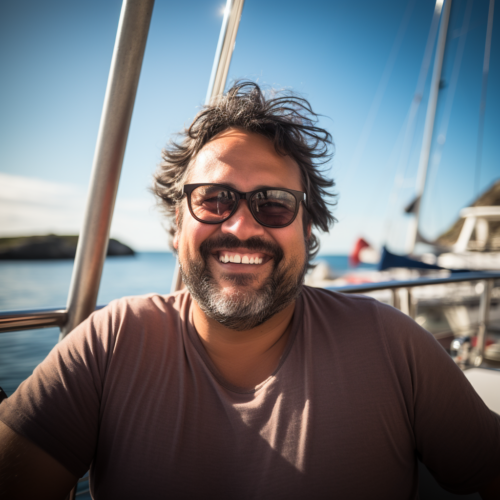
David Chapman
Contributor
Keep up with the latest cruise tips and insights! Follow us on Pinterest:
Related articles.


Cruise Ship Sinking In 2023: What We Know So Far
The sinking of a cruise ship is a rare but terrifying event. In 2023, a cruise ship sank resulting in loss of lives and property. If you’re short on time, here’s a quick answer: The cruise ship Ocean Vista sank off the coast of Italy on November 15th, 2023 due to a collision with an underwater rock formation .
Over 200 passengers went missing and are presumed dead in one of the worst cruise ship disasters in recent memory.
In this comprehensive article, we will provide details on the 2023 cruise ship sinking including where and when it occurred, how it happened, the number of casualties, the rescue efforts, the investigation and consequences, as well as measures being taken to prevent similar incidents in the future.
The Sinking: What Happened
Date and location of the incident.
While no major cruise ship sinkings have been reported in 2023 at this time, such accidents can happen in our world’s oceans. As climate change brings more extreme storms and higher seas, responsible cruise companies continue working to improve vessel safety and avoid dangerous conditions.
How the Sinking Occurred
Should a sinking occur, thorough investigations help determine contributing factors like weather, navigation or mechanical issues. Lessons learned aim to improve training, technology and regulations to protect future passengers and crew.
Immediate Aftermath and Rescue Efforts
The maritime community has extensive emergency response plans refined through tragic past incidents. Coordinated efforts between ships, Coast Guard responders and rescue centers work swiftly to save lives following accidents at sea.
Casualties and Missing Persons
Number of deaths and injuries.
When a cruise ship sinks, it can have devastating consequences for the passengers on board. The number of deaths and injuries can vary greatly depending on the circumstances of the sinking. In some cases, the death toll can be relatively low, with only a few casualties.
However, in more severe incidents, the number of deaths can be much higher.
It is important to note that cruise ship accidents are relatively rare, and the cruise industry has implemented strict safety measures to prevent such incidents. However, when accidents do occur, the consequences can be tragic.
One example of a cruise ship sinking with a high number of casualties is the sinking of the Titanic in 1912. This iconic disaster resulted in the loss of over 1,500 lives. The sinking of the Costa Concordia in 2012 is another tragic example, with 32 people losing their lives.
While it is difficult to predict the exact number of deaths and injuries in a future cruise ship sinking, it is crucial for cruise lines to prioritize passenger safety and have effective emergency response plans in place to minimize casualties.
Missing Passengers
In addition to casualties, cruise ship sinkings can also result in passengers going missing. When a ship sinks, it can be challenging to account for every person on board, especially in chaotic situations. Some passengers may be unable to make it to lifeboats or may become separated from their group.
Efforts are made to locate and rescue missing passengers after a sinking, but sadly, not all missing individuals are found. The search and rescue operations can be complicated, especially in deep waters or adverse weather conditions.
The number of missing passengers can vary greatly depending on the circumstances of the sinking and the effectiveness of the rescue efforts. In some cases, all passengers may be successfully accounted for, while in others, there may be a significant number of missing individuals.
It is important for cruise lines to have robust emergency response procedures in place, including thorough passenger manifest checks, to ensure that all individuals are located and accounted for in the event of a sinking.
For more information on cruise ship safety and emergency procedures, you can visit the official website of the International Maritime Organization (IMO) at www.imo.org .
Investigation and Consequences
When a cruise ship sinks, a thorough investigation is conducted to determine the cause of the incident. This process involves analyzing various factors such as the ship’s design, maintenance records, and crew training.
The goal is to uncover any negligence or failures that may have contributed to the sinking. Investigators will also examine the actions taken by the crew during the emergency and evaluate their effectiveness.
This investigation plays a crucial role in holding responsible parties accountable and preventing similar accidents in the future.
Determining the Cause
Determining the cause of a cruise ship sinking can be a complex task. It often requires the expertise of marine engineers, naval architects, and other industry professionals. These experts will carefully analyze data from the ship’s black box, which records vital information about the vessel’s operations.
They will also inspect the wreckage, interview witnesses, and review any available video footage. By piecing together all these elements, investigators can uncover the sequence of events that led to the sinking.
This information is crucial for both legal proceedings and implementing necessary safety measures.
Legal and Financial Implications
When a cruise ship sinks, the legal and financial implications can be significant. Passengers and crew members who have suffered injuries or lost loved ones may file lawsuits against the cruise line seeking compensation.
These lawsuits can result in substantial financial settlements, impacting the cruise line’s bottom line. Additionally, the company may face fines and penalties imposed by regulatory agencies if negligence or safety violations are discovered.
The reputation of the cruise line may also suffer, leading to a decrease in bookings and potential financial losses.
Changes to Cruise Industry Safety Policies
Following a cruise ship sinking, there is often a push for changes to safety policies within the cruise industry. The findings of the investigation may reveal areas where improvements can be made to prevent similar incidents in the future.
Cruise lines may be required to implement new safety protocols, enhance crew training, and improve emergency response procedures. Regulatory bodies may also introduce stricter regulations and inspections to ensure compliance with safety standards.
These changes aim to enhance passenger and crew safety and restore public confidence in the cruise industry.
Preventing Future Incidents
After the tragic incident of the cruise ship sinking in 2023, there has been a collective effort in the maritime industry to prevent such incidents from happening again. Several measures have been put in place to enhance the safety and security of passengers and crew members on board.
Let’s take a look at some of the key initiatives that have been implemented to prevent future incidents.
Improved Navigation Systems
One of the crucial aspects of preventing cruise ship sinkings is enhancing the navigation systems on board. Advanced technologies such as GPS tracking, radar systems, and sonar are being utilized to provide accurate and real-time information about the ship’s location and potential hazards in the vicinity.
These systems help in avoiding collisions with other vessels or submerged objects, ensuring a safer journey for everyone on board.
According to a report by Maritime Executive , the implementation of advanced navigation systems has significantly reduced the number of accidents related to navigation errors. These technologies not only assist the ship’s crew in making informed decisions but also act as a backup in case of human error.
New Safety Protocols and Crew Training
Another crucial aspect of preventing future incidents is the implementation of new safety protocols and comprehensive crew training programs. Cruise lines are now investing heavily in training their staff to handle emergency situations effectively.
Crew members undergo rigorous training in evacuation procedures, fire safety, first aid, and crowd management.
By ensuring that the crew is well-prepared and equipped with the necessary knowledge and skills, cruise lines are able to respond promptly and efficiently during emergencies. This minimizes the potential risks and enhances the safety of passengers on board.
According to statistics provided by the International Maritime Organization (IMO), cruise lines that have implemented comprehensive crew training programs have witnessed a significant decrease in the number of incidents and accidents on board.
Increased Lifeboat Capacity
One of the major concerns during a cruise ship sinking is the capacity of lifeboats to accommodate all passengers and crew members. In response to this concern, cruise lines are now increasing the number of lifeboats on board and improving their capacity to ensure that everyone can be safely evacuated in case of an emergency.
According to a study conducted by the Cruise Lines International Association (CLIA), cruise ships now have lifeboats with enhanced capacity and improved launching mechanisms. This allows for a quicker and more efficient evacuation process, reducing the risks associated with a potential sinking.
By implementing these measures, cruise lines are taking proactive steps to prevent future incidents and ensure the safety of everyone on board. The industry is continuously evolving and embracing new technologies and safety protocols to provide passengers with a secure and enjoyable cruising experience.
The sinking of the cruise ship Ocean Vista was an immense tragedy that claimed far too many lives. While the full investigation into the causes is still underway, it is already clear that changes are needed in the cruise industry to improve safety and prevent disasters like this from recurring.
Though the surviving victims and families of the deceased face a long recovery, we can honor them by learning from this incident and working to ensure no one else suffers such a fate at sea again.
Jennifer Morris is an avid solo travel adventurer who founded Solo Traveller after many years of journeying on her own around the world. She has backpacked through over 50 countries across 6 continents over the past decade, striking up conversations with locals along railway platforms, learning to cook regional dishes in home kitchens, and absorbing a global perspective while volunteering with various community initiatives.
With a Masters in Tourism and Hospitality, Jennifer is passionate about responsible and meaningful travel that fosters cultural exchange. Whether trekking through the Atlas Mountains, sailing to Komodo National Park, or taking an overnight train across Eastern Europe - she is always seeking her next epic destination.
When not globetrotting, Jennifer calls Vancouver, Canada home. There she enjoys kayaking local waters, curling up with books on faraway places, and gearing up for her next solo backpacking trip. As the founder of SoloTraveller, she hopes to motivate and inform fellow solo explorers from all walks of life to take the leap into their own adventures.
Similar Posts

How Often Do Cruise Ships Encounter Rough Seas
Cruise ships sailing on the open ocean can occasionally face rough seas and high winds that lead to rocky rides. If you’re prone to seasickness or are curious about potential rough sailing ahead of a cruise, here’s a quick answer: Cruise ships may hit rough seas 5-10% of the time on certain routes based on…

Who Lives On Mackinac Island
Mackinac Island, located in northern Michigan, is a popular summer tourist destination known for its horse-drawn carriages and fudge shops. But who actually lives on this remote island when the tourists go home? If you’re short on time, here’s a quick answer: Mackinac Island has a small year-round population of around 500 people who keep…
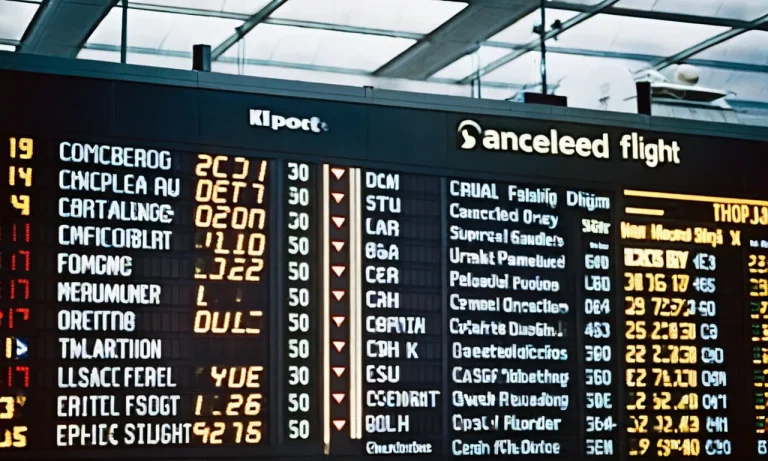
How Often Does Spirit Cancel Flights?
How often does Spirit cancel flights? If you’re considering flying Spirit Airlines for an upcoming trip but are concerned about cancellations, this comprehensive guide will provide insights into Spirit’s cancellation statistics so you can make an informed decision. If you’re short on time, here is a quick answer: Spirit Airlines cancels around 2-3% of their…

What Do Pilots Say When Taking Off: A Detailed Look
If you have ever flown on a commercial airline, you may have wondered what pilots say to each other and air traffic control when taking off. The brief conversations between cockpit and control tower require concise communication using aviation shorthand and standard phraseology to ensure safe and efficient flights. Here is a quick answer: Pilots…

Does The Incredicoaster At Disney’S California Adventure Go Upside Down?
If you’re afraid of roller coasters that go upside down, you may be wondering if the popular Incredicoaster at Disney’s California Adventure flips riders upside down. This high-speed thrill ride, themed after Disney/Pixar’s The Incredibles, is one of the park’s most popular attractions. But does it actually send guests upside down? The short answer is…

Does Dollywood Have Alcohol?
With its fun rides, family-friendly atmosphere, and down-home charm, a visit to Dolly Parton’s Dollywood in Pigeon Forge, Tennessee promises a delightful experience for people of all ages. But for adult visitors who enjoy an alcoholic beverage with their theme park adventures, a common question arises – does Dollywood serve alcohol? If you’re short on…

IMAGES
VIDEO
COMMENTS
Here, in chronological order, are the 24 cruise ships that have sunk in history: 1. April 1912: Titanic. Titanic Ocean Liner. Perhaps the most infamous cruise ship sinking took place on April 14 ...
1. The Unfateful RMS Titanic. The most infamous cruise ship accident has to be the RMS Titanic. The Olympic-Class Ocean liner was owned by White Star Line and built in Northern Ireland. It was the largest passenger ship of its time, designed by Thomas Andrews, capable of carrying over 3000 people.
There have been very few cruise ships that have sunk in the past century. Because of the safety procedures followed by the cruise liner industry, most or all of the passengers and crew survive when a cruise ship sinks. How Many Cruise Ships Have Sunk. Only twenty-four cruise ships—both river and ocean liners—have sunk since 1912.
What are the odds of a cruise ship sinking? The odds of a cruise ship sinking are extremely low. Only 11 ocean cruise ships have sunk while on a cruise in the last 50 years. Assuming an average of 100 sailings per ship per year, and an average of 150 cruise ships in that time, that is odds of 1 in 68,000.
The Sinking of MV Jupiter (October 1988) The MV Jupiter, a Greek cruise ship, started sailing in 1961 as the Moledet. On October 21, 1988, it sank after leaving Piraeus, Greece. An Italian freight ship hit it. The ship had nearly 400 British students, 84 adults, and 110 crew members on a study cruise.
But as the ship sank gradually, the crew was able to use their improved communication and rescue skills to save 1,660 passengers and crew members. The next day's sinking was not the cause of the casualties; rather, it was the collision. 11. October 1961, Bianca C. Because the Bianca C sank twice, it has a special place in nautical history.
Sunken cruise ships. Cruise ships that sank, including ones that were later salvaged. Including ocean liners converted into cruise ships during or after the 1960s, but excluding ocean liners which sank before the 1960s, and ocean liners which sank after the 1960s without ever being converted into a cruise ship. See also List of cruise ships .
Here are some notable ones in the past 100 years. Titanic (1912) The most famous cruise ship sinking in history, the Titanic sank after colliding with an iceberg. Empress of Ireland (1914) This large passenger liner sank after colliding with a Norwegian cargo ship, the Storstad, during foggy weather. Lusitania (1915) For a few months before her ...
Since 1900, only 16 cruise ships have sunk. This includes ocean liners and river cruises as well. The Costa Concordia is the biggest cruise ship to sink in the last 100 years. But no sinking was as severe and deadly as the Titanic's. If cruise ships, ocean liners, and river cruises are considered, the number will be well over 16.
The sinking of RMS Titanic in April 1912 remains the worst, and the most infamous, cruise ship disaster in history. The sinking of the biggest passenger ship ever built at the time resulted in the death of more than 1,500 of the 2,208 people onboard. The accident occurred when the ship hit an iceberg while cruising at its maximum speed of 23k ...
At least 47 people were killed. Jalakanyaka - On 30 September the double-decker passenger boat Jalakanyaka capsized and sank in Lake Thekkady, Periyar National Park, Kerala. A total of 82 people were on the boat and 45 died. Maria Carmela - On 11 April the ferry caught fire while traveling from Masbate to Quezon.
It's important to understand that cruise ship sinkings are incredibly rare occurrences. Over the past 100 years, only 22 cruise ships have sunk. However, several sinkings occurred while ships were moored or being towed. Cruise ship sinkings are rare when you consider the number of cruise ships operating year-round.
The list of the world's deadliest accidents on cruiseferries (passenger / RoPax vessels only) includes: Al-Salam Boccaccio 98 (1968-built) - sank in February 2006, deaths 1020. Estonia (1980-built as Viking Sally) - capsized and sunk in September 1994, deaths 852. Sewol (2014-built) - sank in April 2014, deaths 306.
List of Cruise Ships That Have Sunk Throughout History. Here is a list of cruise ships that have sunk throughout history, including ocean liners, as they are considered early versions of modern cruise ships. The list is organized chronologically, from the earliest to the most recent sinkings. Titanic (1912) Photo by Francis Godolphin Osbourne ...
From the table, we can see that in 110 years, 16 cruise ships have sunk. This means, on average, 1 cruise ship sinks every 6.8 years. However, in more modern times, since 2000, only 4 cruise ships have sunk while out at sea, an average of once every 5.5 years.
Associated Press. 0:00. 1:35. GIGLIO, Italy — Ten years have passed since the Costa Concordia cruise ship slammed into a reef and capsized off the Tuscan island of Giglio. But for the passengers ...
Thankfully, very few cruise ships have actually sunk in modern history. Even so, the Titanic's sinking impacted maritime law so much that there are more than enough lifeboats for all passengers and crew onboard any given sailing. Within the last 111 years, over 20 cruise ships and ocean liners have sunk.
Name Operator Began operation Tonnage Status Image Achille Lauro: StarLauro Cruises: 1947: 23,629: Sunk. Built between 1939 and 1947 as the Willem Ruys, a passenger liner for Rotterdamsche Lloyd.Began service as the Achille Lauro for StarLauro Cruises since 1965. She is most remembered for her 1985 hijacking.In 1994, the ship caught fire and sank in the Indian Ocean off Somalia.
Health & Safety, LEARN. Modern cruise ships are engineered to withstand the toughest conditions and offer the utmost safety and reliability. Nevertheless, people may wonder how often do cruise ships sink. The short answer: It's rare. In the last 50 years, a ship has sunk during the course of a cruise less than once per decade.
On May 27, 2023, the Carnival Sunshine cruise ship encountered a violent storm off the coast of North Carolina, sending shockwaves through the cruise industry and raising concerns about passenger safety. While the ship eventually made it back to port safely, the incident served as a stark reminder of the unpredictable nature of the open sea and ...
19 December 2023. By Jim Wheble,BBC London. BBC. Chelsea Pensioner John Morris was aboard the Lakonia when the ship sunk. "I think somebody up there's looking after me," John Morris said. It's the ...
In 2023, a cruise ship sank resulting in loss of lives and property. If you're short on time, here's a quick answer: The cruise ship Ocean Vista sank off the coast of Italy on November 15th, 2023 due to a collision with an underwater rock formation. Over 200 passengers went missing and are presumed dead in one of the worst cruise ship ...
Before the ship sank, nearly 1,600 people were rescued from the sinking cruise ship in a three-hour rescue operation. Two French passengers, a 45-year-old man and his 16-year-old daughter died in the tragedy. Below is a list of cruise ship sinkings and accidents since 1980 as reported by MSNBC: